Quick filters:
The wheatstone telegraph Stock Photos and Images
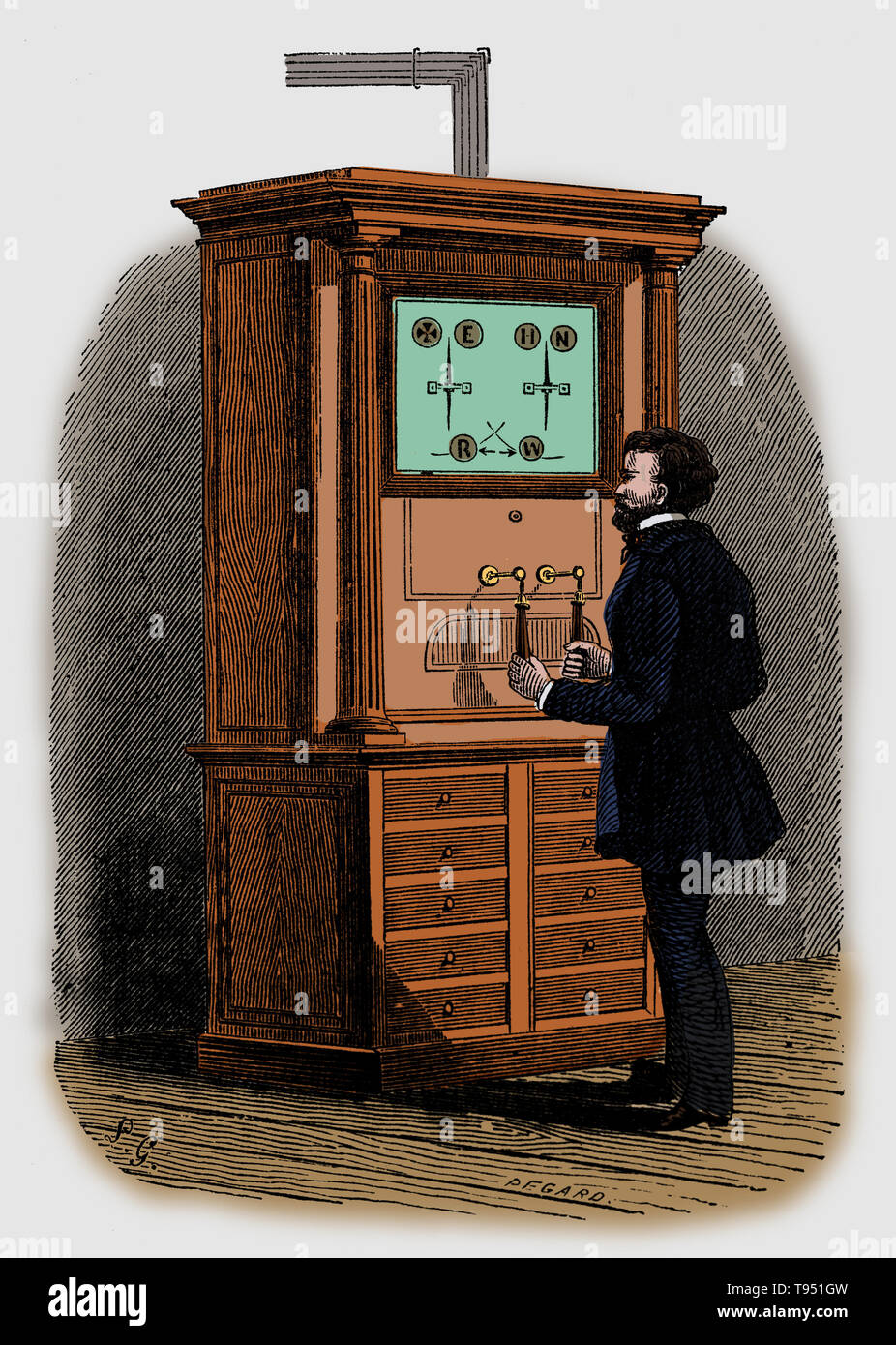 The Cooke and Wheatstone telegraph was an early electrical telegraph system invented by English inventors William Fothergill Cooke and Charles Wheatstone. The receiver consisted of a number of needles which could be moved by electromagnetic coils to point to letters on a board. This feature was liked by early users who were unwilling to learn codes, and employers who did not want to invest in staff training. The two-needle telegraph required three wires, one for each needle and a common return. Stock Photohttps://www.alamy.com/image-license-details/?v=1https://www.alamy.com/the-cooke-and-wheatstone-telegraph-was-an-early-electrical-telegraph-system-invented-by-english-inventors-william-fothergill-cooke-and-charles-wheatstone-the-receiver-consisted-of-a-number-of-needles-which-could-be-moved-by-electromagnetic-coils-to-point-to-letters-on-a-board-this-feature-was-liked-by-early-users-who-were-unwilling-to-learn-codes-and-employers-who-did-not-want-to-invest-in-staff-training-the-two-needle-telegraph-required-three-wires-one-for-each-needle-and-a-common-return-image246588073.html
The Cooke and Wheatstone telegraph was an early electrical telegraph system invented by English inventors William Fothergill Cooke and Charles Wheatstone. The receiver consisted of a number of needles which could be moved by electromagnetic coils to point to letters on a board. This feature was liked by early users who were unwilling to learn codes, and employers who did not want to invest in staff training. The two-needle telegraph required three wires, one for each needle and a common return. Stock Photohttps://www.alamy.com/image-license-details/?v=1https://www.alamy.com/the-cooke-and-wheatstone-telegraph-was-an-early-electrical-telegraph-system-invented-by-english-inventors-william-fothergill-cooke-and-charles-wheatstone-the-receiver-consisted-of-a-number-of-needles-which-could-be-moved-by-electromagnetic-coils-to-point-to-letters-on-a-board-this-feature-was-liked-by-early-users-who-were-unwilling-to-learn-codes-and-employers-who-did-not-want-to-invest-in-staff-training-the-two-needle-telegraph-required-three-wires-one-for-each-needle-and-a-common-return-image246588073.htmlRMT951GW–The Cooke and Wheatstone telegraph was an early electrical telegraph system invented by English inventors William Fothergill Cooke and Charles Wheatstone. The receiver consisted of a number of needles which could be moved by electromagnetic coils to point to letters on a board. This feature was liked by early users who were unwilling to learn codes, and employers who did not want to invest in staff training. The two-needle telegraph required three wires, one for each needle and a common return.
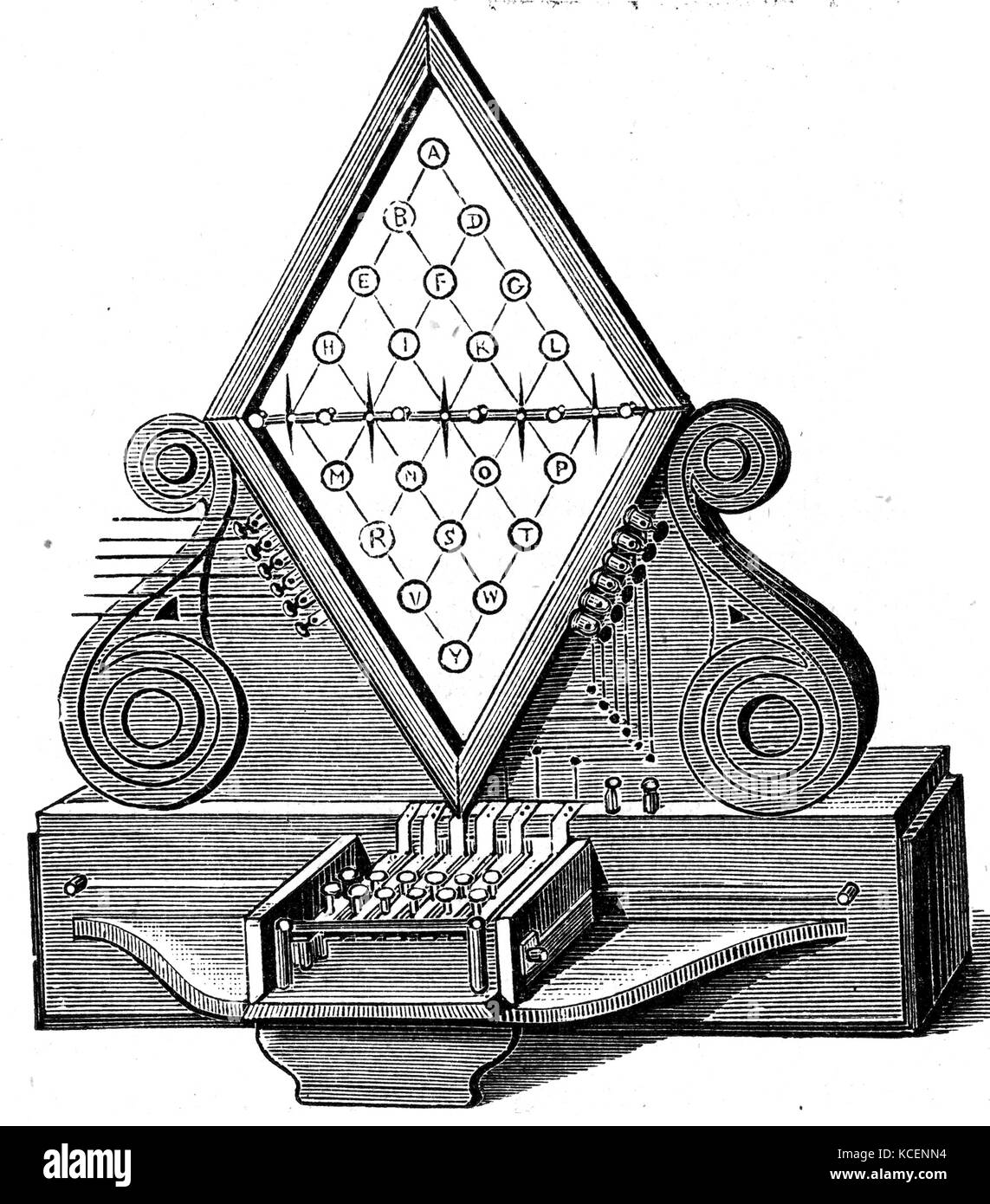 Illustration of the 'Cooke and Wheatstone Telegraph' an early electrical telegraph system created by William Fothergill Cooke (1806-1879) and Charles Wheatstone (1802-1875) English scientists. Dated 19th Century Stock Photohttps://www.alamy.com/image-license-details/?v=1https://www.alamy.com/stock-image-illustration-of-the-cooke-and-wheatstone-telegraph-an-early-electrical-162593568.html
Illustration of the 'Cooke and Wheatstone Telegraph' an early electrical telegraph system created by William Fothergill Cooke (1806-1879) and Charles Wheatstone (1802-1875) English scientists. Dated 19th Century Stock Photohttps://www.alamy.com/image-license-details/?v=1https://www.alamy.com/stock-image-illustration-of-the-cooke-and-wheatstone-telegraph-an-early-electrical-162593568.htmlRMKCENN4–Illustration of the 'Cooke and Wheatstone Telegraph' an early electrical telegraph system created by William Fothergill Cooke (1806-1879) and Charles Wheatstone (1802-1875) English scientists. Dated 19th Century
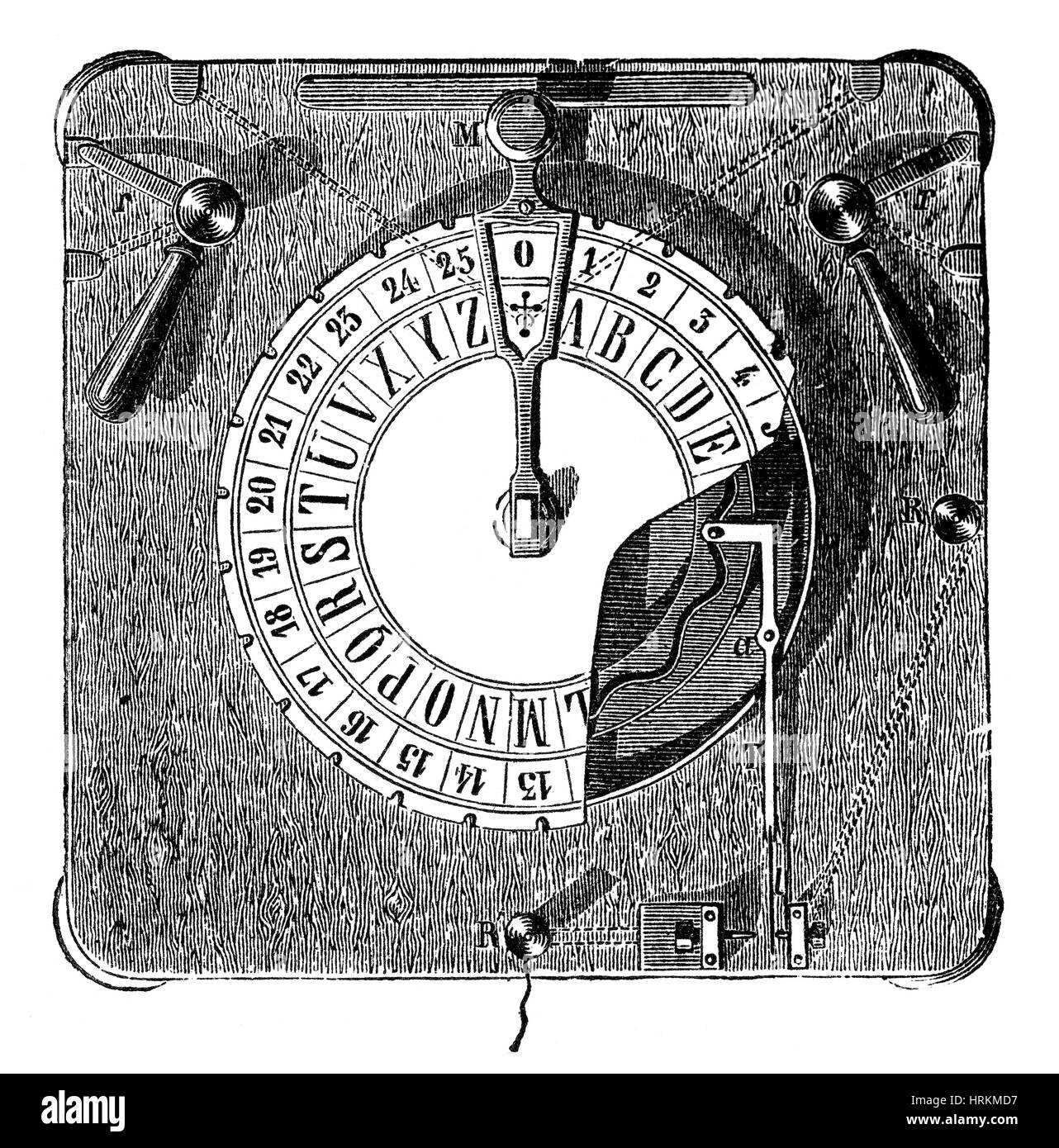 Cooke and Wheatstone Telegraph Dial, 1830s Stock Photohttps://www.alamy.com/image-license-details/?v=1https://www.alamy.com/stock-photo-cooke-and-wheatstone-telegraph-dial-1830s-135042803.html
Cooke and Wheatstone Telegraph Dial, 1830s Stock Photohttps://www.alamy.com/image-license-details/?v=1https://www.alamy.com/stock-photo-cooke-and-wheatstone-telegraph-dial-1830s-135042803.htmlRMHRKMD7–Cooke and Wheatstone Telegraph Dial, 1830s
 Magnetism and electromagnetism, showing dip needle, compass, etc., and lifting power of electromagnet (12), Wheatstone telegraph (13), Morse telegraph (16). From educational plate published Wurtemberg c1850. Stock Photohttps://www.alamy.com/image-license-details/?v=1https://www.alamy.com/stock-photo-magnetism-and-electromagnetism-showing-dip-needle-compass-etc-and-57309560.html
Magnetism and electromagnetism, showing dip needle, compass, etc., and lifting power of electromagnet (12), Wheatstone telegraph (13), Morse telegraph (16). From educational plate published Wurtemberg c1850. Stock Photohttps://www.alamy.com/image-license-details/?v=1https://www.alamy.com/stock-photo-magnetism-and-electromagnetism-showing-dip-needle-compass-etc-and-57309560.htmlRMD96JX0–Magnetism and electromagnetism, showing dip needle, compass, etc., and lifting power of electromagnet (12), Wheatstone telegraph (13), Morse telegraph (16). From educational plate published Wurtemberg c1850.
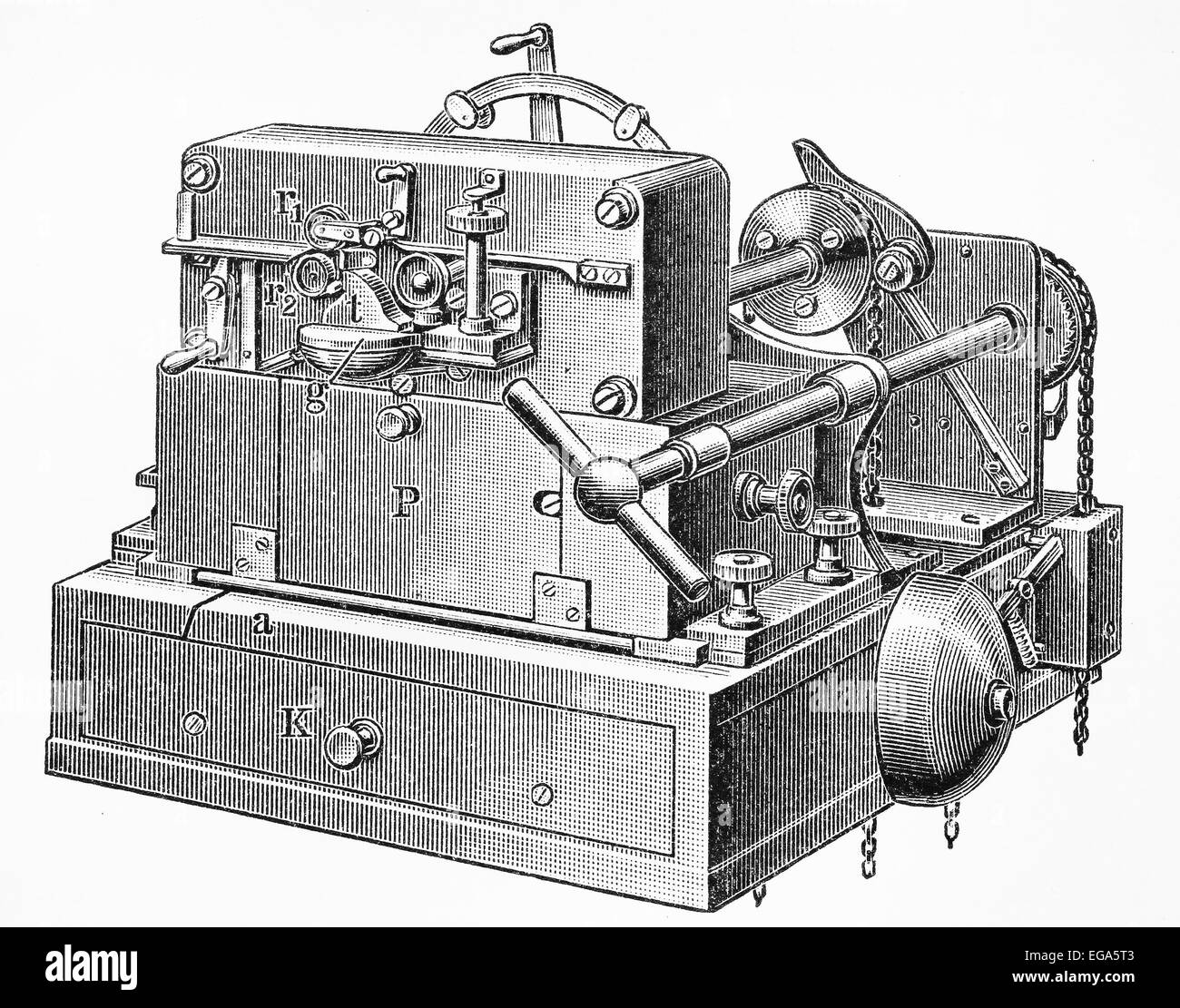 Vintage 19th century old drawing of a Wheatstone telegraph receiver Stock Photohttps://www.alamy.com/image-license-details/?v=1https://www.alamy.com/stock-photo-vintage-19th-century-old-drawing-of-a-wheatstone-telegraph-receiver-78900083.html
Vintage 19th century old drawing of a Wheatstone telegraph receiver Stock Photohttps://www.alamy.com/image-license-details/?v=1https://www.alamy.com/stock-photo-vintage-19th-century-old-drawing-of-a-wheatstone-telegraph-receiver-78900083.htmlRFEGA5T3–Vintage 19th century old drawing of a Wheatstone telegraph receiver
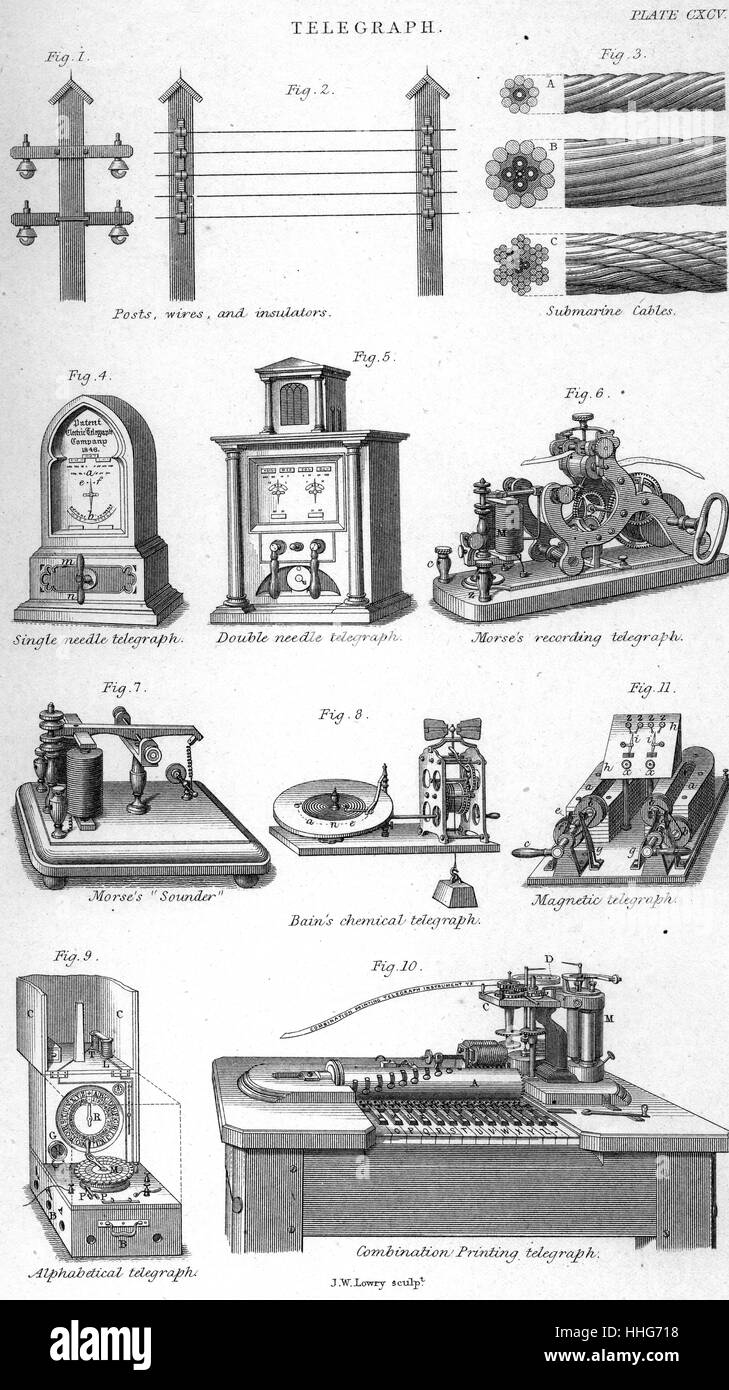 ELECTRIC TELEGRAPH; Including Cooke and Wheatstone single and double needle instruments (Figs 4 & 5). Sounder (Fig 7) for Morse telegraph which enabled signal to be 'read' aurally; dispersing with taped messages. Wheatstone's Alphabetical Telegraph (Fig 9). Combination Printing Telegraph (Fig 10) in which A.A. Lovett brought together the best features of the House and Hughes telegraphs: 1859. Stock Photohttps://www.alamy.com/image-license-details/?v=1https://www.alamy.com/stock-photo-electric-telegraph-including-cooke-and-wheatstone-single-and-double-131278484.html
ELECTRIC TELEGRAPH; Including Cooke and Wheatstone single and double needle instruments (Figs 4 & 5). Sounder (Fig 7) for Morse telegraph which enabled signal to be 'read' aurally; dispersing with taped messages. Wheatstone's Alphabetical Telegraph (Fig 9). Combination Printing Telegraph (Fig 10) in which A.A. Lovett brought together the best features of the House and Hughes telegraphs: 1859. Stock Photohttps://www.alamy.com/image-license-details/?v=1https://www.alamy.com/stock-photo-electric-telegraph-including-cooke-and-wheatstone-single-and-double-131278484.htmlRMHHG718–ELECTRIC TELEGRAPH; Including Cooke and Wheatstone single and double needle instruments (Figs 4 & 5). Sounder (Fig 7) for Morse telegraph which enabled signal to be 'read' aurally; dispersing with taped messages. Wheatstone's Alphabetical Telegraph (Fig 9). Combination Printing Telegraph (Fig 10) in which A.A. Lovett brought together the best features of the House and Hughes telegraphs: 1859.
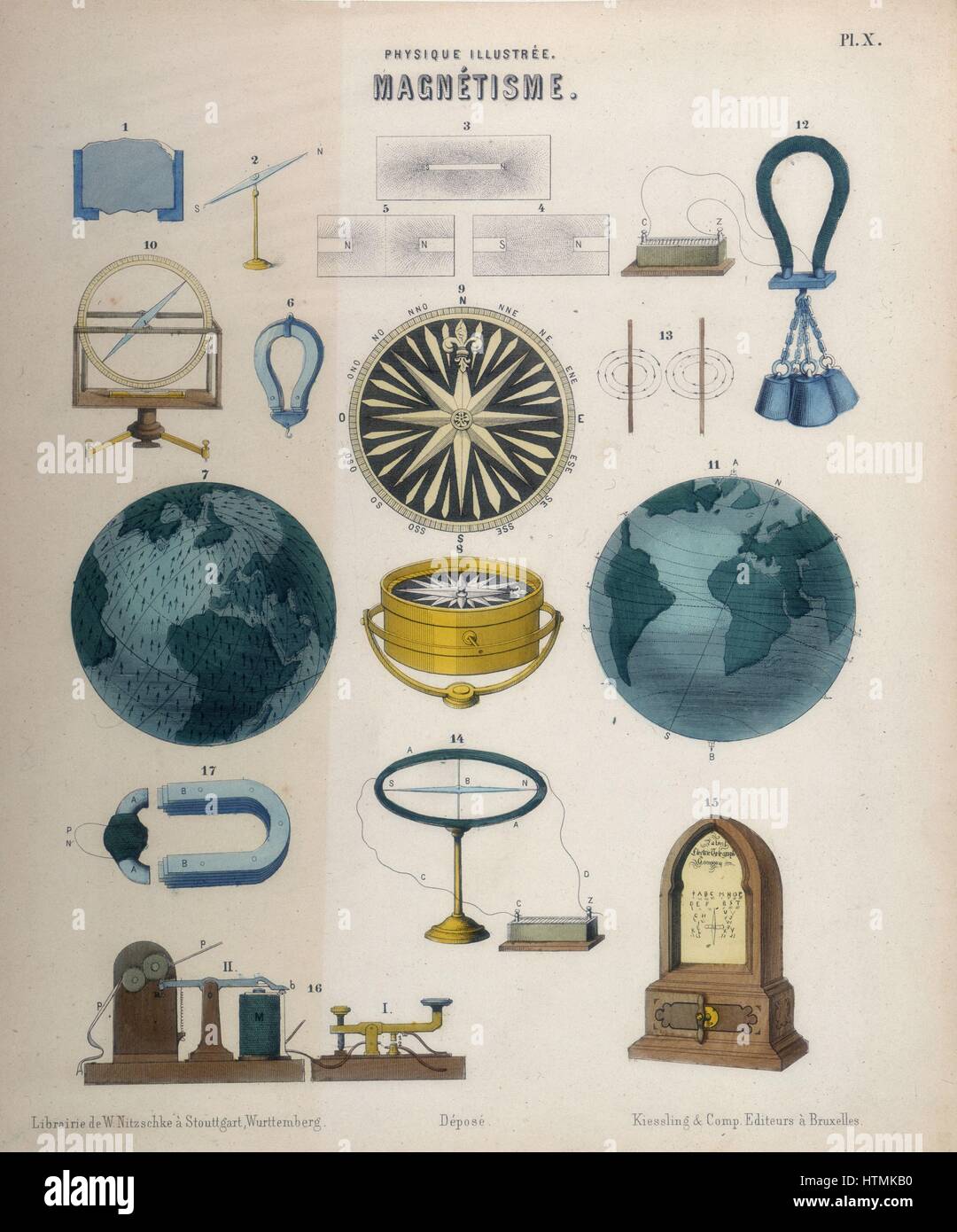 Magnetism and electromagnetism, showing dip needle, compass, etc., and lifting power of electromagnet (12), Wheatstone telegraph (13), Morse telegraph (16). From educational plate published Wurtemberg c1850 Stock Photohttps://www.alamy.com/image-license-details/?v=1https://www.alamy.com/stock-photo-magnetism-and-electromagnetism-showing-dip-needle-compass-etc-and-135678564.html
Magnetism and electromagnetism, showing dip needle, compass, etc., and lifting power of electromagnet (12), Wheatstone telegraph (13), Morse telegraph (16). From educational plate published Wurtemberg c1850 Stock Photohttps://www.alamy.com/image-license-details/?v=1https://www.alamy.com/stock-photo-magnetism-and-electromagnetism-showing-dip-needle-compass-etc-and-135678564.htmlRMHTMKB0–Magnetism and electromagnetism, showing dip needle, compass, etc., and lifting power of electromagnet (12), Wheatstone telegraph (13), Morse telegraph (16). From educational plate published Wurtemberg c1850
 Charles Wheatstone (1802-1875) British physicist. Electrical resistances. Electric telegraph. Concertina Stock Photohttps://www.alamy.com/image-license-details/?v=1https://www.alamy.com/stock-photo-charles-wheatstone-1802-1875-british-physicist-electrical-resistances-57309819.html
Charles Wheatstone (1802-1875) British physicist. Electrical resistances. Electric telegraph. Concertina Stock Photohttps://www.alamy.com/image-license-details/?v=1https://www.alamy.com/stock-photo-charles-wheatstone-1802-1875-british-physicist-electrical-resistances-57309819.htmlRMD96K77–Charles Wheatstone (1802-1875) British physicist. Electrical resistances. Electric telegraph. Concertina
 Interior room of the Electric Telegraph Office at Charing Cross, London. British telegraph equipment was based on the Stock Photohttps://www.alamy.com/image-license-details/?v=1https://www.alamy.com/stock-photo-interior-room-of-the-electric-telegraph-office-at-charing-cross-london-50051086.html
Interior room of the Electric Telegraph Office at Charing Cross, London. British telegraph equipment was based on the Stock Photohttps://www.alamy.com/image-license-details/?v=1https://www.alamy.com/stock-photo-interior-room-of-the-electric-telegraph-office-at-charing-cross-london-50051086.htmlRMCWC0JP–Interior room of the Electric Telegraph Office at Charing Cross, London. British telegraph equipment was based on the
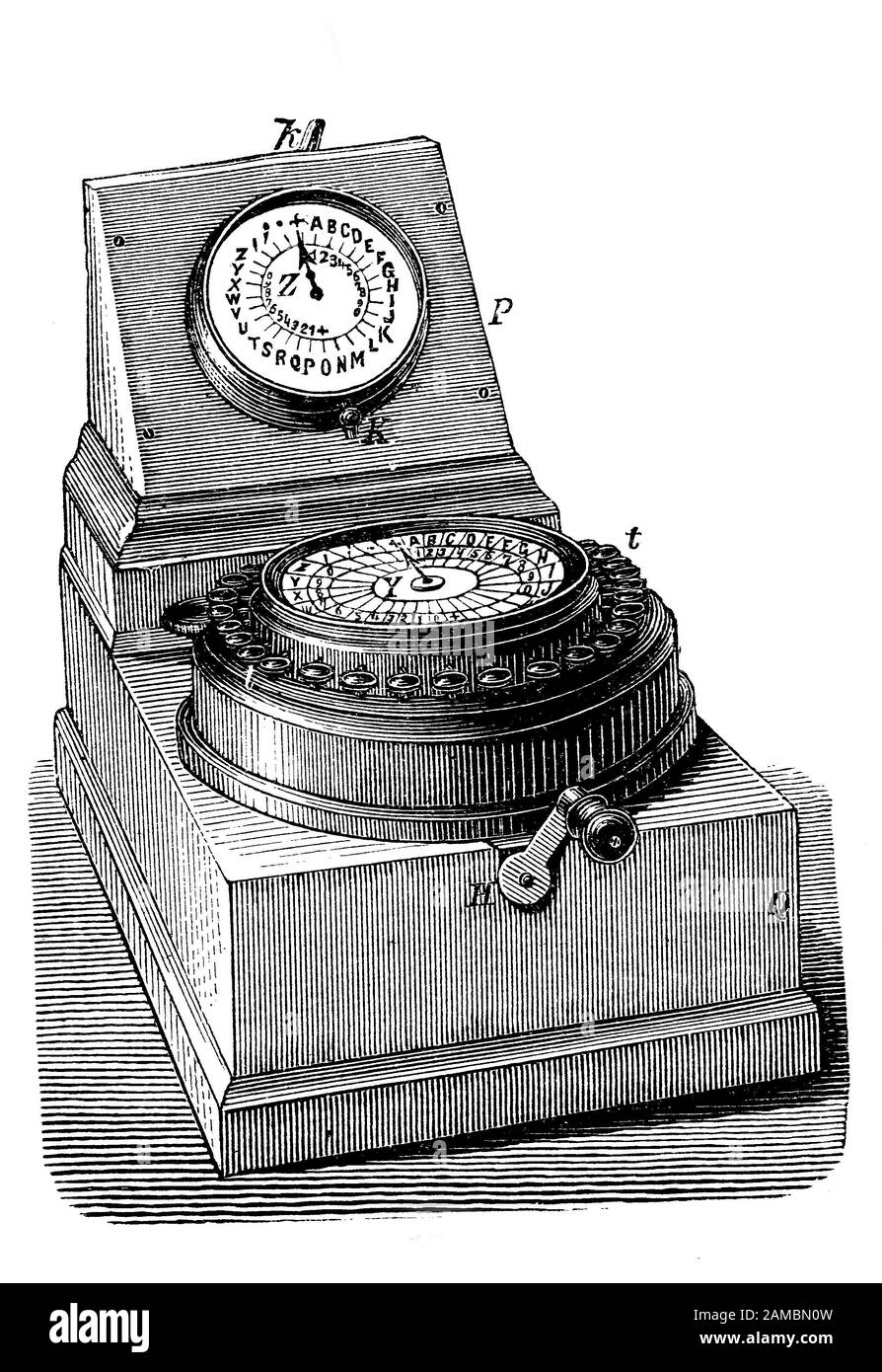 a needle telegraph produced by Charles Wheatstone / ein Zeigertelegraf von Charles Wheatstone, Historisch, digital improved reproduction of an original from the 19th century / digitale Reproduktion einer Originalvorlage aus dem 19. Jahrhundert, Stock Photohttps://www.alamy.com/image-license-details/?v=1https://www.alamy.com/a-needle-telegraph-produced-by-charles-wheatstone-ein-zeigertelegraf-von-charles-wheatstone-historisch-digital-improved-reproduction-of-an-original-from-the-19th-century-digitale-reproduktion-einer-originalvorlage-aus-dem-19-jahrhundert-image339548073.html
a needle telegraph produced by Charles Wheatstone / ein Zeigertelegraf von Charles Wheatstone, Historisch, digital improved reproduction of an original from the 19th century / digitale Reproduktion einer Originalvorlage aus dem 19. Jahrhundert, Stock Photohttps://www.alamy.com/image-license-details/?v=1https://www.alamy.com/a-needle-telegraph-produced-by-charles-wheatstone-ein-zeigertelegraf-von-charles-wheatstone-historisch-digital-improved-reproduction-of-an-original-from-the-19th-century-digitale-reproduktion-einer-originalvorlage-aus-dem-19-jahrhundert-image339548073.htmlRF2AMBN0W–a needle telegraph produced by Charles Wheatstone / ein Zeigertelegraf von Charles Wheatstone, Historisch, digital improved reproduction of an original from the 19th century / digitale Reproduktion einer Originalvorlage aus dem 19. Jahrhundert,
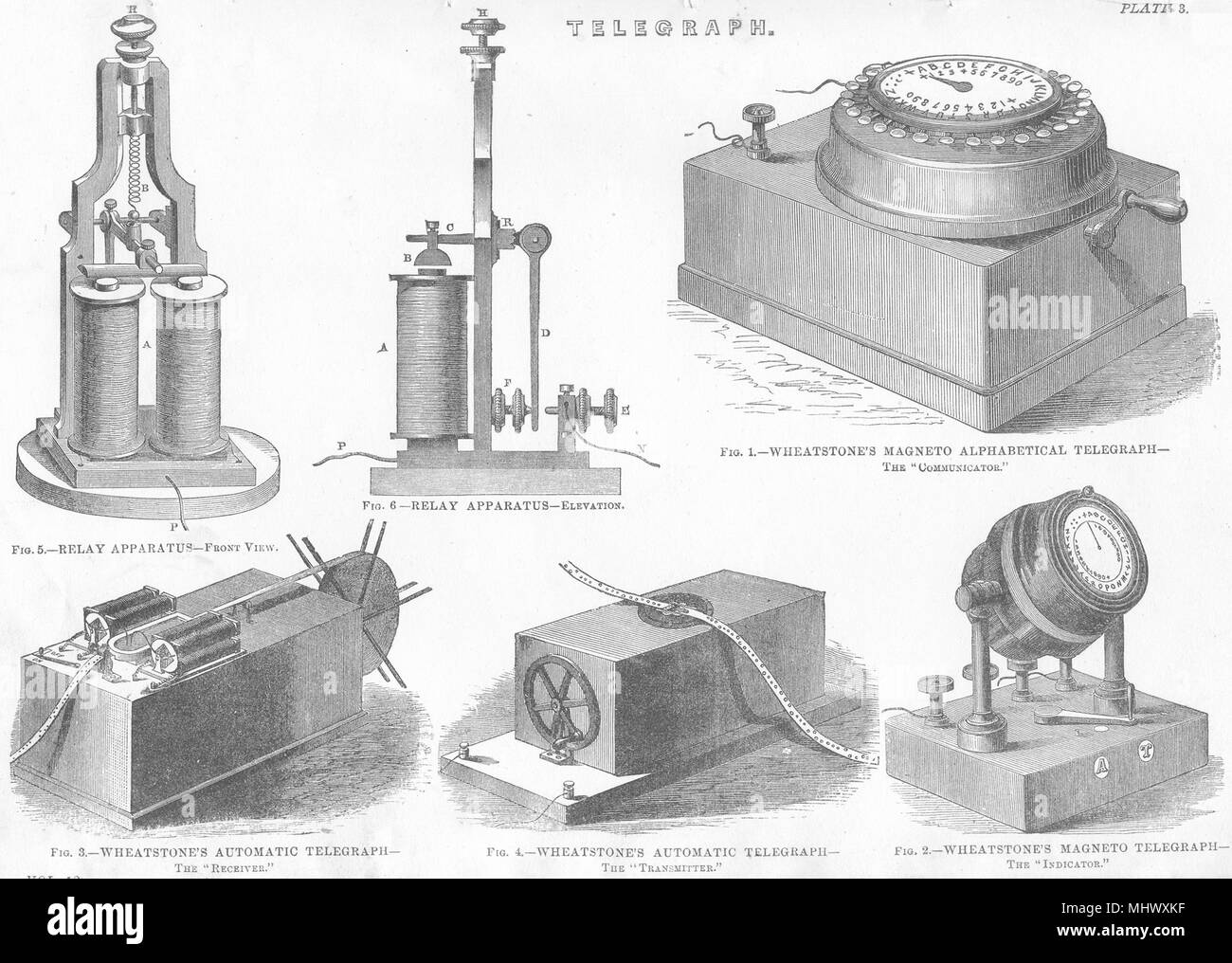 WHEATSTONE MAGNETO ALPHABETICAL TELEGRAPH.Communicator;Receiver;Transmitter 1880 Stock Photohttps://www.alamy.com/image-license-details/?v=1https://www.alamy.com/wheatstone-magneto-alphabetical-telegraphcommunicatorreceivertransmitter-1880-image183122563.html
WHEATSTONE MAGNETO ALPHABETICAL TELEGRAPH.Communicator;Receiver;Transmitter 1880 Stock Photohttps://www.alamy.com/image-license-details/?v=1https://www.alamy.com/wheatstone-magneto-alphabetical-telegraphcommunicatorreceivertransmitter-1880-image183122563.htmlRFMHWXKF–WHEATSTONE MAGNETO ALPHABETICAL TELEGRAPH.Communicator;Receiver;Transmitter 1880
 Vintage technology: detail of Wheatstone pointer telegraph from 1839 with a pointer indicating the transmitted letter from a mechanism of electrically driven needles Stock Photohttps://www.alamy.com/image-license-details/?v=1https://www.alamy.com/vintage-technology-detail-of-wheatstone-pointer-telegraph-from-1839-with-a-pointer-indicating-the-transmitted-letter-from-a-mechanism-of-electrically-driven-needles-image382416119.html
Vintage technology: detail of Wheatstone pointer telegraph from 1839 with a pointer indicating the transmitted letter from a mechanism of electrically driven needles Stock Photohttps://www.alamy.com/image-license-details/?v=1https://www.alamy.com/vintage-technology-detail-of-wheatstone-pointer-telegraph-from-1839-with-a-pointer-indicating-the-transmitted-letter-from-a-mechanism-of-electrically-driven-needles-image382416119.htmlRF2D64FJF–Vintage technology: detail of Wheatstone pointer telegraph from 1839 with a pointer indicating the transmitted letter from a mechanism of electrically driven needles
 Cook and Wheatstone's 5-needle telegraph, 1837 (1915). Artist: Unknown Stock Photohttps://www.alamy.com/image-license-details/?v=1https://www.alamy.com/cook-and-wheatstones-5-needle-telegraph-1837-1915-artist-unknown-image8382849.html
Cook and Wheatstone's 5-needle telegraph, 1837 (1915). Artist: Unknown Stock Photohttps://www.alamy.com/image-license-details/?v=1https://www.alamy.com/cook-and-wheatstones-5-needle-telegraph-1837-1915-artist-unknown-image8382849.htmlRMAJ9YM2–Cook and Wheatstone's 5-needle telegraph, 1837 (1915). Artist: Unknown
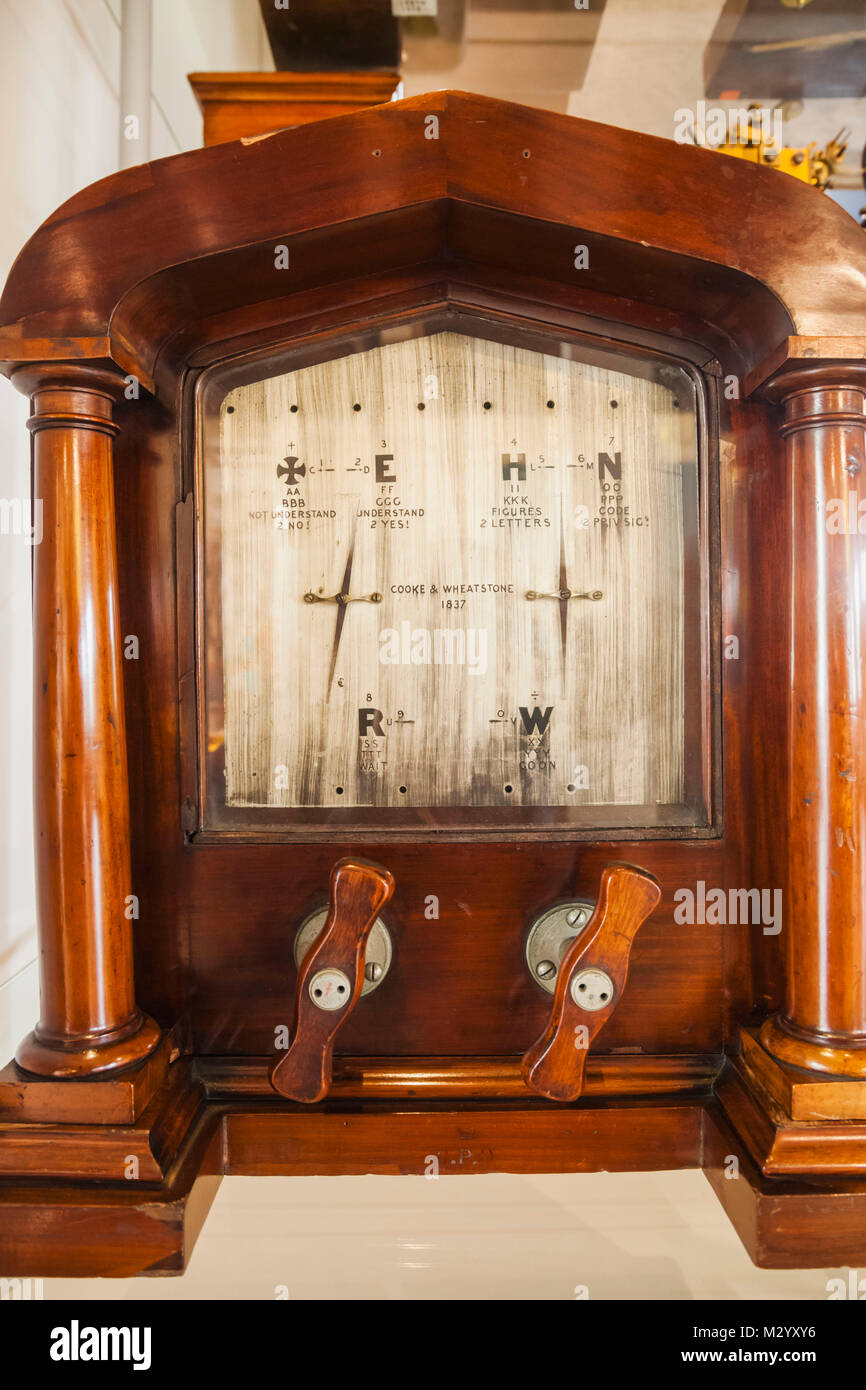 England, Cooke & Wheatstone Double-Needle Telegraph Machine dated 1844 Stock Photohttps://www.alamy.com/image-license-details/?v=1https://www.alamy.com/stock-photo-england-cooke-wheatstone-double-needle-telegraph-machine-dated-1844-173946842.html
England, Cooke & Wheatstone Double-Needle Telegraph Machine dated 1844 Stock Photohttps://www.alamy.com/image-license-details/?v=1https://www.alamy.com/stock-photo-england-cooke-wheatstone-double-needle-telegraph-machine-dated-1844-173946842.htmlRMM2YXY6–England, Cooke & Wheatstone Double-Needle Telegraph Machine dated 1844
 Opening of the London to Paris telegraph link, 1852. Artist: Unknown Stock Photohttps://www.alamy.com/image-license-details/?v=1https://www.alamy.com/opening-of-the-london-to-paris-telegraph-link-1852-artist-unknown-image8383005.html
Opening of the London to Paris telegraph link, 1852. Artist: Unknown Stock Photohttps://www.alamy.com/image-license-details/?v=1https://www.alamy.com/opening-of-the-london-to-paris-telegraph-link-1852-artist-unknown-image8383005.htmlRMAJA0HE–Opening of the London to Paris telegraph link, 1852. Artist: Unknown
 Telegraph, Zeigertelegraf produced by Charles Wheatstone, 1880, historical woodcut, Germany Stock Photohttps://www.alamy.com/image-license-details/?v=1https://www.alamy.com/telegraph-zeigertelegraf-produced-by-charles-wheatstone-1880-historical-woodcut-germany-image243319796.html
Telegraph, Zeigertelegraf produced by Charles Wheatstone, 1880, historical woodcut, Germany Stock Photohttps://www.alamy.com/image-license-details/?v=1https://www.alamy.com/telegraph-zeigertelegraf-produced-by-charles-wheatstone-1880-historical-woodcut-germany-image243319796.htmlRMT3T4TM–Telegraph, Zeigertelegraf produced by Charles Wheatstone, 1880, historical woodcut, Germany
 Charles Wheatstone (1802-1875), British physicist, 1882. Artist: Unknown Stock Photohttps://www.alamy.com/image-license-details/?v=1https://www.alamy.com/charles-wheatstone-1802-1875-british-physicist-1882-artist-unknown-image8383386.html
Charles Wheatstone (1802-1875), British physicist, 1882. Artist: Unknown Stock Photohttps://www.alamy.com/image-license-details/?v=1https://www.alamy.com/charles-wheatstone-1802-1875-british-physicist-1882-artist-unknown-image8383386.htmlRMAJA2HB–Charles Wheatstone (1802-1875), British physicist, 1882. Artist: Unknown
 Illustration of Natural Philosophy Magnetism, c1850. Educational plate showing various aspects of magnetism and electromagnetism including a dip needle, compass, the lifting power of an electromagnet (12), Wheatstone telegraph (13), and Morse telegraph (16). Educational plate published in c1850. Drawn and engraved by John Emslie. Stock Photohttps://www.alamy.com/image-license-details/?v=1https://www.alamy.com/illustration-of-natural-philosophy-magnetism-c1850-educational-plate-showing-various-aspects-of-magnetism-and-electromagnetism-including-a-dip-needle-compass-the-lifting-power-of-an-electromagnet-12-wheatstone-telegraph-13-and-morse-telegraph-16-educational-plate-published-in-c1850-drawn-and-engraved-by-john-emslie-image526934325.html
Illustration of Natural Philosophy Magnetism, c1850. Educational plate showing various aspects of magnetism and electromagnetism including a dip needle, compass, the lifting power of an electromagnet (12), Wheatstone telegraph (13), and Morse telegraph (16). Educational plate published in c1850. Drawn and engraved by John Emslie. Stock Photohttps://www.alamy.com/image-license-details/?v=1https://www.alamy.com/illustration-of-natural-philosophy-magnetism-c1850-educational-plate-showing-various-aspects-of-magnetism-and-electromagnetism-including-a-dip-needle-compass-the-lifting-power-of-an-electromagnet-12-wheatstone-telegraph-13-and-morse-telegraph-16-educational-plate-published-in-c1850-drawn-and-engraved-by-john-emslie-image526934325.htmlRF2NH7X31–Illustration of Natural Philosophy Magnetism, c1850. Educational plate showing various aspects of magnetism and electromagnetism including a dip needle, compass, the lifting power of an electromagnet (12), Wheatstone telegraph (13), and Morse telegraph (16). Educational plate published in c1850. Drawn and engraved by John Emslie.
 Opening of the 1851 London to Paris telegraph link (1852). Artist: Unknown Stock Photohttps://www.alamy.com/image-license-details/?v=1https://www.alamy.com/opening-of-the-1851-london-to-paris-telegraph-link-1852-artist-unknown-image8383456.html
Opening of the 1851 London to Paris telegraph link (1852). Artist: Unknown Stock Photohttps://www.alamy.com/image-license-details/?v=1https://www.alamy.com/opening-of-the-1851-london-to-paris-telegraph-link-1852-artist-unknown-image8383456.htmlRMAJA2P1–Opening of the 1851 London to Paris telegraph link (1852). Artist: Unknown
 Charles Wheatstone (1802-1875) British physicist. Electrical resistances. Electric telegraph. Concertina Stock Photohttps://www.alamy.com/image-license-details/?v=1https://www.alamy.com/stock-photo-charles-wheatstone-1802-1875-british-physicist-electrical-resistances-135678624.html
Charles Wheatstone (1802-1875) British physicist. Electrical resistances. Electric telegraph. Concertina Stock Photohttps://www.alamy.com/image-license-details/?v=1https://www.alamy.com/stock-photo-charles-wheatstone-1802-1875-british-physicist-electrical-resistances-135678624.htmlRMHTMKD4–Charles Wheatstone (1802-1875) British physicist. Electrical resistances. Electric telegraph. Concertina
 Digital improved reproduction, a Zeigertelegraf produced by Charles Wheatstone, from an original print from the 19th century Stock Photohttps://www.alamy.com/image-license-details/?v=1https://www.alamy.com/digital-improved-reproduction-a-zeigertelegraf-produced-by-charles-wheatstone-from-an-original-print-from-the-19th-century-image225307579.html
Digital improved reproduction, a Zeigertelegraf produced by Charles Wheatstone, from an original print from the 19th century Stock Photohttps://www.alamy.com/image-license-details/?v=1https://www.alamy.com/digital-improved-reproduction-a-zeigertelegraf-produced-by-charles-wheatstone-from-an-original-print-from-the-19th-century-image225307579.htmlRFR2FJ37–Digital improved reproduction, a Zeigertelegraf produced by Charles Wheatstone, from an original print from the 19th century
 Cooke and Wheatstone Telegraph Receiver, 1830s Stock Photohttps://www.alamy.com/image-license-details/?v=1https://www.alamy.com/stock-photo-cooke-and-wheatstone-telegraph-receiver-1830s-135042804.html
Cooke and Wheatstone Telegraph Receiver, 1830s Stock Photohttps://www.alamy.com/image-license-details/?v=1https://www.alamy.com/stock-photo-cooke-and-wheatstone-telegraph-receiver-1830s-135042804.htmlRMHRKMD8–Cooke and Wheatstone Telegraph Receiver, 1830s
 Charles Wheatstone (1802-1875) British physicist. His work make the electric telegraph practicable. Engraving, 1882. Stock Photohttps://www.alamy.com/image-license-details/?v=1https://www.alamy.com/stock-photo-charles-wheatstone-1802-1875-british-physicist-his-work-make-the-electric-135678623.html
Charles Wheatstone (1802-1875) British physicist. His work make the electric telegraph practicable. Engraving, 1882. Stock Photohttps://www.alamy.com/image-license-details/?v=1https://www.alamy.com/stock-photo-charles-wheatstone-1802-1875-british-physicist-his-work-make-the-electric-135678623.htmlRMHTMKD3–Charles Wheatstone (1802-1875) British physicist. His work make the electric telegraph practicable. Engraving, 1882.
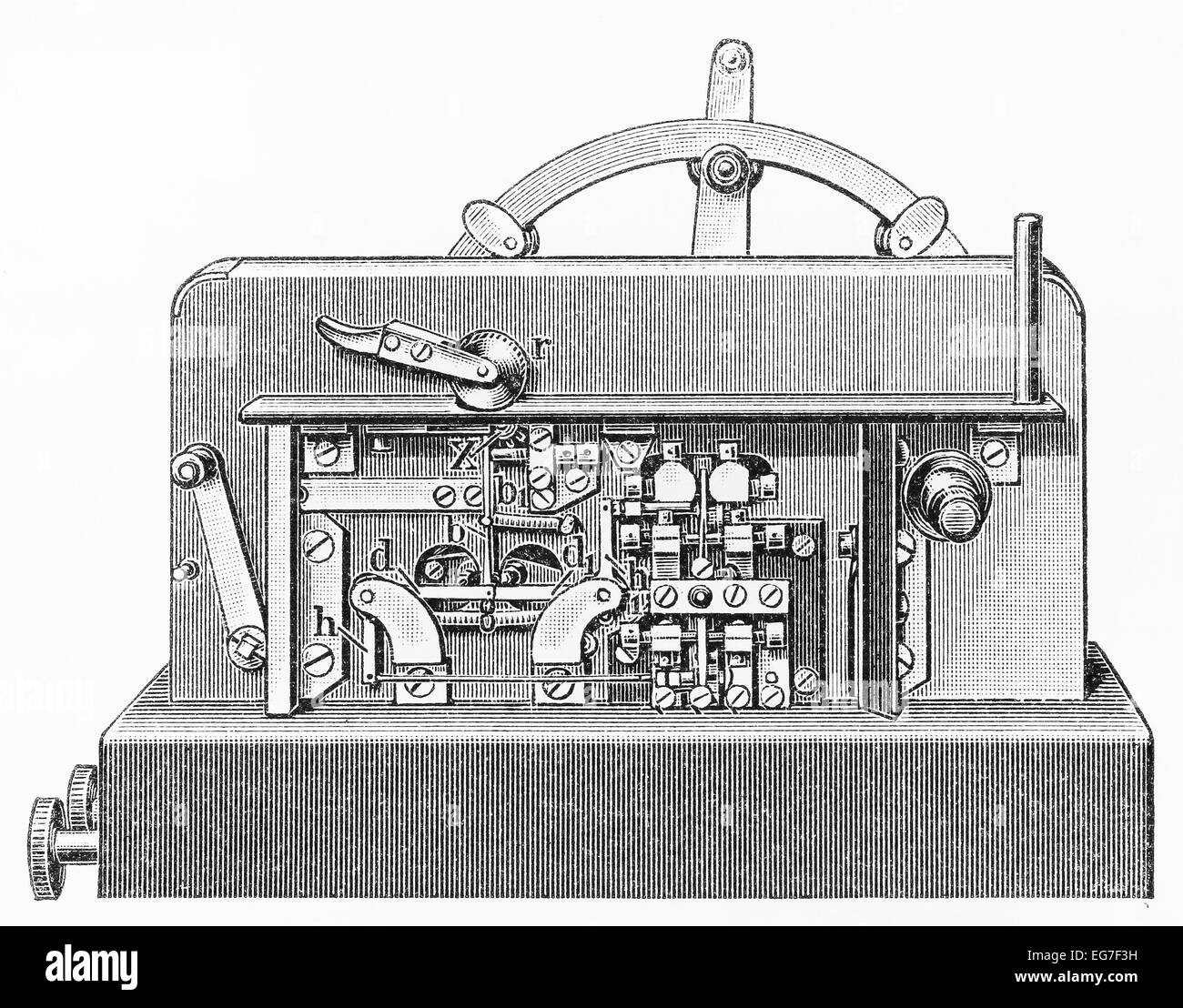 Vintage 19th century drawing of a Wheatstone Morse code/telegraph transmitter Stock Photohttps://www.alamy.com/image-license-details/?v=1https://www.alamy.com/stock-photo-vintage-19th-century-drawing-of-a-wheatstone-morse-codetelegraph-transmitter-78841493.html
Vintage 19th century drawing of a Wheatstone Morse code/telegraph transmitter Stock Photohttps://www.alamy.com/image-license-details/?v=1https://www.alamy.com/stock-photo-vintage-19th-century-drawing-of-a-wheatstone-morse-codetelegraph-transmitter-78841493.htmlRFEG7F3H–Vintage 19th century drawing of a Wheatstone Morse code/telegraph transmitter
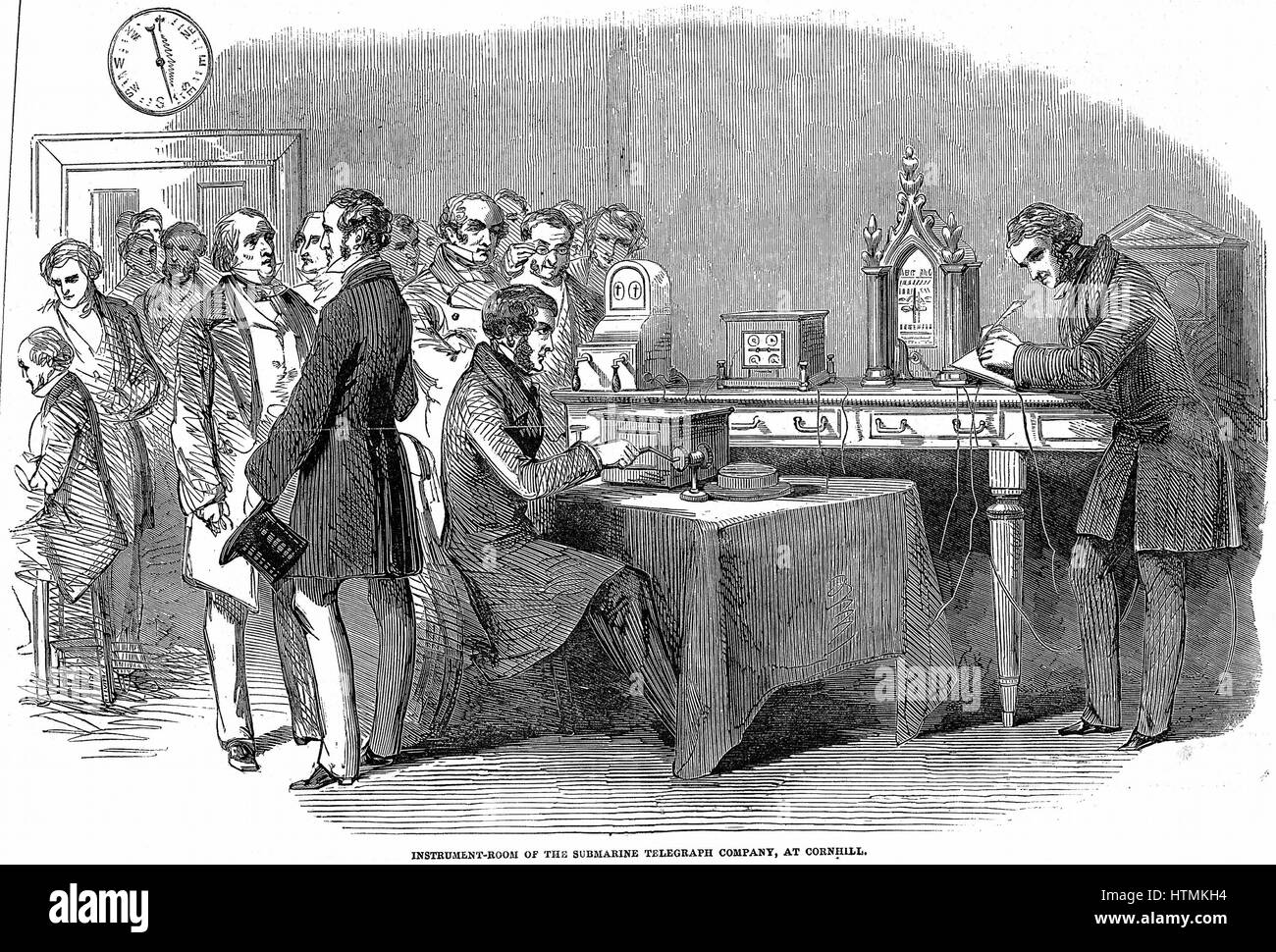 Opening of the London to Paris telegraph link. Instrument room at the Submarine Telegraph Company, Cornhill, London, showing Wheatstone needle telegraph instrument. Wood engraving November 1852 Stock Photohttps://www.alamy.com/image-license-details/?v=1https://www.alamy.com/stock-photo-opening-of-the-london-to-paris-telegraph-link-instrument-room-at-the-135678736.html
Opening of the London to Paris telegraph link. Instrument room at the Submarine Telegraph Company, Cornhill, London, showing Wheatstone needle telegraph instrument. Wood engraving November 1852 Stock Photohttps://www.alamy.com/image-license-details/?v=1https://www.alamy.com/stock-photo-opening-of-the-london-to-paris-telegraph-link-instrument-room-at-the-135678736.htmlRMHTMKH4–Opening of the London to Paris telegraph link. Instrument room at the Submarine Telegraph Company, Cornhill, London, showing Wheatstone needle telegraph instrument. Wood engraving November 1852
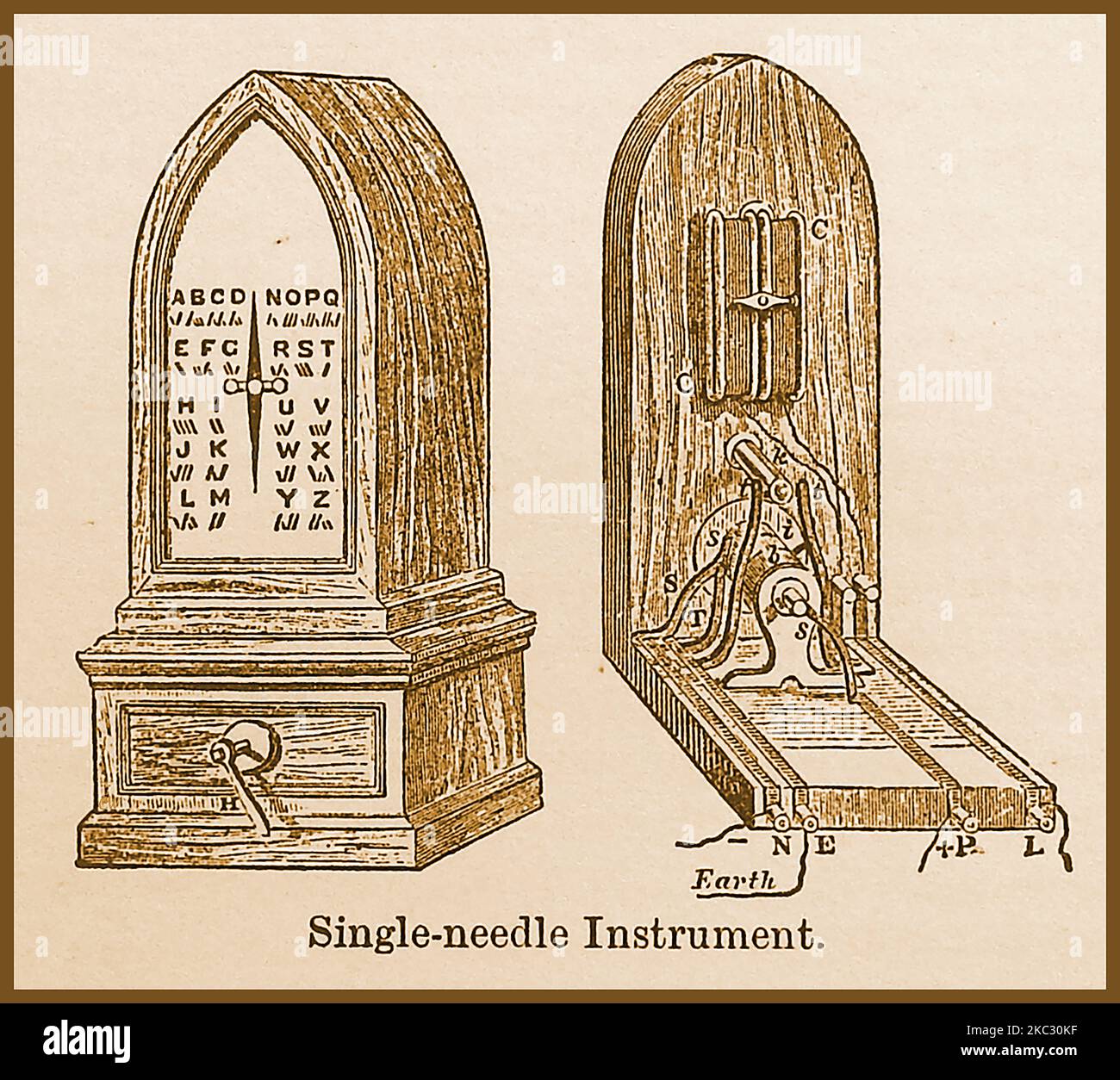 A 19th century dictionary engraving of a single-needle telegraph instrument. This early electrical telegraph used a needle moved electromagnetically to send and display messages. in 1820. Pavel Schilling developed a telegraph using needles suspended by threads. William Fothergill Cooke started building telegraphs in England and with Charles Wheatstone developed an improved version that was used by railway companies. Cooke's Electric Telegraph Company, (1846 was the first public telegraph service in Britain. Stock Photohttps://www.alamy.com/image-license-details/?v=1https://www.alamy.com/a-19th-century-dictionary-engraving-of-a-single-needle-telegraph-instrument-this-early-electrical-telegraph-used-a-needle-moved-electromagnetically-to-send-and-display-messages-in-1820-pavel-schilling-developed-a-telegraph-using-needles-suspended-by-threads-william-fothergill-cooke-started-building-telegraphs-in-england-and-with-charles-wheatstone-developed-an-improved-version-that-was-used-by-railway-companies-cookes-electric-telegraph-company-1846-was-the-first-public-telegraph-service-in-britain-image489332579.html
A 19th century dictionary engraving of a single-needle telegraph instrument. This early electrical telegraph used a needle moved electromagnetically to send and display messages. in 1820. Pavel Schilling developed a telegraph using needles suspended by threads. William Fothergill Cooke started building telegraphs in England and with Charles Wheatstone developed an improved version that was used by railway companies. Cooke's Electric Telegraph Company, (1846 was the first public telegraph service in Britain. Stock Photohttps://www.alamy.com/image-license-details/?v=1https://www.alamy.com/a-19th-century-dictionary-engraving-of-a-single-needle-telegraph-instrument-this-early-electrical-telegraph-used-a-needle-moved-electromagnetically-to-send-and-display-messages-in-1820-pavel-schilling-developed-a-telegraph-using-needles-suspended-by-threads-william-fothergill-cooke-started-building-telegraphs-in-england-and-with-charles-wheatstone-developed-an-improved-version-that-was-used-by-railway-companies-cookes-electric-telegraph-company-1846-was-the-first-public-telegraph-service-in-britain-image489332579.htmlRM2KC30KF–A 19th century dictionary engraving of a single-needle telegraph instrument. This early electrical telegraph used a needle moved electromagnetically to send and display messages. in 1820. Pavel Schilling developed a telegraph using needles suspended by threads. William Fothergill Cooke started building telegraphs in England and with Charles Wheatstone developed an improved version that was used by railway companies. Cooke's Electric Telegraph Company, (1846 was the first public telegraph service in Britain.
 Opening of the London to Paris telegraph link. Instrument room at the Submarine Telegraph Company, Cornhill, London, showing Wheatstone needle telegraph instrument. Wood engraving November 1852 Stock Photohttps://www.alamy.com/image-license-details/?v=1https://www.alamy.com/stock-photo-opening-of-the-london-to-paris-telegraph-link-instrument-room-at-the-57312785.html
Opening of the London to Paris telegraph link. Instrument room at the Submarine Telegraph Company, Cornhill, London, showing Wheatstone needle telegraph instrument. Wood engraving November 1852 Stock Photohttps://www.alamy.com/image-license-details/?v=1https://www.alamy.com/stock-photo-opening-of-the-london-to-paris-telegraph-link-instrument-room-at-the-57312785.htmlRMD96R15–Opening of the London to Paris telegraph link. Instrument room at the Submarine Telegraph Company, Cornhill, London, showing Wheatstone needle telegraph instrument. Wood engraving November 1852
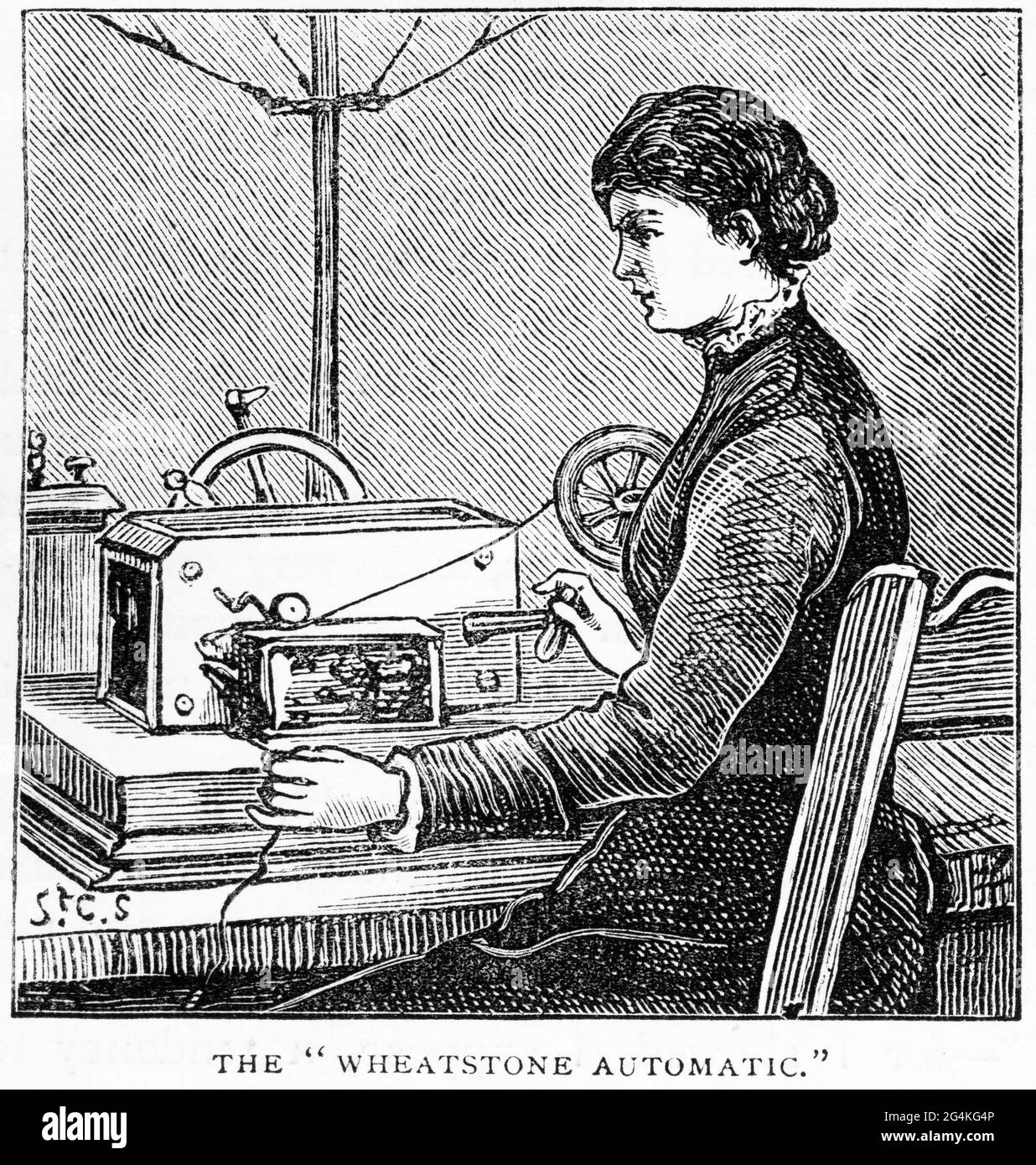 Engraving of a woman operating a Wheatstone Automatic telegraph machine capable of sending and receiving recorded morse code messages, circa 1890 Stock Photohttps://www.alamy.com/image-license-details/?v=1https://www.alamy.com/engraving-of-a-woman-operating-a-wheatstone-automatic-telegraph-machine-capable-of-sending-and-receiving-recorded-morse-code-messages-circa-1890-image433147590.html
Engraving of a woman operating a Wheatstone Automatic telegraph machine capable of sending and receiving recorded morse code messages, circa 1890 Stock Photohttps://www.alamy.com/image-license-details/?v=1https://www.alamy.com/engraving-of-a-woman-operating-a-wheatstone-automatic-telegraph-machine-capable-of-sending-and-receiving-recorded-morse-code-messages-circa-1890-image433147590.htmlRM2G4KG4P–Engraving of a woman operating a Wheatstone Automatic telegraph machine capable of sending and receiving recorded morse code messages, circa 1890
 Illustration showing Cooke and Wheatstone's single-needle telegraph. The Cooke and Wheatstone telegraph was an early electrical telegraph system dating from the 1830s invented by English inventor William Fothergill Cooke and English scientist Charles Wheatstone. It was the first telegraph system to be put into commercial service. 1890 Stock Photohttps://www.alamy.com/image-license-details/?v=1https://www.alamy.com/illustration-showing-cooke-and-wheatstones-single-needle-telegraph-the-cooke-and-wheatstone-telegraph-was-an-early-electrical-telegraph-system-dating-from-the-1830s-invented-by-english-inventor-william-fothergill-cooke-and-english-scientist-charles-wheatstone-it-was-the-first-telegraph-system-to-be-put-into-commercial-service-1890-image235029507.html
Illustration showing Cooke and Wheatstone's single-needle telegraph. The Cooke and Wheatstone telegraph was an early electrical telegraph system dating from the 1830s invented by English inventor William Fothergill Cooke and English scientist Charles Wheatstone. It was the first telegraph system to be put into commercial service. 1890 Stock Photohttps://www.alamy.com/image-license-details/?v=1https://www.alamy.com/illustration-showing-cooke-and-wheatstones-single-needle-telegraph-the-cooke-and-wheatstone-telegraph-was-an-early-electrical-telegraph-system-dating-from-the-1830s-invented-by-english-inventor-william-fothergill-cooke-and-english-scientist-charles-wheatstone-it-was-the-first-telegraph-system-to-be-put-into-commercial-service-1890-image235029507.htmlRMRJAEEY–Illustration showing Cooke and Wheatstone's single-needle telegraph. The Cooke and Wheatstone telegraph was an early electrical telegraph system dating from the 1830s invented by English inventor William Fothergill Cooke and English scientist Charles Wheatstone. It was the first telegraph system to be put into commercial service. 1890
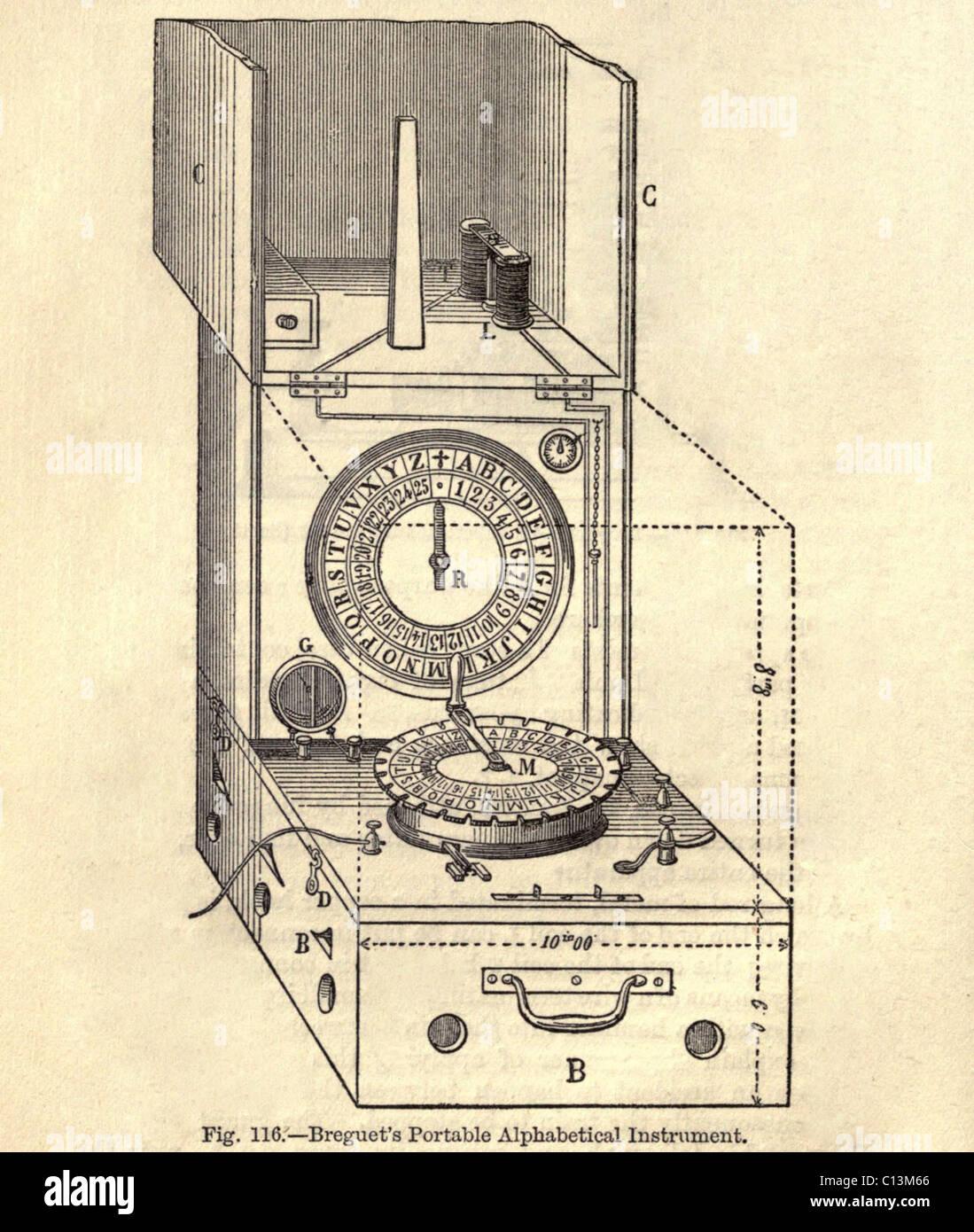 Breguet's Portable Alphabetical instrument a telegraph consisting of a transmitter and a receiver powered by an electric battery both have a round face on with letters of the alphabet. Like the British Cooke-Wheatstone telegraph this French telegraph communicated with alphabetically instead of Morse Code. Ca. 1850. Stock Photohttps://www.alamy.com/image-license-details/?v=1https://www.alamy.com/stock-photo-breguets-portable-alphabetical-instrument-a-telegraph-consisting-of-35117102.html
Breguet's Portable Alphabetical instrument a telegraph consisting of a transmitter and a receiver powered by an electric battery both have a round face on with letters of the alphabet. Like the British Cooke-Wheatstone telegraph this French telegraph communicated with alphabetically instead of Morse Code. Ca. 1850. Stock Photohttps://www.alamy.com/image-license-details/?v=1https://www.alamy.com/stock-photo-breguets-portable-alphabetical-instrument-a-telegraph-consisting-of-35117102.htmlRMC13M66–Breguet's Portable Alphabetical instrument a telegraph consisting of a transmitter and a receiver powered by an electric battery both have a round face on with letters of the alphabet. Like the British Cooke-Wheatstone telegraph this French telegraph communicated with alphabetically instead of Morse Code. Ca. 1850.
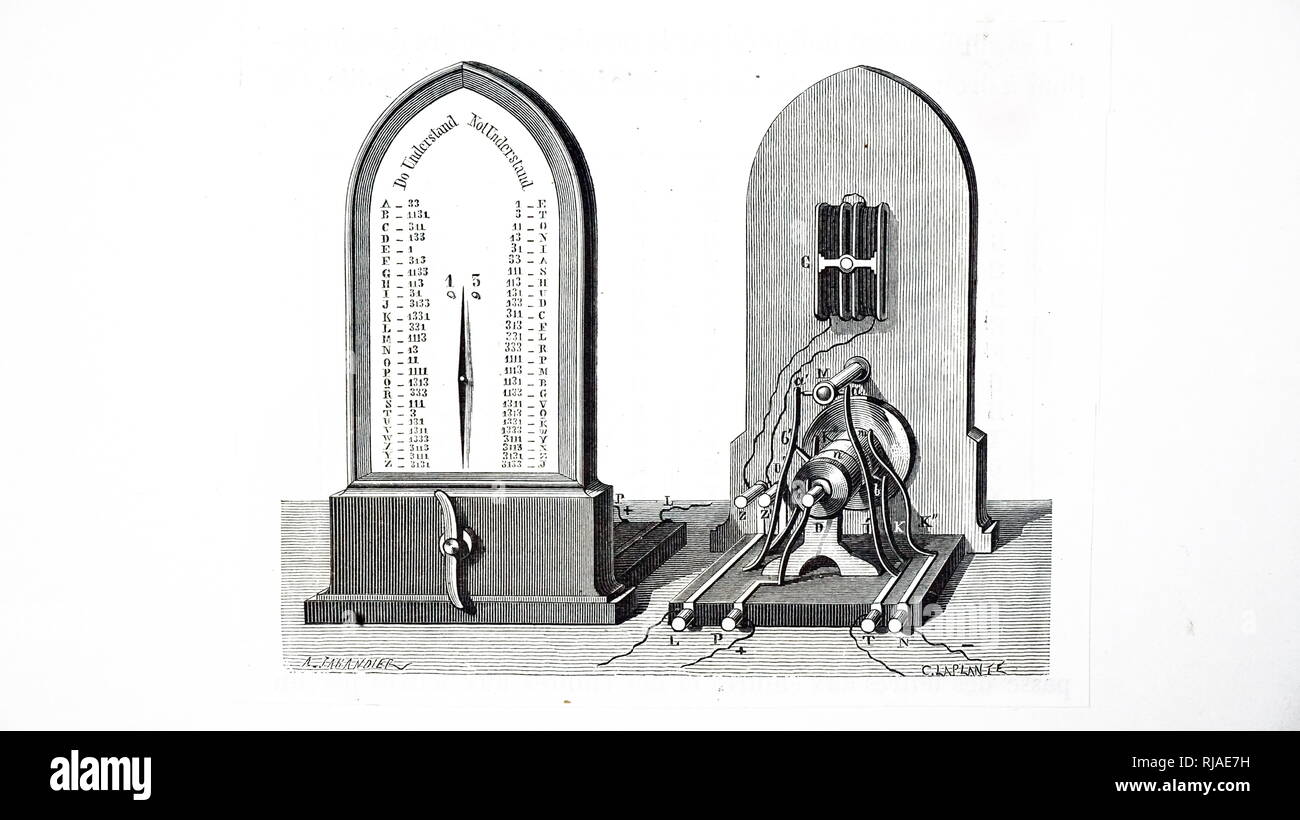 Illustration showing Cooke and Wheatstone's single-needle telegraph. The Cooke and Wheatstone telegraph was an early electrical telegraph system dating from the 1830s invented by English inventor William Fothergill Cooke and English scientist Charles Wheatstone. It was the first telegraph system to be put into commercial service. 1874 Stock Photohttps://www.alamy.com/image-license-details/?v=1https://www.alamy.com/illustration-showing-cooke-and-wheatstones-single-needle-telegraph-the-cooke-and-wheatstone-telegraph-was-an-early-electrical-telegraph-system-dating-from-the-1830s-invented-by-english-inventor-william-fothergill-cooke-and-english-scientist-charles-wheatstone-it-was-the-first-telegraph-system-to-be-put-into-commercial-service-1874-image235029301.html
Illustration showing Cooke and Wheatstone's single-needle telegraph. The Cooke and Wheatstone telegraph was an early electrical telegraph system dating from the 1830s invented by English inventor William Fothergill Cooke and English scientist Charles Wheatstone. It was the first telegraph system to be put into commercial service. 1874 Stock Photohttps://www.alamy.com/image-license-details/?v=1https://www.alamy.com/illustration-showing-cooke-and-wheatstones-single-needle-telegraph-the-cooke-and-wheatstone-telegraph-was-an-early-electrical-telegraph-system-dating-from-the-1830s-invented-by-english-inventor-william-fothergill-cooke-and-english-scientist-charles-wheatstone-it-was-the-first-telegraph-system-to-be-put-into-commercial-service-1874-image235029301.htmlRMRJAE7H–Illustration showing Cooke and Wheatstone's single-needle telegraph. The Cooke and Wheatstone telegraph was an early electrical telegraph system dating from the 1830s invented by English inventor William Fothergill Cooke and English scientist Charles Wheatstone. It was the first telegraph system to be put into commercial service. 1874
 Vintage technology: double needle telegraph by Wheatstone and Cooke from 1830, the first telegraph system put in commercial service, with no need to learn a code and without investing in staff training Stock Photohttps://www.alamy.com/image-license-details/?v=1https://www.alamy.com/vintage-technology-double-needle-telegraph-by-wheatstone-and-cooke-from-1830-the-first-telegraph-system-put-in-commercial-service-with-no-need-to-learn-a-code-and-without-investing-in-staff-training-image382416071.html
Vintage technology: double needle telegraph by Wheatstone and Cooke from 1830, the first telegraph system put in commercial service, with no need to learn a code and without investing in staff training Stock Photohttps://www.alamy.com/image-license-details/?v=1https://www.alamy.com/vintage-technology-double-needle-telegraph-by-wheatstone-and-cooke-from-1830-the-first-telegraph-system-put-in-commercial-service-with-no-need-to-learn-a-code-and-without-investing-in-staff-training-image382416071.htmlRF2D64FGR–Vintage technology: double needle telegraph by Wheatstone and Cooke from 1830, the first telegraph system put in commercial service, with no need to learn a code and without investing in staff training
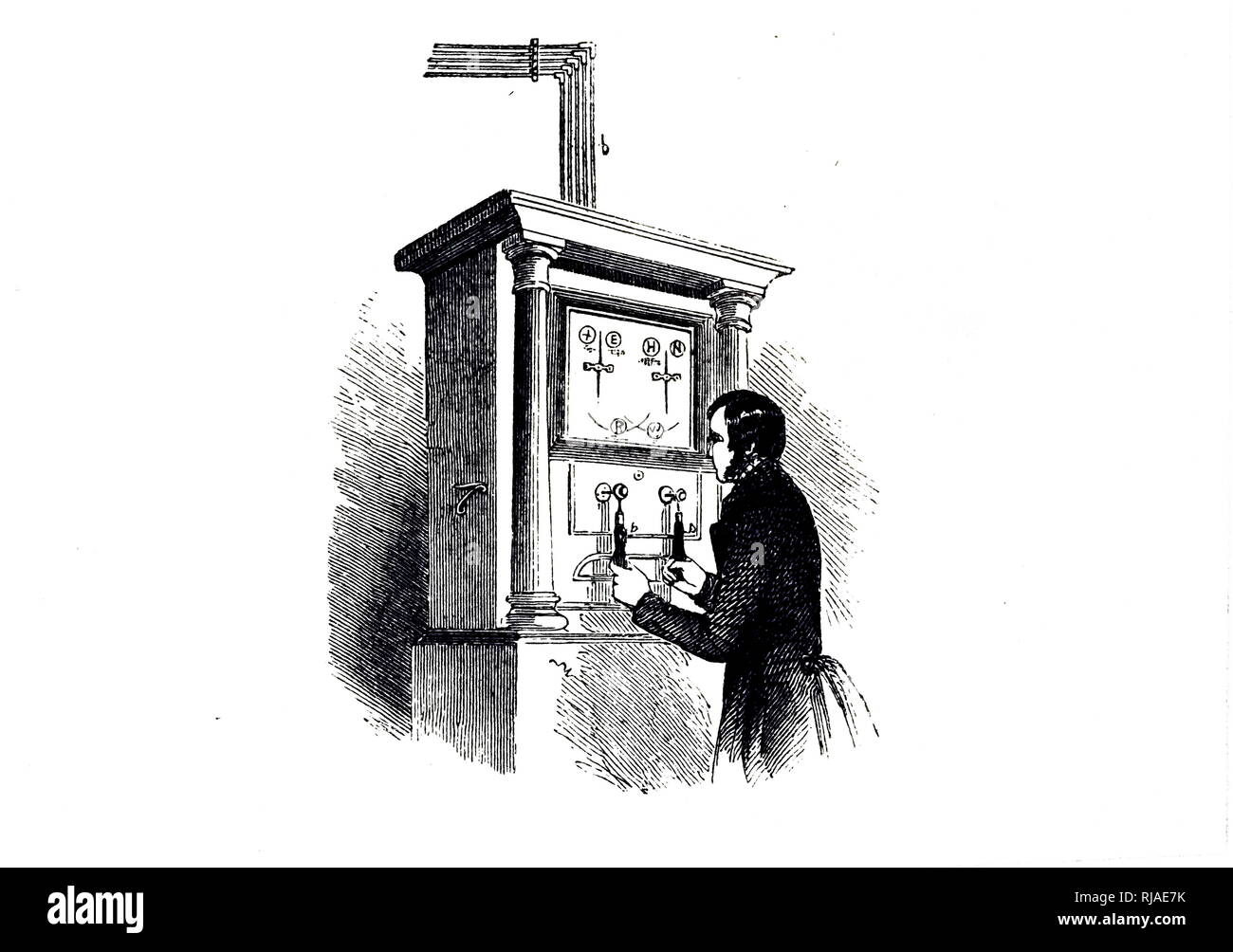 Illustration showing Cooke and Wheatstone's double-needle telegraph. The Cooke and Wheatstone telegraph was an early electrical telegraph system dating from the 1830s invented by English inventor William Fothergill Cooke and English scientist Charles Wheatstone. It was the first telegraph system to be put into commercial service. 1870 Stock Photohttps://www.alamy.com/image-license-details/?v=1https://www.alamy.com/illustration-showing-cooke-and-wheatstones-double-needle-telegraph-the-cooke-and-wheatstone-telegraph-was-an-early-electrical-telegraph-system-dating-from-the-1830s-invented-by-english-inventor-william-fothergill-cooke-and-english-scientist-charles-wheatstone-it-was-the-first-telegraph-system-to-be-put-into-commercial-service-1870-image235029303.html
Illustration showing Cooke and Wheatstone's double-needle telegraph. The Cooke and Wheatstone telegraph was an early electrical telegraph system dating from the 1830s invented by English inventor William Fothergill Cooke and English scientist Charles Wheatstone. It was the first telegraph system to be put into commercial service. 1870 Stock Photohttps://www.alamy.com/image-license-details/?v=1https://www.alamy.com/illustration-showing-cooke-and-wheatstones-double-needle-telegraph-the-cooke-and-wheatstone-telegraph-was-an-early-electrical-telegraph-system-dating-from-the-1830s-invented-by-english-inventor-william-fothergill-cooke-and-english-scientist-charles-wheatstone-it-was-the-first-telegraph-system-to-be-put-into-commercial-service-1870-image235029303.htmlRMRJAE7K–Illustration showing Cooke and Wheatstone's double-needle telegraph. The Cooke and Wheatstone telegraph was an early electrical telegraph system dating from the 1830s invented by English inventor William Fothergill Cooke and English scientist Charles Wheatstone. It was the first telegraph system to be put into commercial service. 1870
 WHEATSTONE Stock Photohttps://www.alamy.com/image-license-details/?v=1https://www.alamy.com/stock-photo-wheatstone-105263593.html
WHEATSTONE Stock Photohttps://www.alamy.com/image-license-details/?v=1https://www.alamy.com/stock-photo-wheatstone-105263593.htmlRMG374P1–WHEATSTONE
 Wheatstone's relay; which enabled the electric telegraph to be used over a long distance. 1890. Stock Photohttps://www.alamy.com/image-license-details/?v=1https://www.alamy.com/stock-photo-wheatstones-relay-which-enabled-the-electric-telegraph-to-be-used-131278314.html
Wheatstone's relay; which enabled the electric telegraph to be used over a long distance. 1890. Stock Photohttps://www.alamy.com/image-license-details/?v=1https://www.alamy.com/stock-photo-wheatstones-relay-which-enabled-the-electric-telegraph-to-be-used-131278314.htmlRMHHG6R6–Wheatstone's relay; which enabled the electric telegraph to be used over a long distance. 1890.
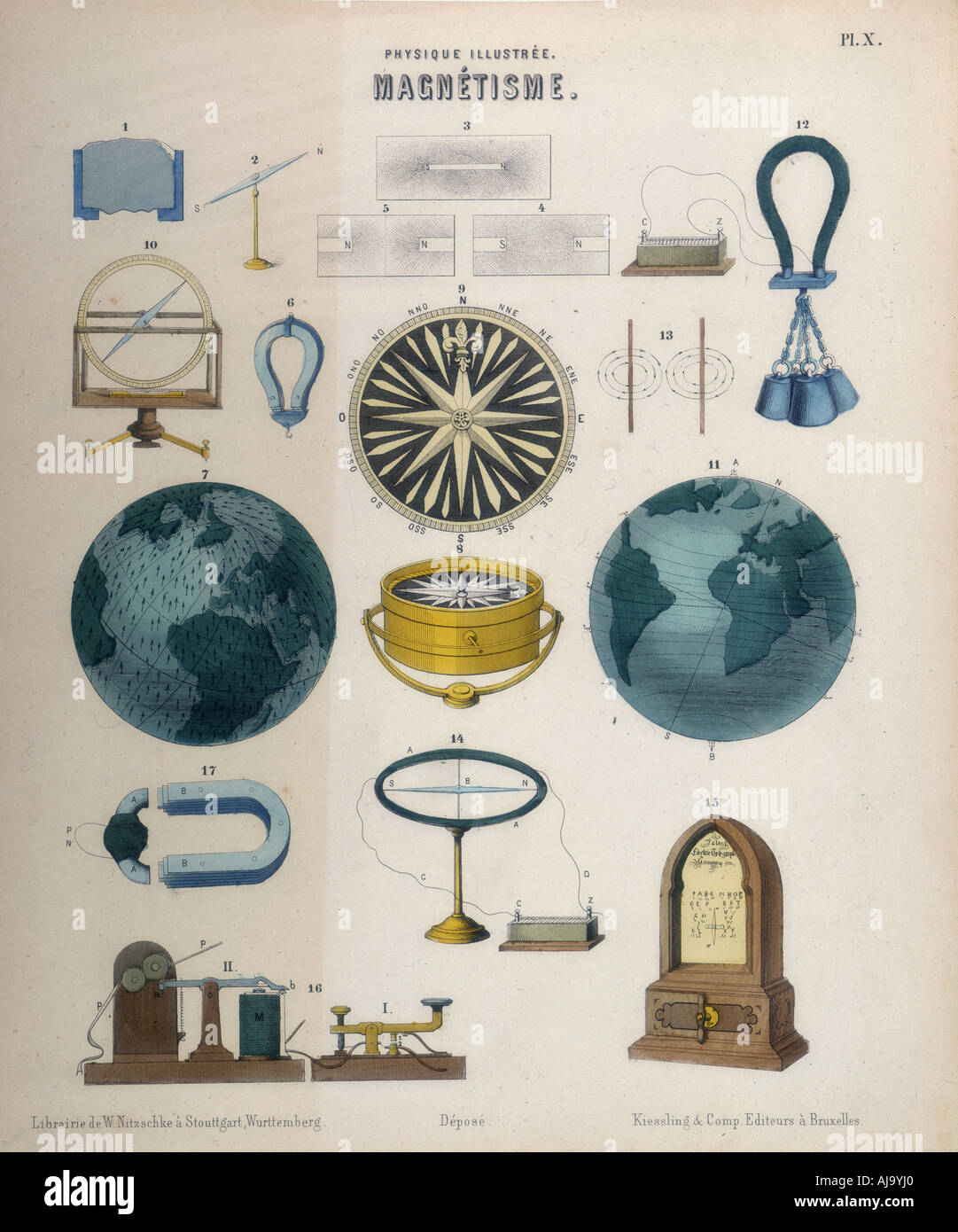 Magnetism, c1850. Artist: Unknown Stock Photohttps://www.alamy.com/image-license-details/?v=1https://www.alamy.com/magnetism-c1850-artist-unknown-image8382815.html
Magnetism, c1850. Artist: Unknown Stock Photohttps://www.alamy.com/image-license-details/?v=1https://www.alamy.com/magnetism-c1850-artist-unknown-image8382815.htmlRMAJ9YJ0–Magnetism, c1850. Artist: Unknown
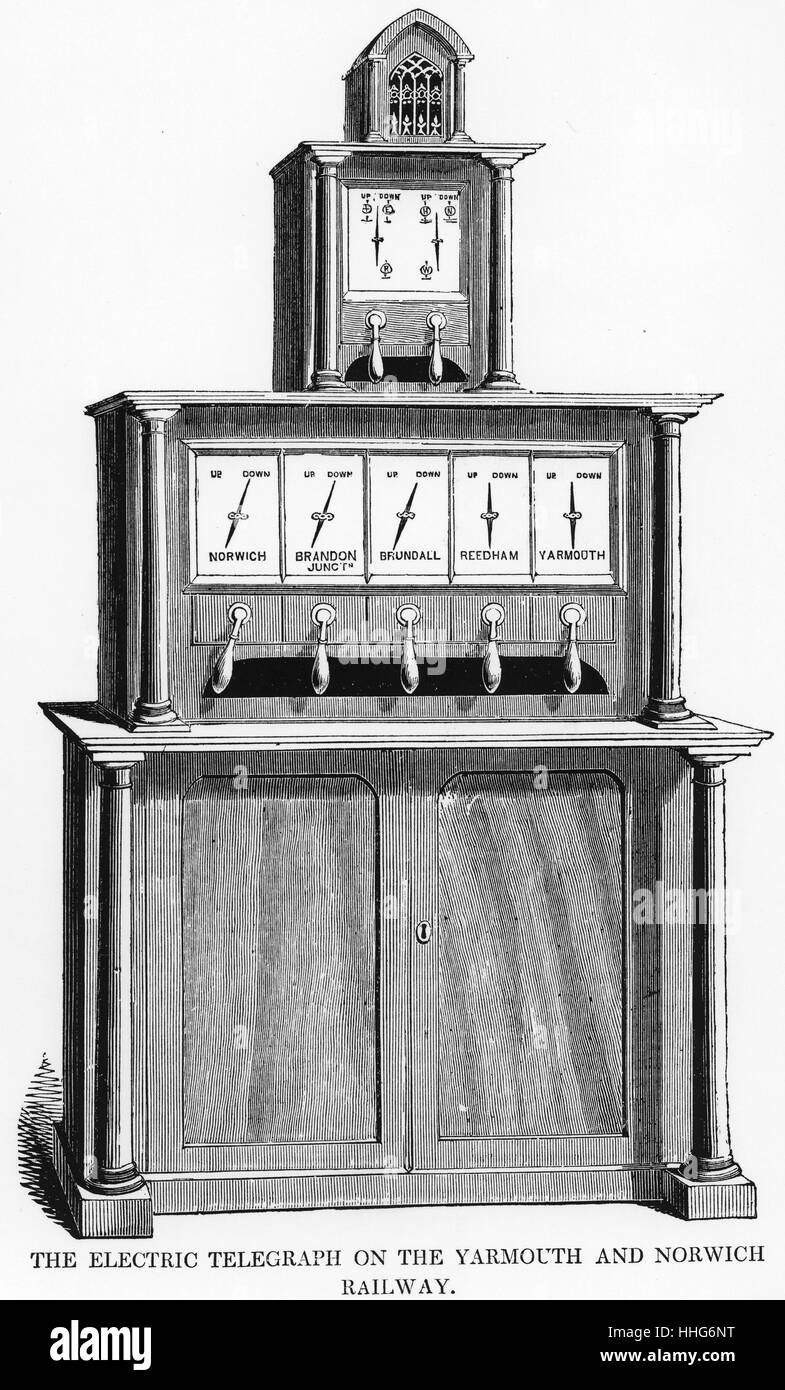 Cooke/Wheatstone needle telegraph used on the Yarmouth and Norwich Railway. 1845. Stock Photohttps://www.alamy.com/image-license-details/?v=1https://www.alamy.com/stock-photo-cookewheatstone-needle-telegraph-used-on-the-yarmouth-and-norwich-131278276.html
Cooke/Wheatstone needle telegraph used on the Yarmouth and Norwich Railway. 1845. Stock Photohttps://www.alamy.com/image-license-details/?v=1https://www.alamy.com/stock-photo-cookewheatstone-needle-telegraph-used-on-the-yarmouth-and-norwich-131278276.htmlRMHHG6NT–Cooke/Wheatstone needle telegraph used on the Yarmouth and Norwich Railway. 1845.
 Wheatstone, Charles, 7.2.1802 - 19.10.1875, British physicist, drawing by Samuel Laurence, 1868, ARTIST'S COPYRIGHT HAS NOT TO BE CLEARED Stock Photohttps://www.alamy.com/image-license-details/?v=1https://www.alamy.com/wheatstone-charles-721802-19101875-british-physicist-drawing-by-samuel-laurence-1868-artists-copyright-has-not-to-be-cleared-image612584497.html
Wheatstone, Charles, 7.2.1802 - 19.10.1875, British physicist, drawing by Samuel Laurence, 1868, ARTIST'S COPYRIGHT HAS NOT TO BE CLEARED Stock Photohttps://www.alamy.com/image-license-details/?v=1https://www.alamy.com/wheatstone-charles-721802-19101875-british-physicist-drawing-by-samuel-laurence-1868-artists-copyright-has-not-to-be-cleared-image612584497.htmlRM2XGHHNN–Wheatstone, Charles, 7.2.1802 - 19.10.1875, British physicist, drawing by Samuel Laurence, 1868, ARTIST'S COPYRIGHT HAS NOT TO BE CLEARED
 ELECTRIC TELEGRAPH; Including Cooke and Wheatstone single and double needle instruments (Figs 4 & 5). Sounder (Fig 7) for Morse telegraph which enabled signal to be 'read' aurally; dispersing with taped messages. Wheatstone's Alphabetical Telegraph (Fig 9). Combination Printing Telegraph (Fig 10) in which A.A. Lovett brought together the best features of the House and Hughes telegraphs: 1859. Stock Photohttps://www.alamy.com/image-license-details/?v=1https://www.alamy.com/stock-photo-electric-telegraph-including-cooke-and-wheatstone-single-and-double-131278487.html
ELECTRIC TELEGRAPH; Including Cooke and Wheatstone single and double needle instruments (Figs 4 & 5). Sounder (Fig 7) for Morse telegraph which enabled signal to be 'read' aurally; dispersing with taped messages. Wheatstone's Alphabetical Telegraph (Fig 9). Combination Printing Telegraph (Fig 10) in which A.A. Lovett brought together the best features of the House and Hughes telegraphs: 1859. Stock Photohttps://www.alamy.com/image-license-details/?v=1https://www.alamy.com/stock-photo-electric-telegraph-including-cooke-and-wheatstone-single-and-double-131278487.htmlRMHHG71B–ELECTRIC TELEGRAPH; Including Cooke and Wheatstone single and double needle instruments (Figs 4 & 5). Sounder (Fig 7) for Morse telegraph which enabled signal to be 'read' aurally; dispersing with taped messages. Wheatstone's Alphabetical Telegraph (Fig 9). Combination Printing Telegraph (Fig 10) in which A.A. Lovett brought together the best features of the House and Hughes telegraphs: 1859.
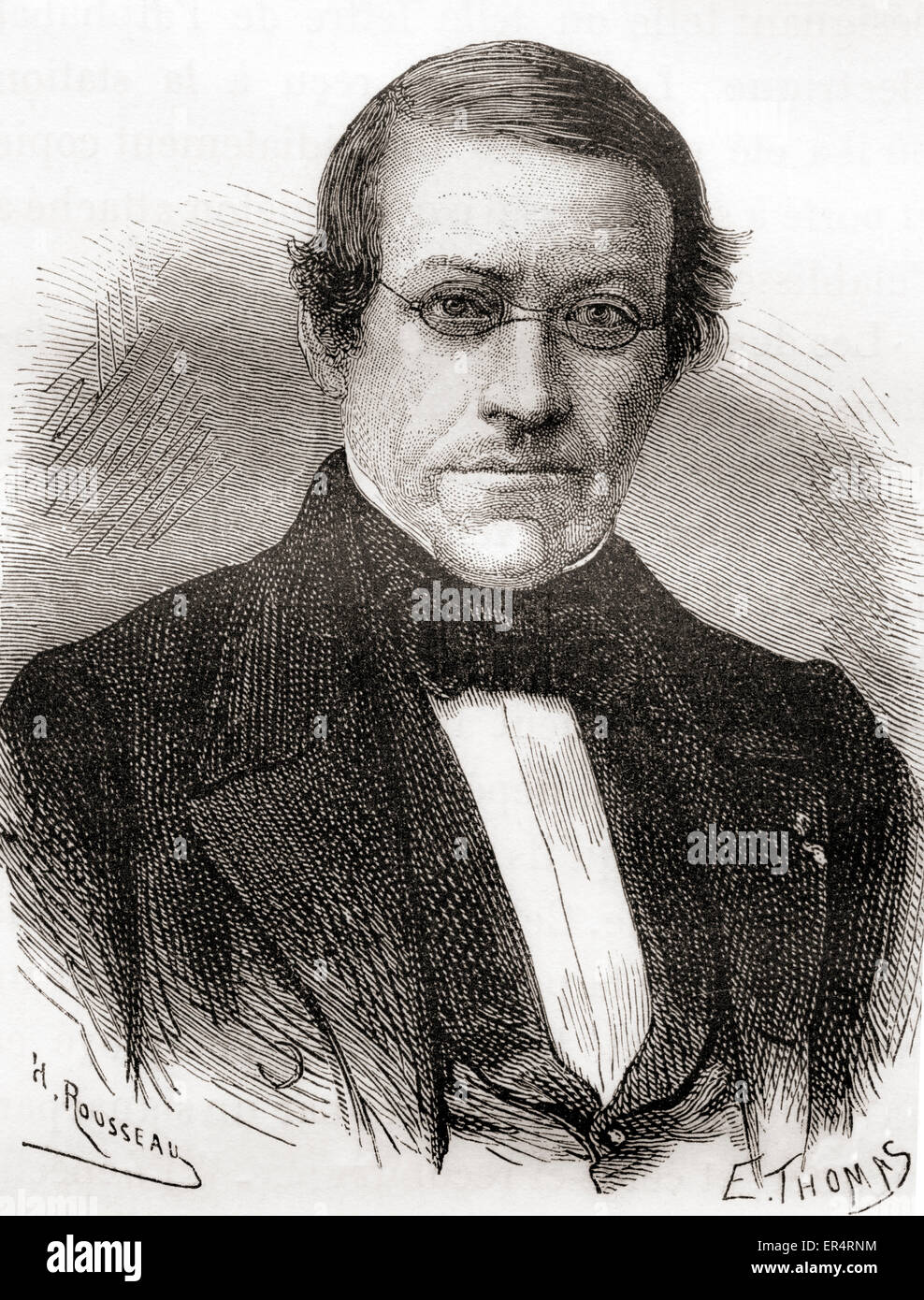 Sir Charles Wheatstone, 1802 – 1875. English scientist and inventor of the Wheatstone bridge and Playfair cipher. Also known for his early contributions to Spectroscopy and Telegraphy. Stock Photohttps://www.alamy.com/image-license-details/?v=1https://www.alamy.com/stock-photo-sir-charles-wheatstone-1802-1875-english-scientist-and-inventor-of-83085008.html
Sir Charles Wheatstone, 1802 – 1875. English scientist and inventor of the Wheatstone bridge and Playfair cipher. Also known for his early contributions to Spectroscopy and Telegraphy. Stock Photohttps://www.alamy.com/image-license-details/?v=1https://www.alamy.com/stock-photo-sir-charles-wheatstone-1802-1875-english-scientist-and-inventor-of-83085008.htmlRMER4RNM–Sir Charles Wheatstone, 1802 – 1875. English scientist and inventor of the Wheatstone bridge and Playfair cipher. Also known for his early contributions to Spectroscopy and Telegraphy.
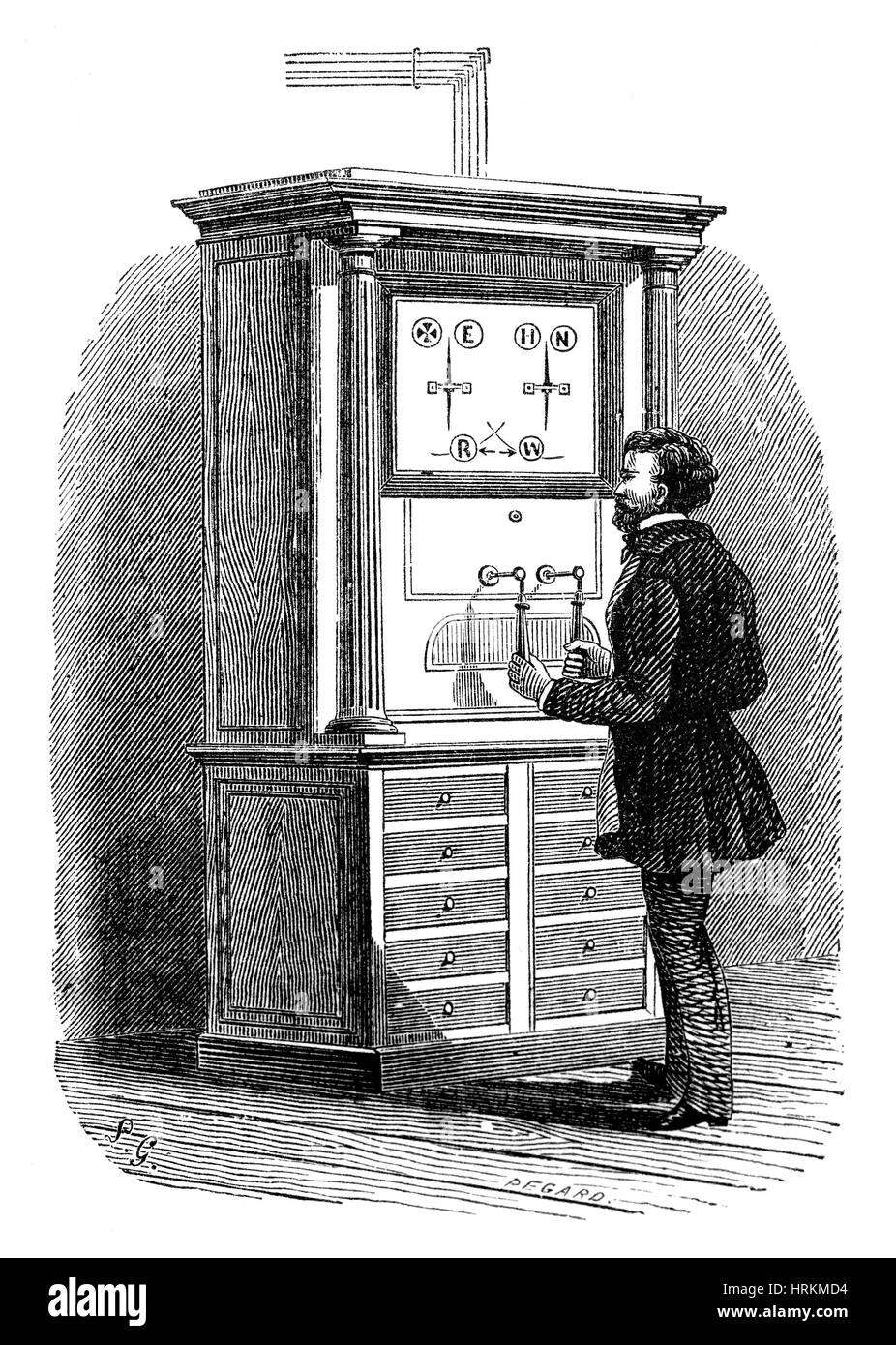 Cooke and Wheatstone Two Needle Telegraph, 1830s Stock Photohttps://www.alamy.com/image-license-details/?v=1https://www.alamy.com/stock-photo-cooke-and-wheatstone-two-needle-telegraph-1830s-135042800.html
Cooke and Wheatstone Two Needle Telegraph, 1830s Stock Photohttps://www.alamy.com/image-license-details/?v=1https://www.alamy.com/stock-photo-cooke-and-wheatstone-two-needle-telegraph-1830s-135042800.htmlRMHRKMD4–Cooke and Wheatstone Two Needle Telegraph, 1830s
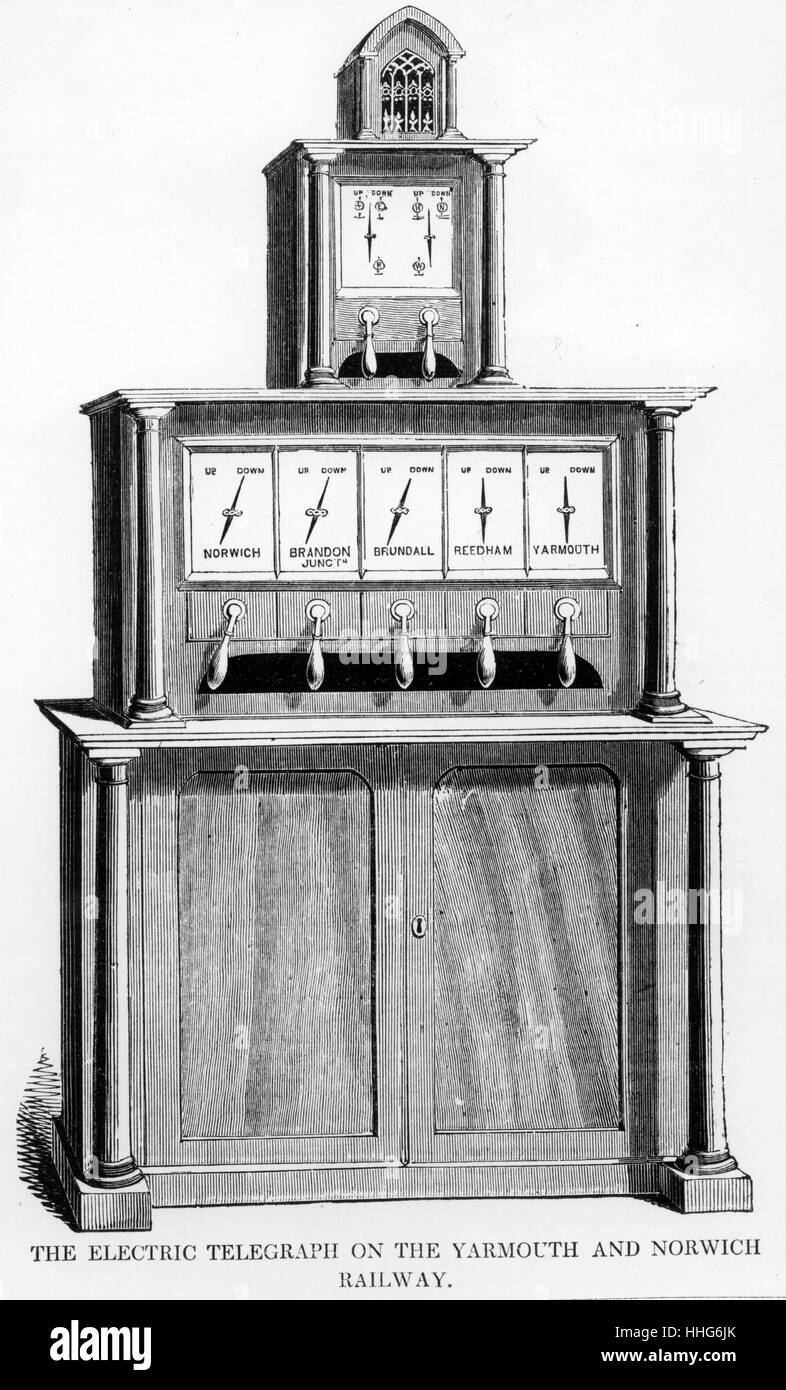 Cooke, Wheatstone needle telegraph used on the Yarmouth and Norwich Railway. 1845. Stock Photohttps://www.alamy.com/image-license-details/?v=1https://www.alamy.com/stock-photo-cooke-wheatstone-needle-telegraph-used-on-the-yarmouth-and-norwich-131278187.html
Cooke, Wheatstone needle telegraph used on the Yarmouth and Norwich Railway. 1845. Stock Photohttps://www.alamy.com/image-license-details/?v=1https://www.alamy.com/stock-photo-cooke-wheatstone-needle-telegraph-used-on-the-yarmouth-and-norwich-131278187.htmlRMHHG6JK–Cooke, Wheatstone needle telegraph used on the Yarmouth and Norwich Railway. 1845.
 TELEGRAPHS. Cooke Wheatstone's single needle Telegraph; current reverser 1880 Stock Photohttps://www.alamy.com/image-license-details/?v=1https://www.alamy.com/telegraphs-cooke-wheatstones-single-needle-telegraph-current-reverser-1880-image183122562.html
TELEGRAPHS. Cooke Wheatstone's single needle Telegraph; current reverser 1880 Stock Photohttps://www.alamy.com/image-license-details/?v=1https://www.alamy.com/telegraphs-cooke-wheatstones-single-needle-telegraph-current-reverser-1880-image183122562.htmlRFMHWXKE–TELEGRAPHS. Cooke Wheatstone's single needle Telegraph; current reverser 1880
 Cooke and Wheatstone's Telegraph. Circa 1837. A version of the telegraph made 2 years prior to the first public telegraph service (which started in 1839.). Stock Photohttps://www.alamy.com/image-license-details/?v=1https://www.alamy.com/stock-photo-cooke-and-wheatstones-telegraph-circa-1837-a-version-of-the-telegraph-104976984.html
Cooke and Wheatstone's Telegraph. Circa 1837. A version of the telegraph made 2 years prior to the first public telegraph service (which started in 1839.). Stock Photohttps://www.alamy.com/image-license-details/?v=1https://www.alamy.com/stock-photo-cooke-and-wheatstones-telegraph-circa-1837-a-version-of-the-telegraph-104976984.htmlRMG2P360–Cooke and Wheatstone's Telegraph. Circa 1837. A version of the telegraph made 2 years prior to the first public telegraph service (which started in 1839.).
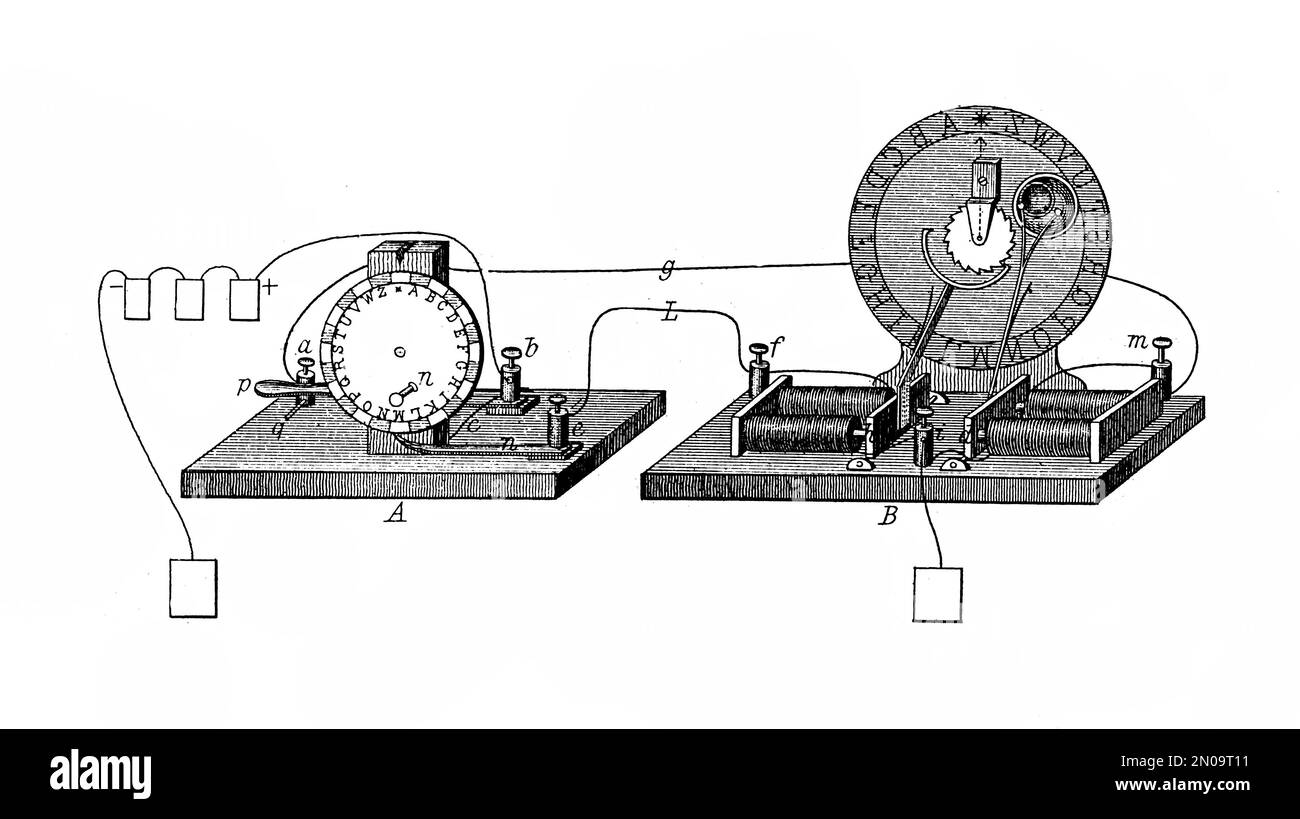 Antique illustration of Cooke-Wheatstone electrical telegraph, patented in May 1879. Engraving published in Systematischer Bilder Atlas - Bauwesen, Ik Stock Photohttps://www.alamy.com/image-license-details/?v=1https://www.alamy.com/antique-illustration-of-cooke-wheatstone-electrical-telegraph-patented-in-may-1879-engraving-published-in-systematischer-bilder-atlas-bauwesen-ik-image516527453.html
Antique illustration of Cooke-Wheatstone electrical telegraph, patented in May 1879. Engraving published in Systematischer Bilder Atlas - Bauwesen, Ik Stock Photohttps://www.alamy.com/image-license-details/?v=1https://www.alamy.com/antique-illustration-of-cooke-wheatstone-electrical-telegraph-patented-in-may-1879-engraving-published-in-systematischer-bilder-atlas-bauwesen-ik-image516527453.htmlRF2N09T11–Antique illustration of Cooke-Wheatstone electrical telegraph, patented in May 1879. Engraving published in Systematischer Bilder Atlas - Bauwesen, Ik
 Charles Wheatstone (1802-1875) British physicist. His work make the electric telegraph practicable. Engraving, 1882. Stock Photohttps://www.alamy.com/image-license-details/?v=1https://www.alamy.com/stock-photo-charles-wheatstone-1802-1875-british-physicist-his-work-make-the-electric-57309818.html
Charles Wheatstone (1802-1875) British physicist. His work make the electric telegraph practicable. Engraving, 1882. Stock Photohttps://www.alamy.com/image-license-details/?v=1https://www.alamy.com/stock-photo-charles-wheatstone-1802-1875-british-physicist-his-work-make-the-electric-57309818.htmlRMD96K76–Charles Wheatstone (1802-1875) British physicist. His work make the electric telegraph practicable. Engraving, 1882.
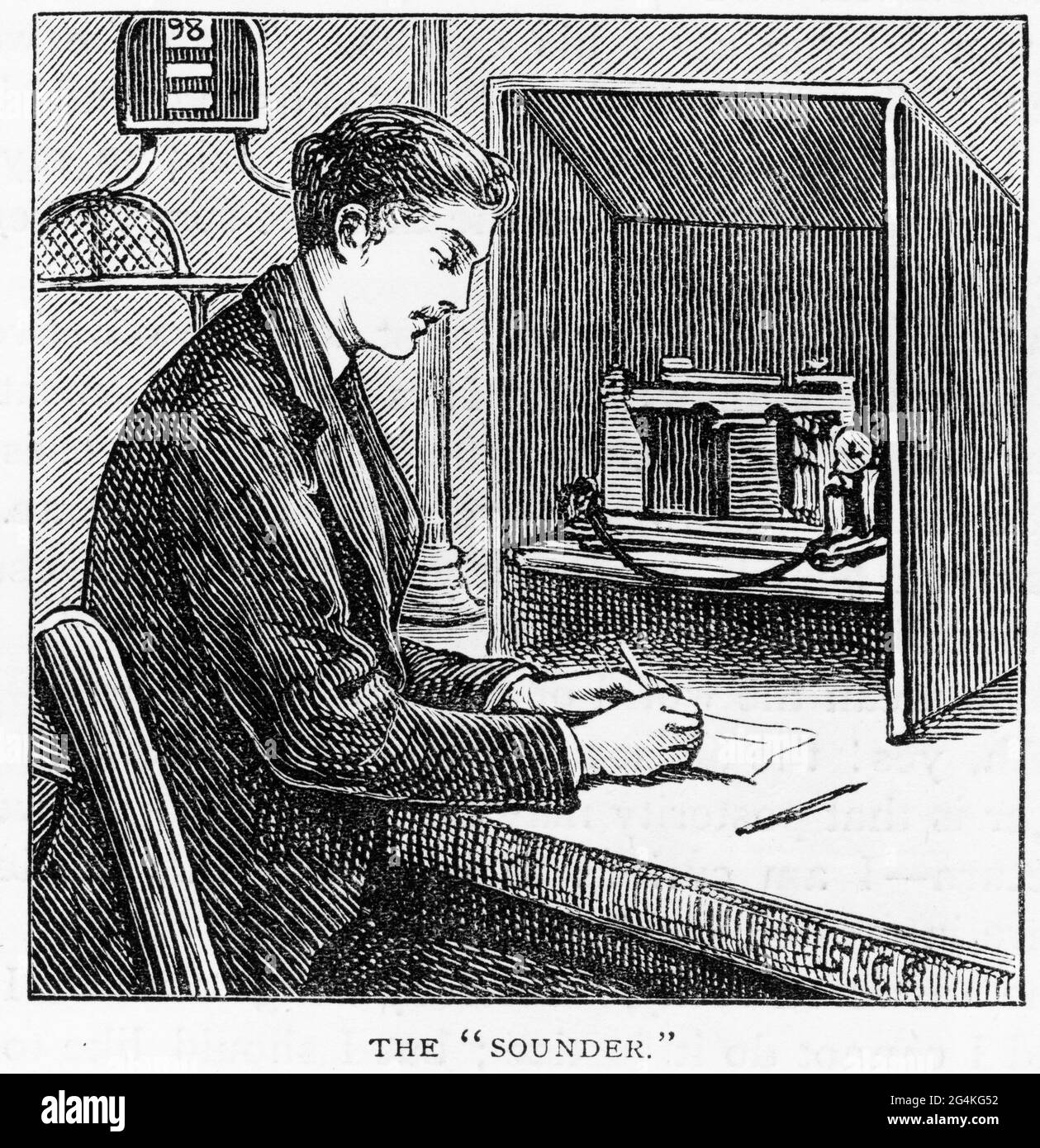 Engraving of a man receiving telegraph messages by morse code, circa 1890 Stock Photohttps://www.alamy.com/image-license-details/?v=1https://www.alamy.com/engraving-of-a-man-receiving-telegraph-messages-by-morse-code-circa-1890-image433147598.html
Engraving of a man receiving telegraph messages by morse code, circa 1890 Stock Photohttps://www.alamy.com/image-license-details/?v=1https://www.alamy.com/engraving-of-a-man-receiving-telegraph-messages-by-morse-code-circa-1890-image433147598.htmlRM2G4KG52–Engraving of a man receiving telegraph messages by morse code, circa 1890
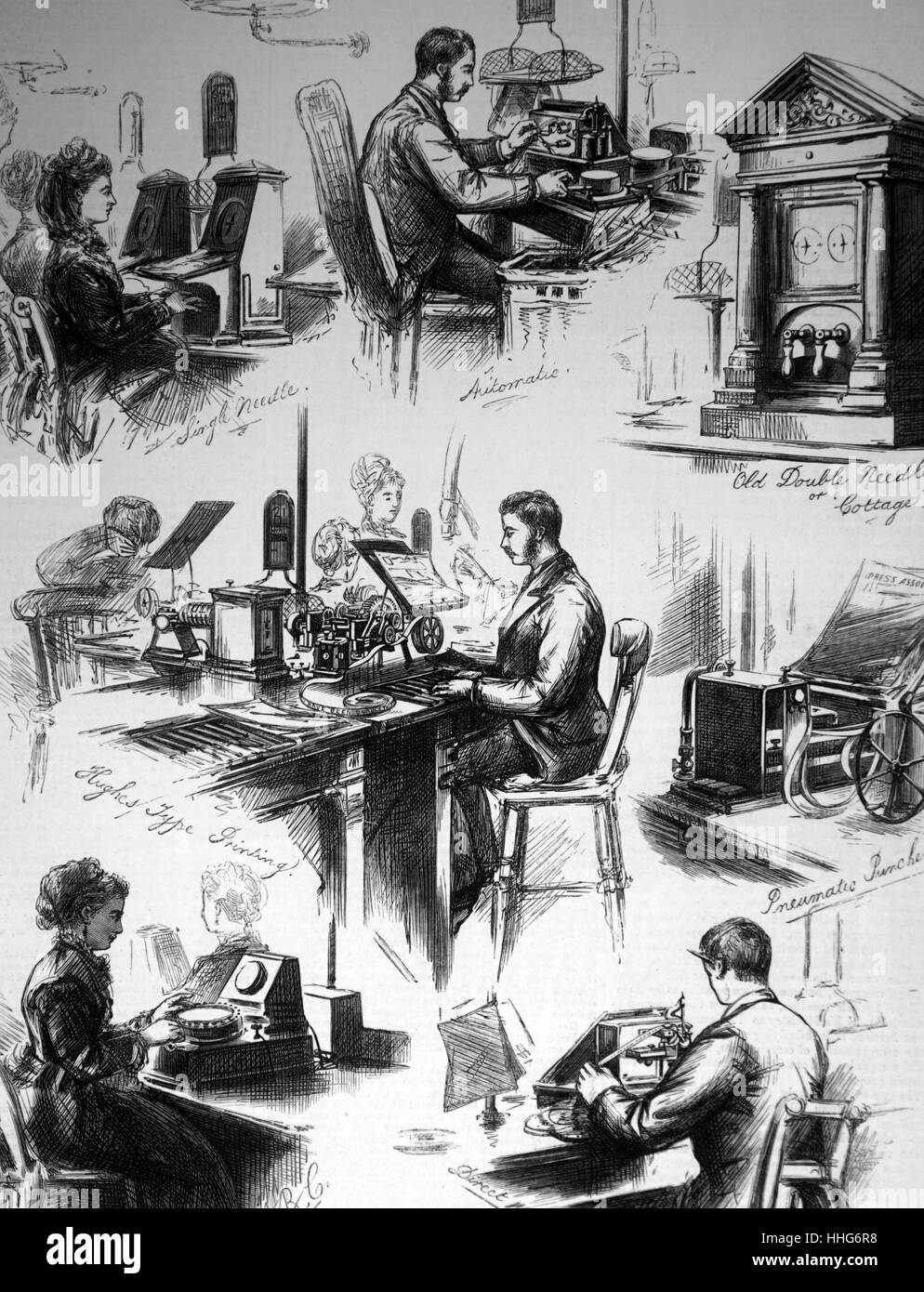 Central Telegraph Establishment; London; showing various instruments in use. Wheatstone needle telegraphs at top left and right and his automatic telegraph top centre. Stock Photohttps://www.alamy.com/image-license-details/?v=1https://www.alamy.com/stock-photo-central-telegraph-establishment-london-showing-various-instruments-131278316.html
Central Telegraph Establishment; London; showing various instruments in use. Wheatstone needle telegraphs at top left and right and his automatic telegraph top centre. Stock Photohttps://www.alamy.com/image-license-details/?v=1https://www.alamy.com/stock-photo-central-telegraph-establishment-london-showing-various-instruments-131278316.htmlRMHHG6R8–Central Telegraph Establishment; London; showing various instruments in use. Wheatstone needle telegraphs at top left and right and his automatic telegraph top centre.
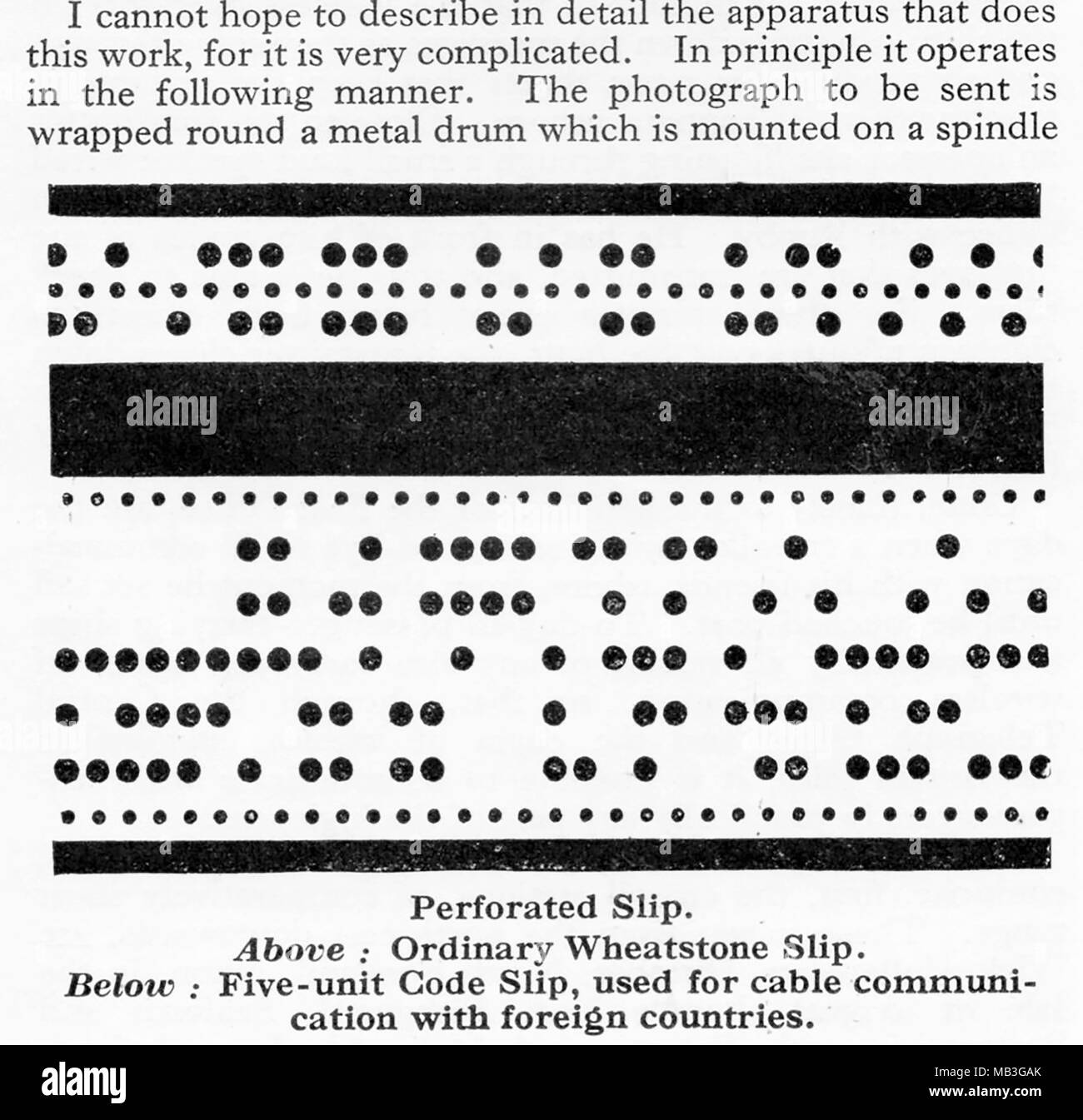 A printed description from 1933 showing how photographs could be sent by telegraph Stock Photohttps://www.alamy.com/image-license-details/?v=1https://www.alamy.com/a-printed-description-from-1933-showing-how-photographs-could-be-sent-by-telegraph-image178943595.html
A printed description from 1933 showing how photographs could be sent by telegraph Stock Photohttps://www.alamy.com/image-license-details/?v=1https://www.alamy.com/a-printed-description-from-1933-showing-how-photographs-could-be-sent-by-telegraph-image178943595.htmlRMMB3GAK–A printed description from 1933 showing how photographs could be sent by telegraph
 Sending a high speed message on the Wheatstone Automatic telegraph; General Post Office; St Martin's-le-Grand; London. 1879. Stock Photohttps://www.alamy.com/image-license-details/?v=1https://www.alamy.com/stock-photo-sending-a-high-speed-message-on-the-wheatstone-automatic-telegraph-131278342.html
Sending a high speed message on the Wheatstone Automatic telegraph; General Post Office; St Martin's-le-Grand; London. 1879. Stock Photohttps://www.alamy.com/image-license-details/?v=1https://www.alamy.com/stock-photo-sending-a-high-speed-message-on-the-wheatstone-automatic-telegraph-131278342.htmlRMHHG6T6–Sending a high speed message on the Wheatstone Automatic telegraph; General Post Office; St Martin's-le-Grand; London. 1879.
 Vintage technology: double needle transmitter and receiver telegraph station by Wheatstone and Cooke from 1830, the first telegraph system put in commercial service, with no need to learn a code and without investing in staff training Stock Photohttps://www.alamy.com/image-license-details/?v=1https://www.alamy.com/vintage-technology-double-needle-transmitter-and-receiver-telegraph-station-by-wheatstone-and-cooke-from-1830-the-first-telegraph-system-put-in-commercial-service-with-no-need-to-learn-a-code-and-without-investing-in-staff-training-image382416096.html
Vintage technology: double needle transmitter and receiver telegraph station by Wheatstone and Cooke from 1830, the first telegraph system put in commercial service, with no need to learn a code and without investing in staff training Stock Photohttps://www.alamy.com/image-license-details/?v=1https://www.alamy.com/vintage-technology-double-needle-transmitter-and-receiver-telegraph-station-by-wheatstone-and-cooke-from-1830-the-first-telegraph-system-put-in-commercial-service-with-no-need-to-learn-a-code-and-without-investing-in-staff-training-image382416096.htmlRF2D64FHM–Vintage technology: double needle transmitter and receiver telegraph station by Wheatstone and Cooke from 1830, the first telegraph system put in commercial service, with no need to learn a code and without investing in staff training
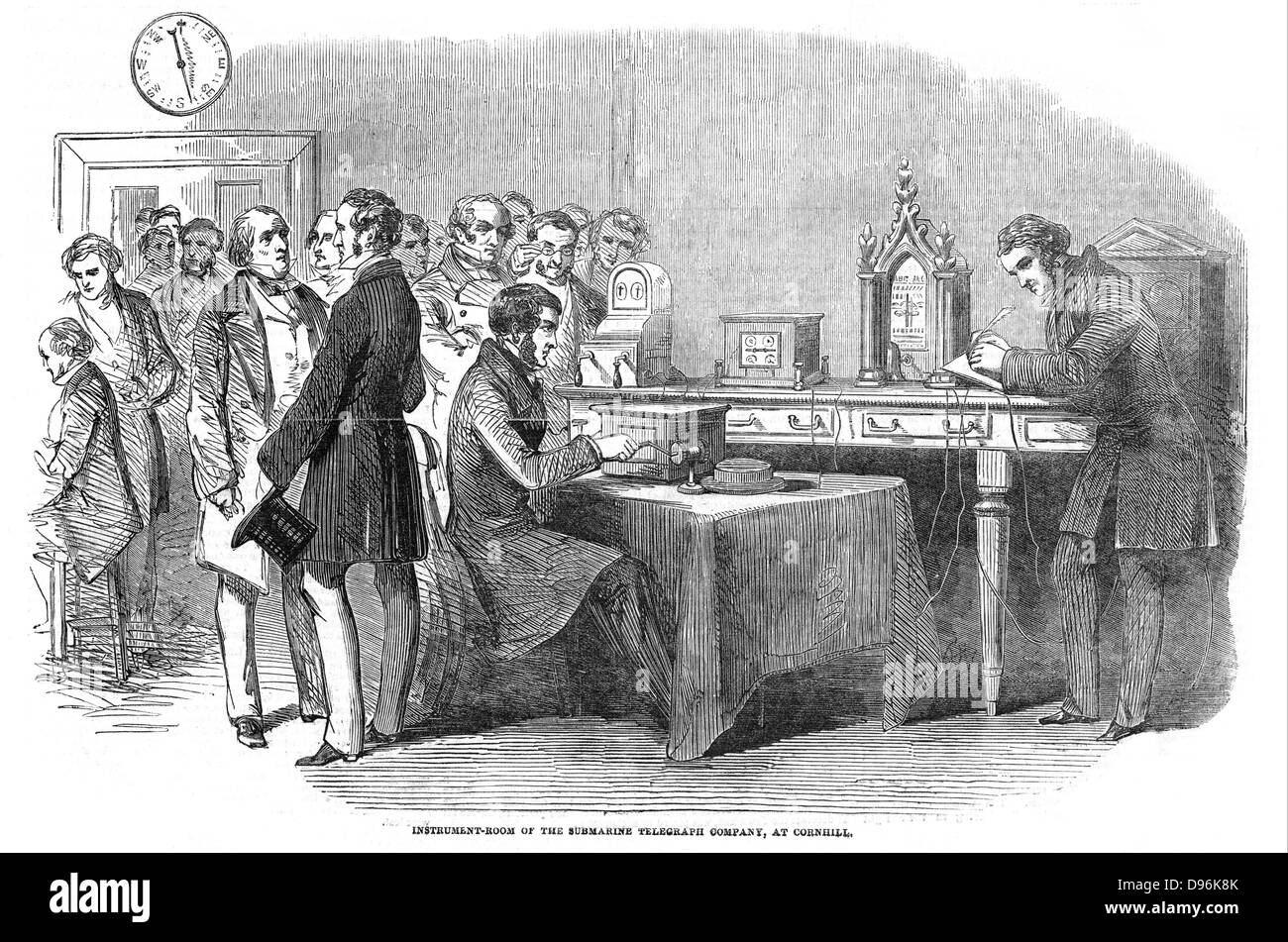 Opening of the London to Paris telegraph link. Instrument room at the Submarine Telegraph Company, Cornhill, London, showing the Wheatstone needle telegraph instruments. From The Illustrated London News, 13 November 1852 Stock Photohttps://www.alamy.com/image-license-details/?v=1https://www.alamy.com/stock-photo-opening-of-the-london-to-paris-telegraph-link-instrument-room-at-the-57309859.html
Opening of the London to Paris telegraph link. Instrument room at the Submarine Telegraph Company, Cornhill, London, showing the Wheatstone needle telegraph instruments. From The Illustrated London News, 13 November 1852 Stock Photohttps://www.alamy.com/image-license-details/?v=1https://www.alamy.com/stock-photo-opening-of-the-london-to-paris-telegraph-link-instrument-room-at-the-57309859.htmlRMD96K8K–Opening of the London to Paris telegraph link. Instrument room at the Submarine Telegraph Company, Cornhill, London, showing the Wheatstone needle telegraph instruments. From The Illustrated London News, 13 November 1852
 WHEATSTONE Stock Photohttps://www.alamy.com/image-license-details/?v=1https://www.alamy.com/stock-photo-wheatstone-105263592.html
WHEATSTONE Stock Photohttps://www.alamy.com/image-license-details/?v=1https://www.alamy.com/stock-photo-wheatstone-105263592.htmlRMG374P0–WHEATSTONE
 Wheatstone's Signal ABC electromagnetic telegraph. Stock Photohttps://www.alamy.com/image-license-details/?v=1https://www.alamy.com/stock-photo-wheatstones-signal-abc-electromagnetic-telegraph-131278325.html
Wheatstone's Signal ABC electromagnetic telegraph. Stock Photohttps://www.alamy.com/image-license-details/?v=1https://www.alamy.com/stock-photo-wheatstones-signal-abc-electromagnetic-telegraph-131278325.htmlRMHHG6RH–Wheatstone's Signal ABC electromagnetic telegraph.
 Charles Wheatstone (1802-1875), British physicist, 19th century. Artist: Unknown Stock Photohttps://www.alamy.com/image-license-details/?v=1https://www.alamy.com/charles-wheatstone-1802-1875-british-physicist-19th-century-artist-image8383390.html
Charles Wheatstone (1802-1875), British physicist, 19th century. Artist: Unknown Stock Photohttps://www.alamy.com/image-license-details/?v=1https://www.alamy.com/charles-wheatstone-1802-1875-british-physicist-19th-century-artist-image8383390.htmlRMAJA2HF–Charles Wheatstone (1802-1875), British physicist, 19th century. Artist: Unknown
 Instrument room at the Electric Telegraph Office; Lothbury; London. 1860. Stock Photohttps://www.alamy.com/image-license-details/?v=1https://www.alamy.com/stock-photo-instrument-room-at-the-electric-telegraph-office-lothbury-london-1860-131278312.html
Instrument room at the Electric Telegraph Office; Lothbury; London. 1860. Stock Photohttps://www.alamy.com/image-license-details/?v=1https://www.alamy.com/stock-photo-instrument-room-at-the-electric-telegraph-office-lothbury-london-1860-131278312.htmlRMHHG6R4–Instrument room at the Electric Telegraph Office; Lothbury; London. 1860.
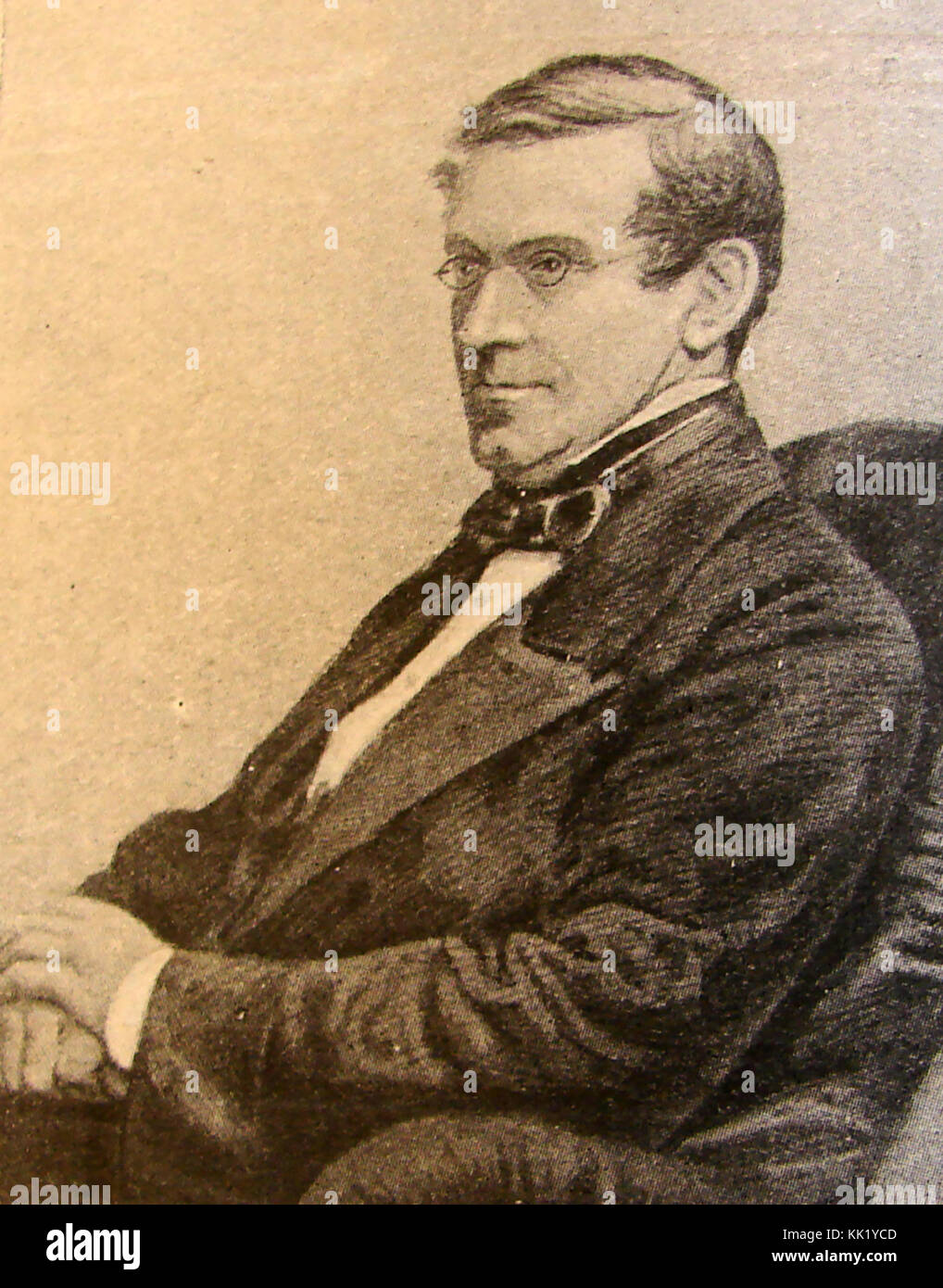 Sir Charles Wheatstone, English scientist and notable Victorian inventor (e.g. concertina and stereoscope) - A 1915 portrait. Also inventor of the 'Playfair cipher' encryption technique as well as making a large contribution to the development of telegraphy, optics,acoustics, spectroscopy. and the 'Polar Clock' Stock Photohttps://www.alamy.com/image-license-details/?v=1https://www.alamy.com/stock-image-sir-charles-wheatstone-english-scientist-and-notable-victorian-inventor-166615245.html
Sir Charles Wheatstone, English scientist and notable Victorian inventor (e.g. concertina and stereoscope) - A 1915 portrait. Also inventor of the 'Playfair cipher' encryption technique as well as making a large contribution to the development of telegraphy, optics,acoustics, spectroscopy. and the 'Polar Clock' Stock Photohttps://www.alamy.com/image-license-details/?v=1https://www.alamy.com/stock-image-sir-charles-wheatstone-english-scientist-and-notable-victorian-inventor-166615245.htmlRMKK1YCD–Sir Charles Wheatstone, English scientist and notable Victorian inventor (e.g. concertina and stereoscope) - A 1915 portrait. Also inventor of the 'Playfair cipher' encryption technique as well as making a large contribution to the development of telegraphy, optics,acoustics, spectroscopy. and the 'Polar Clock'
 Instrument room at the Electric Telegraph Office; Lothbury; London. 1855. Stock Photohttps://www.alamy.com/image-license-details/?v=1https://www.alamy.com/stock-photo-instrument-room-at-the-electric-telegraph-office-lothbury-london-1855-131278363.html
Instrument room at the Electric Telegraph Office; Lothbury; London. 1855. Stock Photohttps://www.alamy.com/image-license-details/?v=1https://www.alamy.com/stock-photo-instrument-room-at-the-electric-telegraph-office-lothbury-london-1855-131278363.htmlRMHHG6TY–Instrument room at the Electric Telegraph Office; Lothbury; London. 1855.
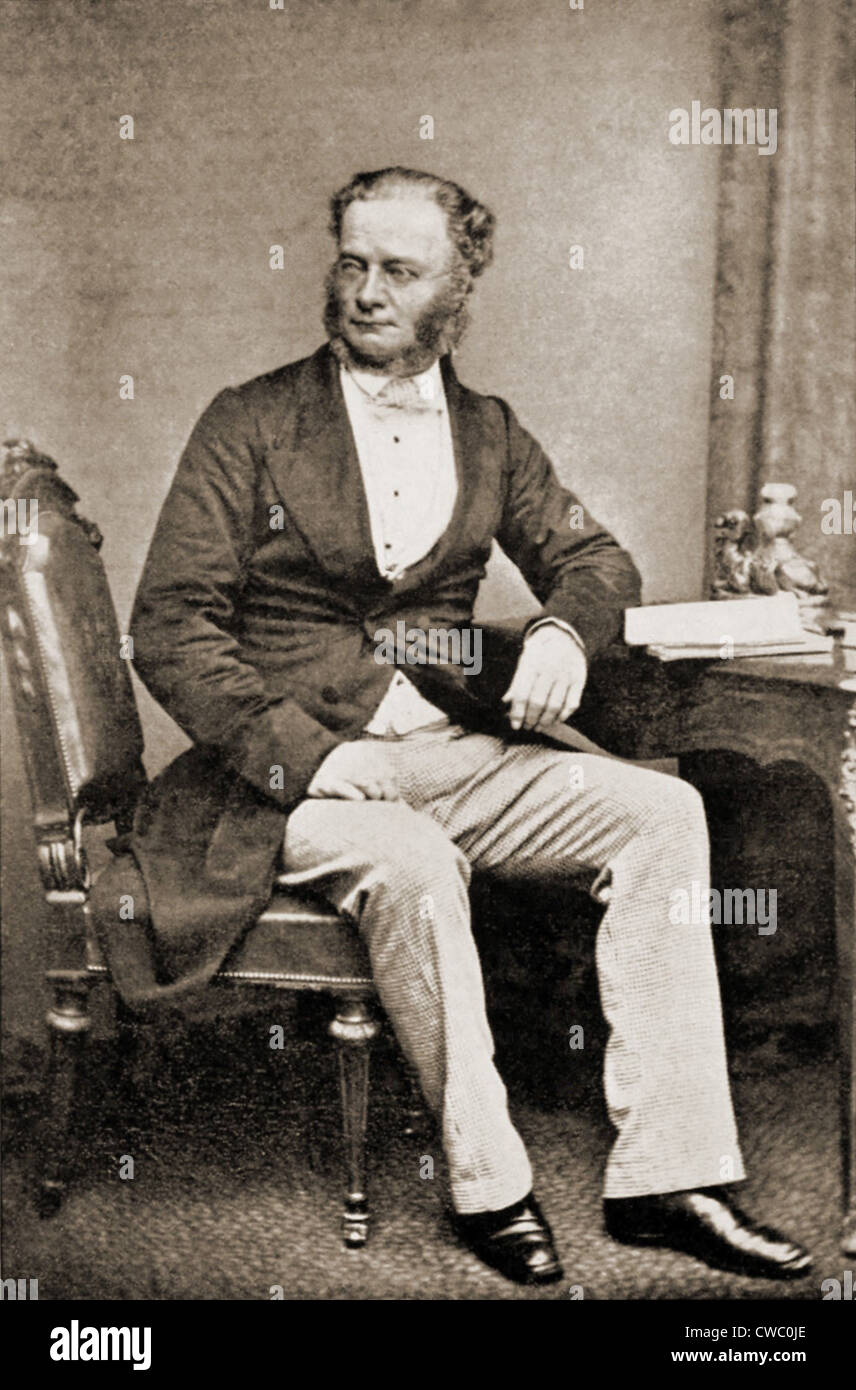 William Fothergill Cooke (1806-1879), with Charles Wheatstone, invented the Cooke-Wheatstone electrical telegraph, patented in Stock Photohttps://www.alamy.com/image-license-details/?v=1https://www.alamy.com/stock-photo-william-fothergill-cooke-1806-1879-with-charles-wheatstone-invented-50051078.html
William Fothergill Cooke (1806-1879), with Charles Wheatstone, invented the Cooke-Wheatstone electrical telegraph, patented in Stock Photohttps://www.alamy.com/image-license-details/?v=1https://www.alamy.com/stock-photo-william-fothergill-cooke-1806-1879-with-charles-wheatstone-invented-50051078.htmlRMCWC0JE–William Fothergill Cooke (1806-1879), with Charles Wheatstone, invented the Cooke-Wheatstone electrical telegraph, patented in
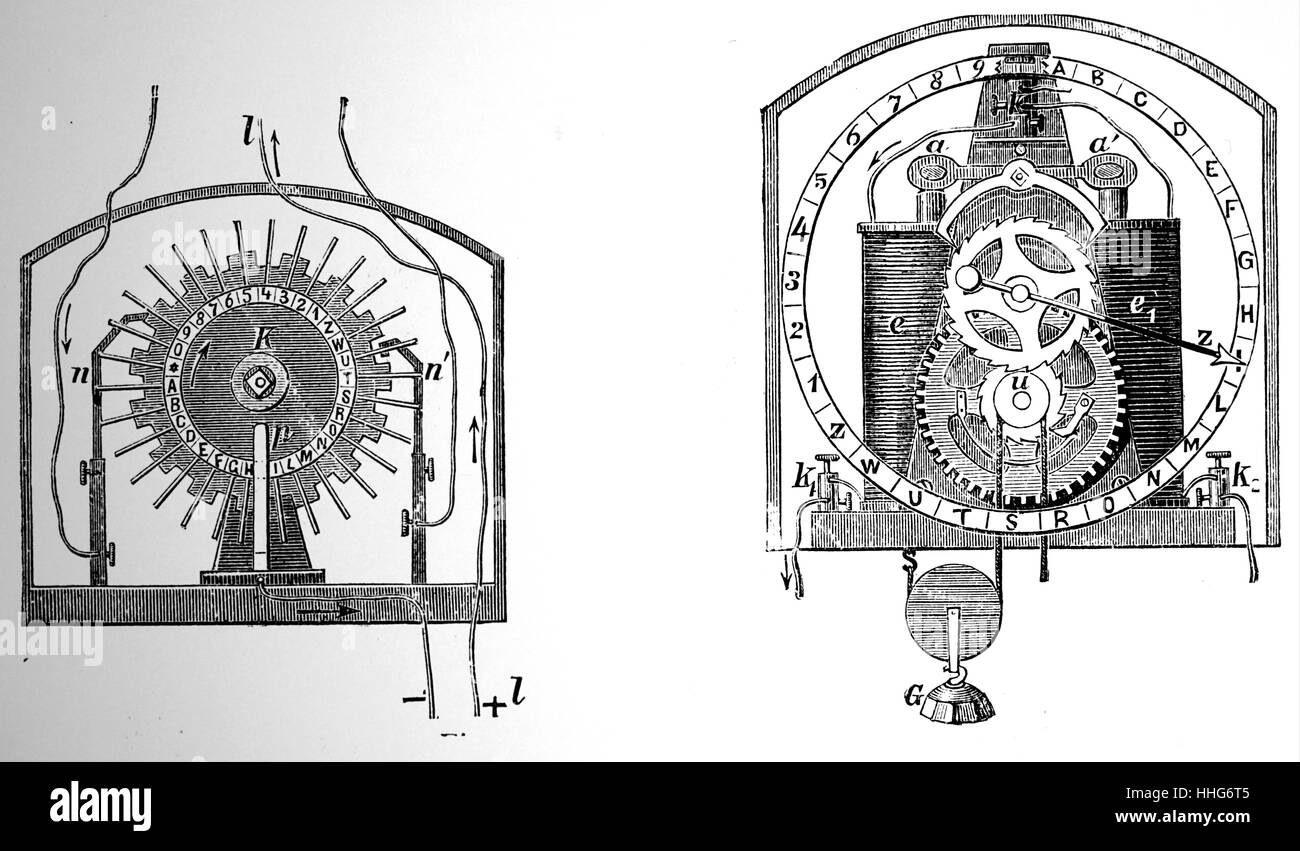 Wheatstone's needle (pointer) telegraph; the sender; left and receiver. 1890. Stock Photohttps://www.alamy.com/image-license-details/?v=1https://www.alamy.com/stock-photo-wheatstones-needle-pointer-telegraph-the-sender-left-and-receiver-131278341.html
Wheatstone's needle (pointer) telegraph; the sender; left and receiver. 1890. Stock Photohttps://www.alamy.com/image-license-details/?v=1https://www.alamy.com/stock-photo-wheatstones-needle-pointer-telegraph-the-sender-left-and-receiver-131278341.htmlRMHHG6T5–Wheatstone's needle (pointer) telegraph; the sender; left and receiver. 1890.
 Sir Charles Wheatstone 1802 1875 English scientist inventor Victorian era science Spectroscopy Telegraph Velocity electricity Stock Photohttps://www.alamy.com/image-license-details/?v=1https://www.alamy.com/stock-photo-sir-charles-wheatstone-1802-1875-english-scientist-inventor-victorian-41314141.html
Sir Charles Wheatstone 1802 1875 English scientist inventor Victorian era science Spectroscopy Telegraph Velocity electricity Stock Photohttps://www.alamy.com/image-license-details/?v=1https://www.alamy.com/stock-photo-sir-charles-wheatstone-1802-1875-english-scientist-inventor-victorian-41314141.htmlRMCB60H1–Sir Charles Wheatstone 1802 1875 English scientist inventor Victorian era science Spectroscopy Telegraph Velocity electricity
 Cooke and Wheatstone's single needle telegraph showing; left ; the front elevation with the alphabet and right the rear elevation and the galvanometer (G) and the commutator. 1874. Stock Photohttps://www.alamy.com/image-license-details/?v=1https://www.alamy.com/stock-photo-cooke-and-wheatstones-single-needle-telegraph-showing-left-the-front-131278320.html
Cooke and Wheatstone's single needle telegraph showing; left ; the front elevation with the alphabet and right the rear elevation and the galvanometer (G) and the commutator. 1874. Stock Photohttps://www.alamy.com/image-license-details/?v=1https://www.alamy.com/stock-photo-cooke-and-wheatstones-single-needle-telegraph-showing-left-the-front-131278320.htmlRMHHG6RC–Cooke and Wheatstone's single needle telegraph showing; left ; the front elevation with the alphabet and right the rear elevation and the galvanometer (G) and the commutator. 1874.
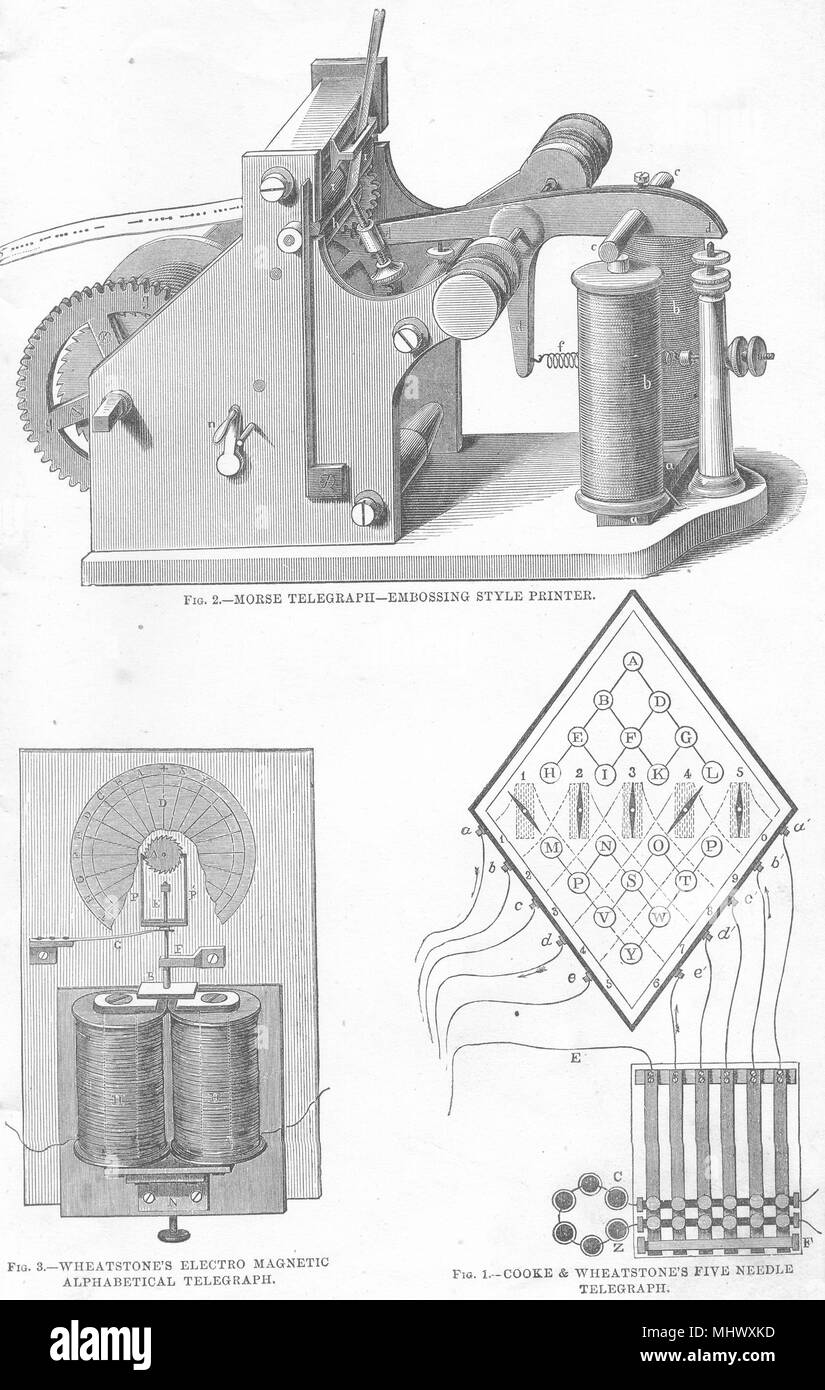 TELEGRAPHS. Cooke Wheatstone 5 needle; Morse; Electro magnetic Alphabetical 1880 Stock Photohttps://www.alamy.com/image-license-details/?v=1https://www.alamy.com/telegraphs-cooke-wheatstone-5-needle-morse-electro-magnetic-alphabetical-1880-image183122561.html
TELEGRAPHS. Cooke Wheatstone 5 needle; Morse; Electro magnetic Alphabetical 1880 Stock Photohttps://www.alamy.com/image-license-details/?v=1https://www.alamy.com/telegraphs-cooke-wheatstone-5-needle-morse-electro-magnetic-alphabetical-1880-image183122561.htmlRFMHWXKD–TELEGRAPHS. Cooke Wheatstone 5 needle; Morse; Electro magnetic Alphabetical 1880
 Cooke & Wheatstone's double needle telegraph. The letters of the alphabet and a variety of conventional signals; were indicated by single and combined movements of the galvanometer needles. The operator worked the instrument by manipulating the two handles at the bottom and an alarm bell was housed in the upper casing and was used to signal the beginning of a message. Stock Photohttps://www.alamy.com/image-license-details/?v=1https://www.alamy.com/stock-photo-cooke-wheatstones-double-needle-telegraph-the-letters-of-the-alphabet-131278292.html
Cooke & Wheatstone's double needle telegraph. The letters of the alphabet and a variety of conventional signals; were indicated by single and combined movements of the galvanometer needles. The operator worked the instrument by manipulating the two handles at the bottom and an alarm bell was housed in the upper casing and was used to signal the beginning of a message. Stock Photohttps://www.alamy.com/image-license-details/?v=1https://www.alamy.com/stock-photo-cooke-wheatstones-double-needle-telegraph-the-letters-of-the-alphabet-131278292.htmlRMHHG6PC–Cooke & Wheatstone's double needle telegraph. The letters of the alphabet and a variety of conventional signals; were indicated by single and combined movements of the galvanometer needles. The operator worked the instrument by manipulating the two handles at the bottom and an alarm bell was housed in the upper casing and was used to signal the beginning of a message.
 Sir Charles Wheatstone portrait, 1802 – 1875, was an English scientist and inventor of many scientific breakthroughs of the Victorian era, vintage engraving from 1867 Stock Photohttps://www.alamy.com/image-license-details/?v=1https://www.alamy.com/sir-charles-wheatstone-portrait-1802-1875-was-an-english-scientist-and-inventor-of-many-scientific-breakthroughs-of-the-victorian-era-vintage-engraving-from-1867-image544091707.html
Sir Charles Wheatstone portrait, 1802 – 1875, was an English scientist and inventor of many scientific breakthroughs of the Victorian era, vintage engraving from 1867 Stock Photohttps://www.alamy.com/image-license-details/?v=1https://www.alamy.com/sir-charles-wheatstone-portrait-1802-1875-was-an-english-scientist-and-inventor-of-many-scientific-breakthroughs-of-the-victorian-era-vintage-engraving-from-1867-image544091707.htmlRM2PH5EEK–Sir Charles Wheatstone portrait, 1802 – 1875, was an English scientist and inventor of many scientific breakthroughs of the Victorian era, vintage engraving from 1867
 Engraving of young women operating telegraph machines at an English post office, circa 1890 Stock Photohttps://www.alamy.com/image-license-details/?v=1https://www.alamy.com/engraving-of-young-women-operating-telegraph-machines-at-an-english-post-office-circa-1890-image433147643.html
Engraving of young women operating telegraph machines at an English post office, circa 1890 Stock Photohttps://www.alamy.com/image-license-details/?v=1https://www.alamy.com/engraving-of-young-women-operating-telegraph-machines-at-an-english-post-office-circa-1890-image433147643.htmlRM2G4KG6K–Engraving of young women operating telegraph machines at an English post office, circa 1890
 a needle telegraph produced by Charles Wheatstone / ein Zeigertelegraf von Charles Wheatstone, historisch, historical, digital improved reproduction of an original from the 19th century / digitale Reproduktion einer Originalvorlage aus dem 19. Jahrhundert, Originaldatum nicht bekannt, koloriert, handcoloriert, Koloration Stock Photohttps://www.alamy.com/image-license-details/?v=1https://www.alamy.com/a-needle-telegraph-produced-by-charles-wheatstone-ein-zeigertelegraf-von-charles-wheatstone-historisch-historical-digital-improved-reproduction-of-an-original-from-the-19th-century-digitale-reproduktion-einer-originalvorlage-aus-dem-19-jahrhundert-originaldatum-nicht-bekannt-koloriert-handcoloriert-koloration-image428738657.html
a needle telegraph produced by Charles Wheatstone / ein Zeigertelegraf von Charles Wheatstone, historisch, historical, digital improved reproduction of an original from the 19th century / digitale Reproduktion einer Originalvorlage aus dem 19. Jahrhundert, Originaldatum nicht bekannt, koloriert, handcoloriert, Koloration Stock Photohttps://www.alamy.com/image-license-details/?v=1https://www.alamy.com/a-needle-telegraph-produced-by-charles-wheatstone-ein-zeigertelegraf-von-charles-wheatstone-historisch-historical-digital-improved-reproduction-of-an-original-from-the-19th-century-digitale-reproduktion-einer-originalvorlage-aus-dem-19-jahrhundert-originaldatum-nicht-bekannt-koloriert-handcoloriert-koloration-image428738657.htmlRF2FWEMEW–a needle telegraph produced by Charles Wheatstone / ein Zeigertelegraf von Charles Wheatstone, historisch, historical, digital improved reproduction of an original from the 19th century / digitale Reproduktion einer Originalvorlage aus dem 19. Jahrhundert, Originaldatum nicht bekannt, koloriert, handcoloriert, Koloration
 England, London, South Kensington, Science Museum, Charles Wheatstone's Printing Telegraph Machine dated 1841 Stock Photohttps://www.alamy.com/image-license-details/?v=1https://www.alamy.com/stock-photo-england-london-south-kensington-science-museum-charles-wheatstones-143626979.html
England, London, South Kensington, Science Museum, Charles Wheatstone's Printing Telegraph Machine dated 1841 Stock Photohttps://www.alamy.com/image-license-details/?v=1https://www.alamy.com/stock-photo-england-london-south-kensington-science-museum-charles-wheatstones-143626979.htmlRMJ9JNJY–England, London, South Kensington, Science Museum, Charles Wheatstone's Printing Telegraph Machine dated 1841
 Pointer telegraph of Wheatstone, left the transmitter, right the receiver / Zeigertelegraf von Wheatstone, links der Zeichengeber, rechts der Empfangsapparat, Historisch, historical, digital improved reproduction of an original from the 19th century / digitale Reproduktion einer Originalvorlage aus dem 19. Jahrhundert Stock Photohttps://www.alamy.com/image-license-details/?v=1https://www.alamy.com/pointer-telegraph-of-wheatstone-left-the-transmitter-right-the-receiver-zeigertelegraf-von-wheatstone-links-der-zeichengeber-rechts-der-empfangsapparat-historisch-historical-digital-improved-reproduction-of-an-original-from-the-19th-century-digitale-reproduktion-einer-originalvorlage-aus-dem-19-jahrhundert-image383525190.html
Pointer telegraph of Wheatstone, left the transmitter, right the receiver / Zeigertelegraf von Wheatstone, links der Zeichengeber, rechts der Empfangsapparat, Historisch, historical, digital improved reproduction of an original from the 19th century / digitale Reproduktion einer Originalvorlage aus dem 19. Jahrhundert Stock Photohttps://www.alamy.com/image-license-details/?v=1https://www.alamy.com/pointer-telegraph-of-wheatstone-left-the-transmitter-right-the-receiver-zeigertelegraf-von-wheatstone-links-der-zeichengeber-rechts-der-empfangsapparat-historisch-historical-digital-improved-reproduction-of-an-original-from-the-19th-century-digitale-reproduktion-einer-originalvorlage-aus-dem-19-jahrhundert-image383525190.htmlRF2D7Y286–Pointer telegraph of Wheatstone, left the transmitter, right the receiver / Zeigertelegraf von Wheatstone, links der Zeichengeber, rechts der Empfangsapparat, Historisch, historical, digital improved reproduction of an original from the 19th century / digitale Reproduktion einer Originalvorlage aus dem 19. Jahrhundert
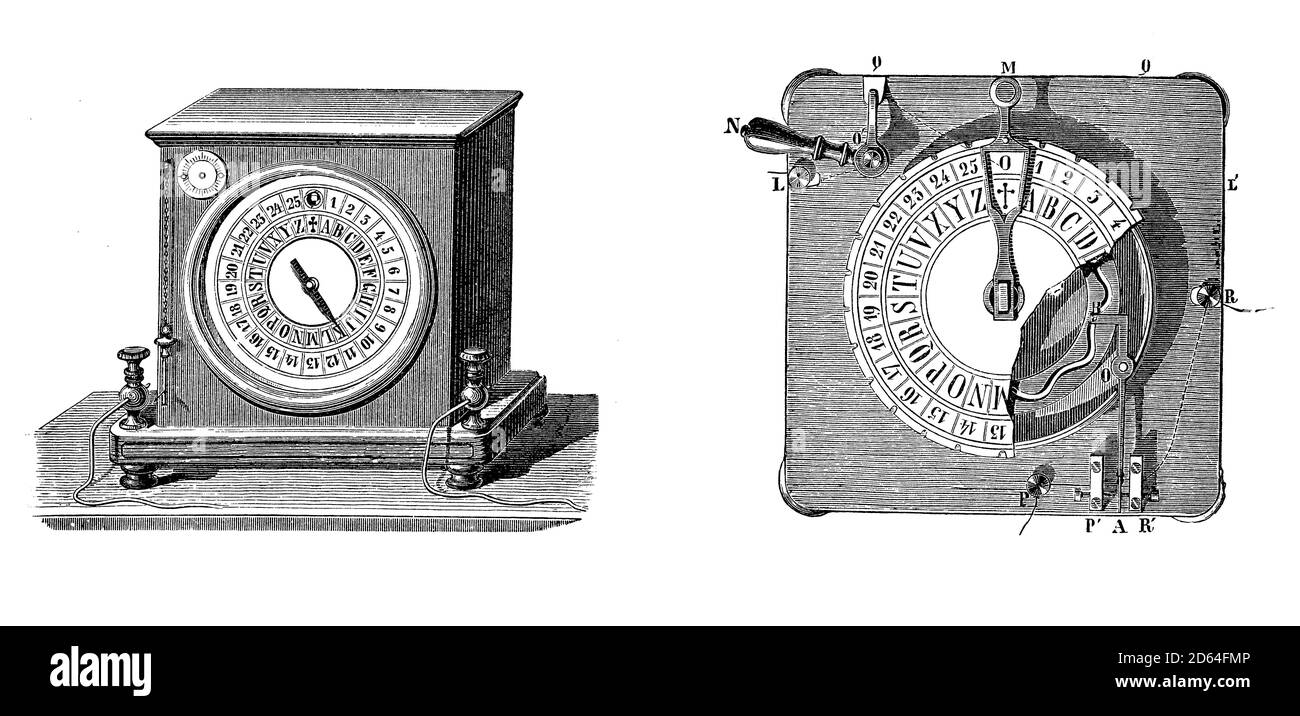 Vintage technology: telegraph receiver by Wheatstone and Cooke from 1830, the first telegraph system put in commercial service, with no need to learn a code and without investing in staff training: several needles moved by electromagnetic coils point to letters Stock Photohttps://www.alamy.com/image-license-details/?v=1https://www.alamy.com/vintage-technology-telegraph-receiver-by-wheatstone-and-cooke-from-1830-the-first-telegraph-system-put-in-commercial-service-with-no-need-to-learn-a-code-and-without-investing-in-staff-training-several-needles-moved-by-electromagnetic-coils-point-to-letters-image382416182.html
Vintage technology: telegraph receiver by Wheatstone and Cooke from 1830, the first telegraph system put in commercial service, with no need to learn a code and without investing in staff training: several needles moved by electromagnetic coils point to letters Stock Photohttps://www.alamy.com/image-license-details/?v=1https://www.alamy.com/vintage-technology-telegraph-receiver-by-wheatstone-and-cooke-from-1830-the-first-telegraph-system-put-in-commercial-service-with-no-need-to-learn-a-code-and-without-investing-in-staff-training-several-needles-moved-by-electromagnetic-coils-point-to-letters-image382416182.htmlRF2D64FMP–Vintage technology: telegraph receiver by Wheatstone and Cooke from 1830, the first telegraph system put in commercial service, with no need to learn a code and without investing in staff training: several needles moved by electromagnetic coils point to letters
 Simple Needle telegraph from Cooke and Wheatstone, Stock Photohttps://www.alamy.com/image-license-details/?v=1https://www.alamy.com/simple-needle-telegraph-from-cooke-and-wheatstone-image222560366.html
Simple Needle telegraph from Cooke and Wheatstone, Stock Photohttps://www.alamy.com/image-license-details/?v=1https://www.alamy.com/simple-needle-telegraph-from-cooke-and-wheatstone-image222560366.htmlRMPX2E0E–Simple Needle telegraph from Cooke and Wheatstone,
 WHEATSTONE Stock Photohttps://www.alamy.com/image-license-details/?v=1https://www.alamy.com/stock-photo-wheatstone-105263591.html
WHEATSTONE Stock Photohttps://www.alamy.com/image-license-details/?v=1https://www.alamy.com/stock-photo-wheatstone-105263591.htmlRMG374NY–WHEATSTONE
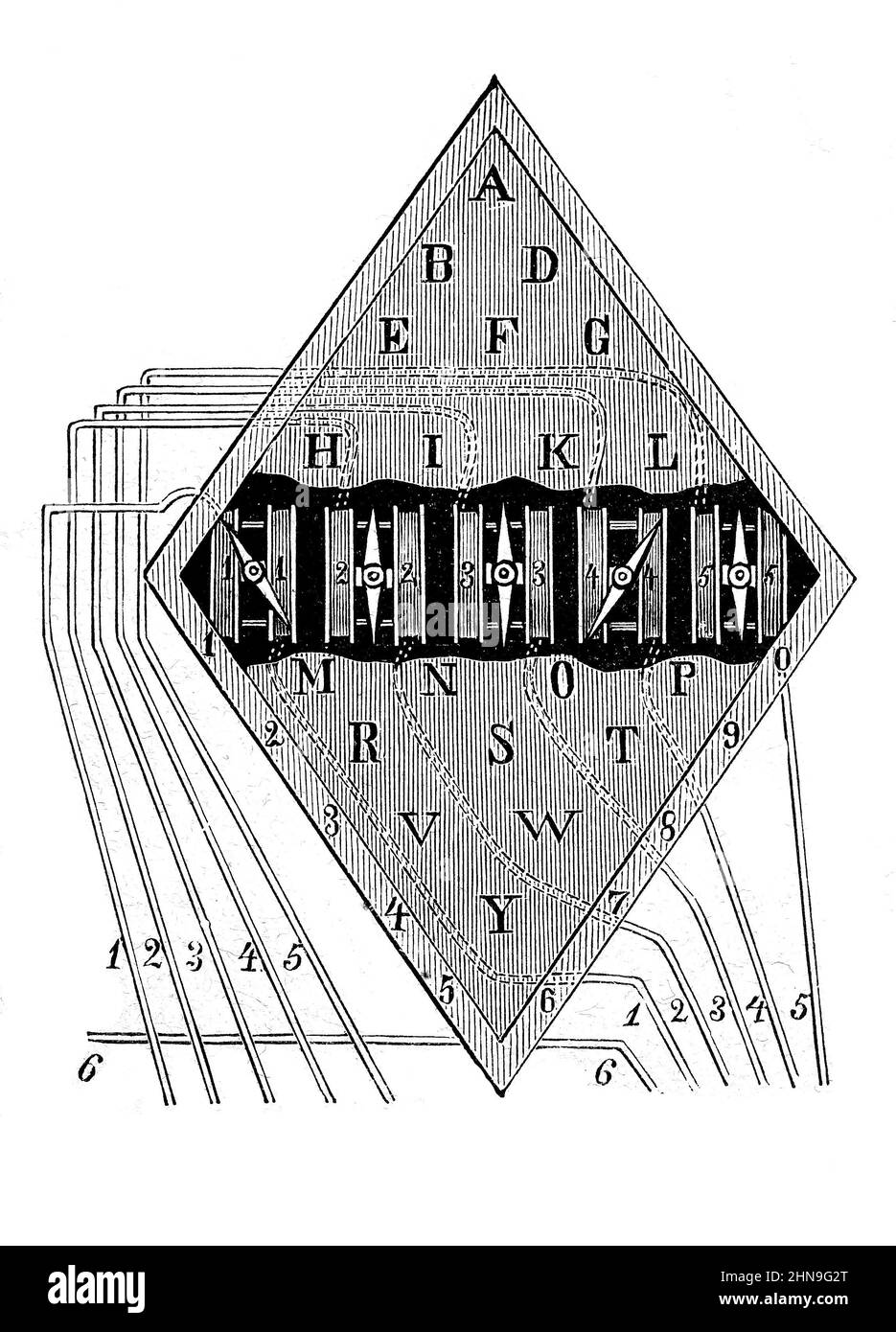 Nadeltelegraf, ein historischer Telegrafenapparat, von Cooke und Wheatstone, mit fünf Nadeln / Needle telegraph, a historical telegraph apparatus, by Cooke and Wheatstone, with five needles, Historisch, historical, digital improved reproduction of an original from the 19th century / digital restaurierte Reproduktion einer Originalvorlage aus dem 19. Jahrhundert, genaues Originaldatum nicht bekannt Stock Photohttps://www.alamy.com/image-license-details/?v=1https://www.alamy.com/nadeltelegraf-ein-historischer-telegrafenapparat-von-cooke-und-wheatstone-mit-fnf-nadeln-needle-telegraph-a-historical-telegraph-apparatus-by-cooke-and-wheatstone-with-five-needles-historisch-historical-digital-improved-reproduction-of-an-original-from-the-19th-century-digital-restaurierte-reproduktion-einer-originalvorlage-aus-dem-19-jahrhundert-genaues-originaldatum-nicht-bekannt-image460587536.html
Nadeltelegraf, ein historischer Telegrafenapparat, von Cooke und Wheatstone, mit fünf Nadeln / Needle telegraph, a historical telegraph apparatus, by Cooke and Wheatstone, with five needles, Historisch, historical, digital improved reproduction of an original from the 19th century / digital restaurierte Reproduktion einer Originalvorlage aus dem 19. Jahrhundert, genaues Originaldatum nicht bekannt Stock Photohttps://www.alamy.com/image-license-details/?v=1https://www.alamy.com/nadeltelegraf-ein-historischer-telegrafenapparat-von-cooke-und-wheatstone-mit-fnf-nadeln-needle-telegraph-a-historical-telegraph-apparatus-by-cooke-and-wheatstone-with-five-needles-historisch-historical-digital-improved-reproduction-of-an-original-from-the-19th-century-digital-restaurierte-reproduktion-einer-originalvorlage-aus-dem-19-jahrhundert-genaues-originaldatum-nicht-bekannt-image460587536.htmlRF2HN9G2T–Nadeltelegraf, ein historischer Telegrafenapparat, von Cooke und Wheatstone, mit fünf Nadeln / Needle telegraph, a historical telegraph apparatus, by Cooke and Wheatstone, with five needles, Historisch, historical, digital improved reproduction of an original from the 19th century / digital restaurierte Reproduktion einer Originalvorlage aus dem 19. Jahrhundert, genaues Originaldatum nicht bekannt
 COOKE/WHEATSTONE TELEGR. Stock Photohttps://www.alamy.com/image-license-details/?v=1https://www.alamy.com/stock-photo-cookewheatstone-telegr-105348997.html
COOKE/WHEATSTONE TELEGR. Stock Photohttps://www.alamy.com/image-license-details/?v=1https://www.alamy.com/stock-photo-cookewheatstone-telegr-105348997.htmlRMG3B1M5–COOKE/WHEATSTONE TELEGR.
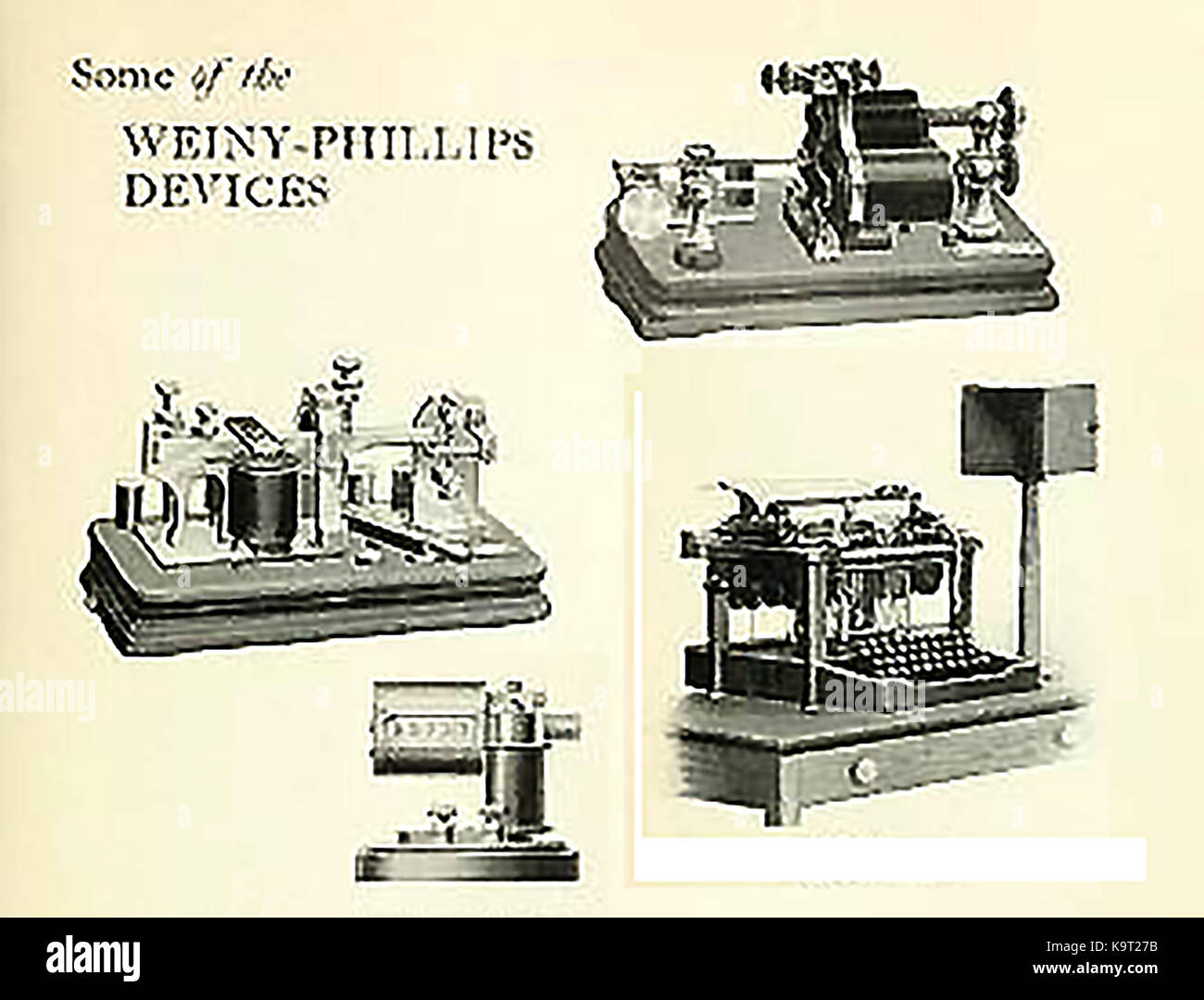 1897 - A selection of Weiny-Phillips telegraphy devices Stock Photohttps://www.alamy.com/image-license-details/?v=1https://www.alamy.com/stock-image-1897-a-selection-of-weiny-phillips-telegraphy-devices-160953839.html
1897 - A selection of Weiny-Phillips telegraphy devices Stock Photohttps://www.alamy.com/image-license-details/?v=1https://www.alamy.com/stock-image-1897-a-selection-of-weiny-phillips-telegraphy-devices-160953839.htmlRMK9T27B–1897 - A selection of Weiny-Phillips telegraphy devices
 Variety of Telegraph machinery Stock Photohttps://www.alamy.com/image-license-details/?v=1https://www.alamy.com/variety-of-telegraph-machinery-image256554594.html
Variety of Telegraph machinery Stock Photohttps://www.alamy.com/image-license-details/?v=1https://www.alamy.com/variety-of-telegraph-machinery-image256554594.htmlRMTWB202–Variety of Telegraph machinery
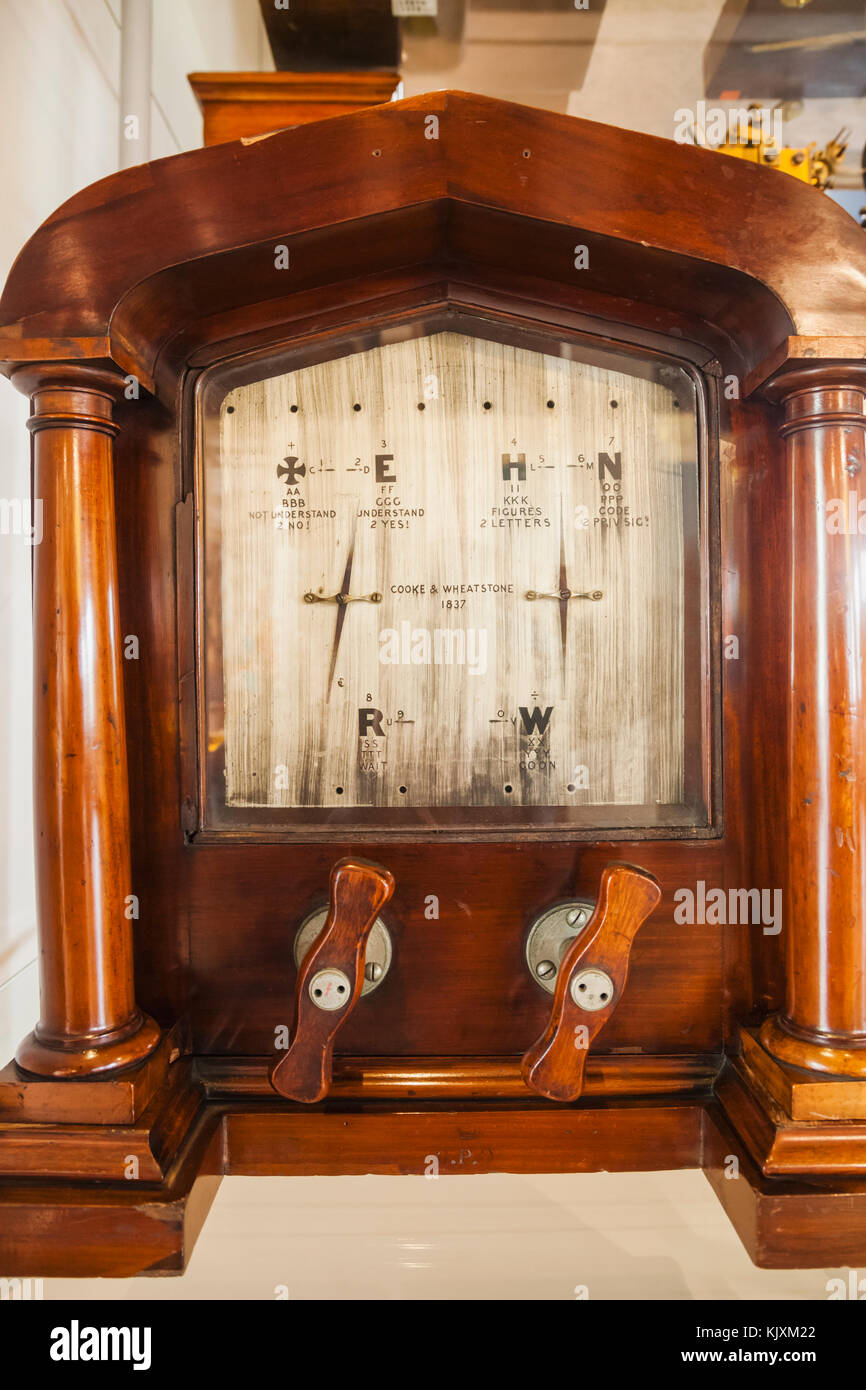 England, Cooke & Wheatstone Double-Needle Telegraph Machine dated 1844 Stock Photohttps://www.alamy.com/image-license-details/?v=1https://www.alamy.com/stock-image-england-cooke-wheatstone-double-needle-telegraph-machine-dated-1844-166543610.html
England, Cooke & Wheatstone Double-Needle Telegraph Machine dated 1844 Stock Photohttps://www.alamy.com/image-license-details/?v=1https://www.alamy.com/stock-image-england-cooke-wheatstone-double-needle-telegraph-machine-dated-1844-166543610.htmlRMKJXM22–England, Cooke & Wheatstone Double-Needle Telegraph Machine dated 1844
 EB1911 Telegraph Wheatstone Automatic Transmitter Stock Photohttps://www.alamy.com/image-license-details/?v=1https://www.alamy.com/stock-image-eb1911-telegraph-wheatstone-automatic-transmitter-162264998.html
EB1911 Telegraph Wheatstone Automatic Transmitter Stock Photohttps://www.alamy.com/image-license-details/?v=1https://www.alamy.com/stock-image-eb1911-telegraph-wheatstone-automatic-transmitter-162264998.htmlRMKBYPJE–EB1911 Telegraph Wheatstone Automatic Transmitter
 Opening of the London to Paris telegraph link. Instrument room at the Submarine Telegraph Company, Cornhill, London, showing the Wheatstone needle telegraph instruments. From The Illustrated London News, 13 November 1852 Stock Photohttps://www.alamy.com/image-license-details/?v=1https://www.alamy.com/opening-of-the-london-to-paris-telegraph-link-instrument-room-at-the-submarine-telegraph-company-cornhill-london-showing-the-wheatstone-needle-telegraph-instruments-from-the-illustrated-london-news-13-november-1852-image483534615.html
Opening of the London to Paris telegraph link. Instrument room at the Submarine Telegraph Company, Cornhill, London, showing the Wheatstone needle telegraph instruments. From The Illustrated London News, 13 November 1852 Stock Photohttps://www.alamy.com/image-license-details/?v=1https://www.alamy.com/opening-of-the-london-to-paris-telegraph-link-instrument-room-at-the-submarine-telegraph-company-cornhill-london-showing-the-wheatstone-needle-telegraph-instruments-from-the-illustrated-london-news-13-november-1852-image483534615.htmlRM2K2JW9B–Opening of the London to Paris telegraph link. Instrument room at the Submarine Telegraph Company, Cornhill, London, showing the Wheatstone needle telegraph instruments. From The Illustrated London News, 13 November 1852
 William Fothergill Cooke (1806-1879), with Charles Wheatstone, invented the Cooke-Wheatstone electrical telegraph, patented in 1837. It differed from the Morse telegraph in that the receiver pointed to letters, which spared operators the task of translating code. Stock Photohttps://www.alamy.com/image-license-details/?v=1https://www.alamy.com/stock-photo-william-fothergill-cooke-1806-1879-with-charles-wheatstone-invented-38133479.html
William Fothergill Cooke (1806-1879), with Charles Wheatstone, invented the Cooke-Wheatstone electrical telegraph, patented in 1837. It differed from the Morse telegraph in that the receiver pointed to letters, which spared operators the task of translating code. Stock Photohttps://www.alamy.com/image-license-details/?v=1https://www.alamy.com/stock-photo-william-fothergill-cooke-1806-1879-with-charles-wheatstone-invented-38133479.htmlRMC613HY–William Fothergill Cooke (1806-1879), with Charles Wheatstone, invented the Cooke-Wheatstone electrical telegraph, patented in 1837. It differed from the Morse telegraph in that the receiver pointed to letters, which spared operators the task of translating code.
![Sir Charles Wheatstone, professor of Experimental Philosophy, King's College, 1868. Engraving from a photograph by Messrs Hills and Saunders, of '...one of the most eminently successful professors of experimental science...a very able teacher and inventor; the joint author, with Mr. Cooke, of the electric telegraph; and the precursor of Sir David Brewster in the invention of the stereoscope...[In 1834] he produced a report on some experiments in measuring the speed of electric currents and the duration of the electric light...Having made a special investigation in the department of optics, he Stock Photo Sir Charles Wheatstone, professor of Experimental Philosophy, King's College, 1868. Engraving from a photograph by Messrs Hills and Saunders, of '...one of the most eminently successful professors of experimental science...a very able teacher and inventor; the joint author, with Mr. Cooke, of the electric telegraph; and the precursor of Sir David Brewster in the invention of the stereoscope...[In 1834] he produced a report on some experiments in measuring the speed of electric currents and the duration of the electric light...Having made a special investigation in the department of optics, he Stock Photo](https://c8.alamy.com/comp/2XAP6MT/sir-charles-wheatstone-professor-of-experimental-philosophy-kings-college-1868-engraving-from-a-photograph-by-messrs-hills-and-saunders-of-one-of-the-most-eminently-successful-professors-of-experimental-sciencea-very-able-teacher-and-inventor-the-joint-author-with-mr-cooke-of-the-electric-telegraph-and-the-precursor-of-sir-david-brewster-in-the-invention-of-the-stereoscope-in-1834-he-produced-a-report-on-some-experiments-in-measuring-the-speed-of-electric-currents-and-the-duration-of-the-electric-lighthaving-made-a-special-investigation-in-the-department-of-optics-he-2XAP6MT.jpg) Sir Charles Wheatstone, professor of Experimental Philosophy, King's College, 1868. Engraving from a photograph by Messrs Hills and Saunders, of '...one of the most eminently successful professors of experimental science...a very able teacher and inventor; the joint author, with Mr. Cooke, of the electric telegraph; and the precursor of Sir David Brewster in the invention of the stereoscope...[In 1834] he produced a report on some experiments in measuring the speed of electric currents and the duration of the electric light...Having made a special investigation in the department of optics, he Stock Photohttps://www.alamy.com/image-license-details/?v=1https://www.alamy.com/sir-charles-wheatstone-professor-of-experimental-philosophy-kings-college-1868-engraving-from-a-photograph-by-messrs-hills-and-saunders-of-one-of-the-most-eminently-successful-professors-of-experimental-sciencea-very-able-teacher-and-inventor-the-joint-author-with-mr-cooke-of-the-electric-telegraph-and-the-precursor-of-sir-david-brewster-in-the-invention-of-the-stereoscope-in-1834-he-produced-a-report-on-some-experiments-in-measuring-the-speed-of-electric-currents-and-the-duration-of-the-electric-lighthaving-made-a-special-investigation-in-the-department-of-optics-he-image608997672.html
Sir Charles Wheatstone, professor of Experimental Philosophy, King's College, 1868. Engraving from a photograph by Messrs Hills and Saunders, of '...one of the most eminently successful professors of experimental science...a very able teacher and inventor; the joint author, with Mr. Cooke, of the electric telegraph; and the precursor of Sir David Brewster in the invention of the stereoscope...[In 1834] he produced a report on some experiments in measuring the speed of electric currents and the duration of the electric light...Having made a special investigation in the department of optics, he Stock Photohttps://www.alamy.com/image-license-details/?v=1https://www.alamy.com/sir-charles-wheatstone-professor-of-experimental-philosophy-kings-college-1868-engraving-from-a-photograph-by-messrs-hills-and-saunders-of-one-of-the-most-eminently-successful-professors-of-experimental-sciencea-very-able-teacher-and-inventor-the-joint-author-with-mr-cooke-of-the-electric-telegraph-and-the-precursor-of-sir-david-brewster-in-the-invention-of-the-stereoscope-in-1834-he-produced-a-report-on-some-experiments-in-measuring-the-speed-of-electric-currents-and-the-duration-of-the-electric-lighthaving-made-a-special-investigation-in-the-department-of-optics-he-image608997672.htmlRM2XAP6MT–Sir Charles Wheatstone, professor of Experimental Philosophy, King's College, 1868. Engraving from a photograph by Messrs Hills and Saunders, of '...one of the most eminently successful professors of experimental science...a very able teacher and inventor; the joint author, with Mr. Cooke, of the electric telegraph; and the precursor of Sir David Brewster in the invention of the stereoscope...[In 1834] he produced a report on some experiments in measuring the speed of electric currents and the duration of the electric light...Having made a special investigation in the department of optics, he
 Gothenburg. Interior from Gothenburg's telegraph stone around 1930. Wheatstone-Creedavd. Stock Photohttps://www.alamy.com/image-license-details/?v=1https://www.alamy.com/gothenburg-interior-from-gothenburgs-telegraph-stone-around-1930-wheatstone-creedavd-image417497554.html
Gothenburg. Interior from Gothenburg's telegraph stone around 1930. Wheatstone-Creedavd. Stock Photohttps://www.alamy.com/image-license-details/?v=1https://www.alamy.com/gothenburg-interior-from-gothenburgs-telegraph-stone-around-1930-wheatstone-creedavd-image417497554.htmlRM2F76JAX–Gothenburg. Interior from Gothenburg's telegraph stone around 1930. Wheatstone-Creedavd.
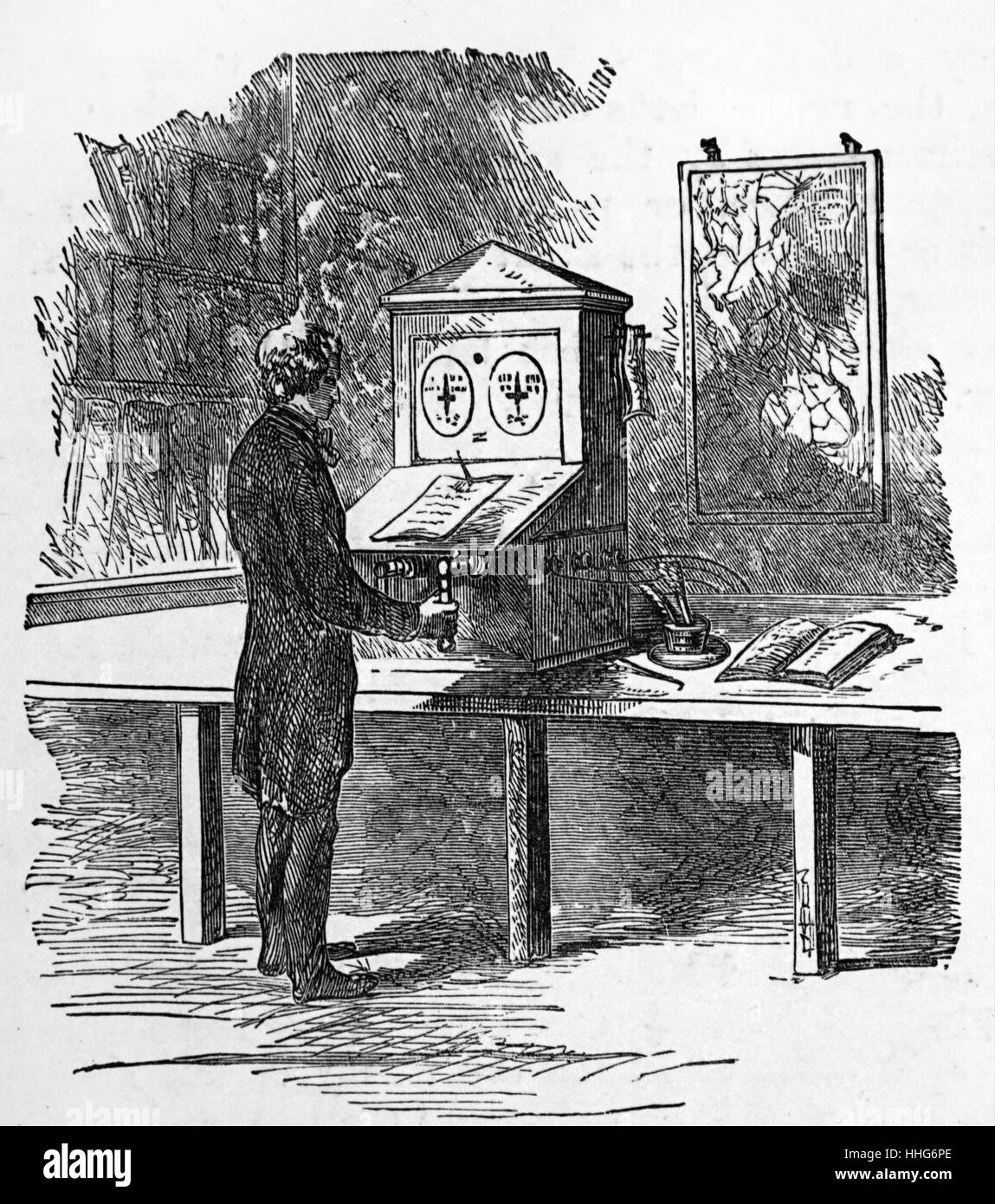 Cooke & Wheatstone's double needle telegraph. The letters of the alphabet and a variety of conventional signals; were indicated by single and combined movements of the galvanometer needles. The operator worked the instrument by manipulating the two handles at the bottom and an alarm bell was housed in the upper casing and was used to signal the beginning of a message. Stock Photohttps://www.alamy.com/image-license-details/?v=1https://www.alamy.com/stock-photo-cooke-wheatstones-double-needle-telegraph-the-letters-of-the-alphabet-131278294.html
Cooke & Wheatstone's double needle telegraph. The letters of the alphabet and a variety of conventional signals; were indicated by single and combined movements of the galvanometer needles. The operator worked the instrument by manipulating the two handles at the bottom and an alarm bell was housed in the upper casing and was used to signal the beginning of a message. Stock Photohttps://www.alamy.com/image-license-details/?v=1https://www.alamy.com/stock-photo-cooke-wheatstones-double-needle-telegraph-the-letters-of-the-alphabet-131278294.htmlRMHHG6PE–Cooke & Wheatstone's double needle telegraph. The letters of the alphabet and a variety of conventional signals; were indicated by single and combined movements of the galvanometer needles. The operator worked the instrument by manipulating the two handles at the bottom and an alarm bell was housed in the upper casing and was used to signal the beginning of a message.
 Rear view of Charles Wheatstone's electric (railway) telegraph, 1850. Artist: Unknown Stock Photohttps://www.alamy.com/image-license-details/?v=1https://www.alamy.com/rear-view-of-charles-wheatstones-electric-railway-telegraph-1850-artist-image8382855.html
Rear view of Charles Wheatstone's electric (railway) telegraph, 1850. Artist: Unknown Stock Photohttps://www.alamy.com/image-license-details/?v=1https://www.alamy.com/rear-view-of-charles-wheatstones-electric-railway-telegraph-1850-artist-image8382855.htmlRMAJ9YM8–Rear view of Charles Wheatstone's electric (railway) telegraph, 1850. Artist: Unknown
 Cooke & Wheatstone's double needle telegraph. The letters of the alphabet and a variety of conventional signals; were indicated by single and combined movements of the galvanometer needles. The operator worked the instrument by manipulating the two handles at the bottom and an alarm bell was housed in the upper casing and was used to signal the beginning of a message. Stock Photohttps://www.alamy.com/image-license-details/?v=1https://www.alamy.com/stock-photo-cooke-wheatstones-double-needle-telegraph-the-letters-of-the-alphabet-131278295.html
Cooke & Wheatstone's double needle telegraph. The letters of the alphabet and a variety of conventional signals; were indicated by single and combined movements of the galvanometer needles. The operator worked the instrument by manipulating the two handles at the bottom and an alarm bell was housed in the upper casing and was used to signal the beginning of a message. Stock Photohttps://www.alamy.com/image-license-details/?v=1https://www.alamy.com/stock-photo-cooke-wheatstones-double-needle-telegraph-the-letters-of-the-alphabet-131278295.htmlRMHHG6PF–Cooke & Wheatstone's double needle telegraph. The letters of the alphabet and a variety of conventional signals; were indicated by single and combined movements of the galvanometer needles. The operator worked the instrument by manipulating the two handles at the bottom and an alarm bell was housed in the upper casing and was used to signal the beginning of a message.
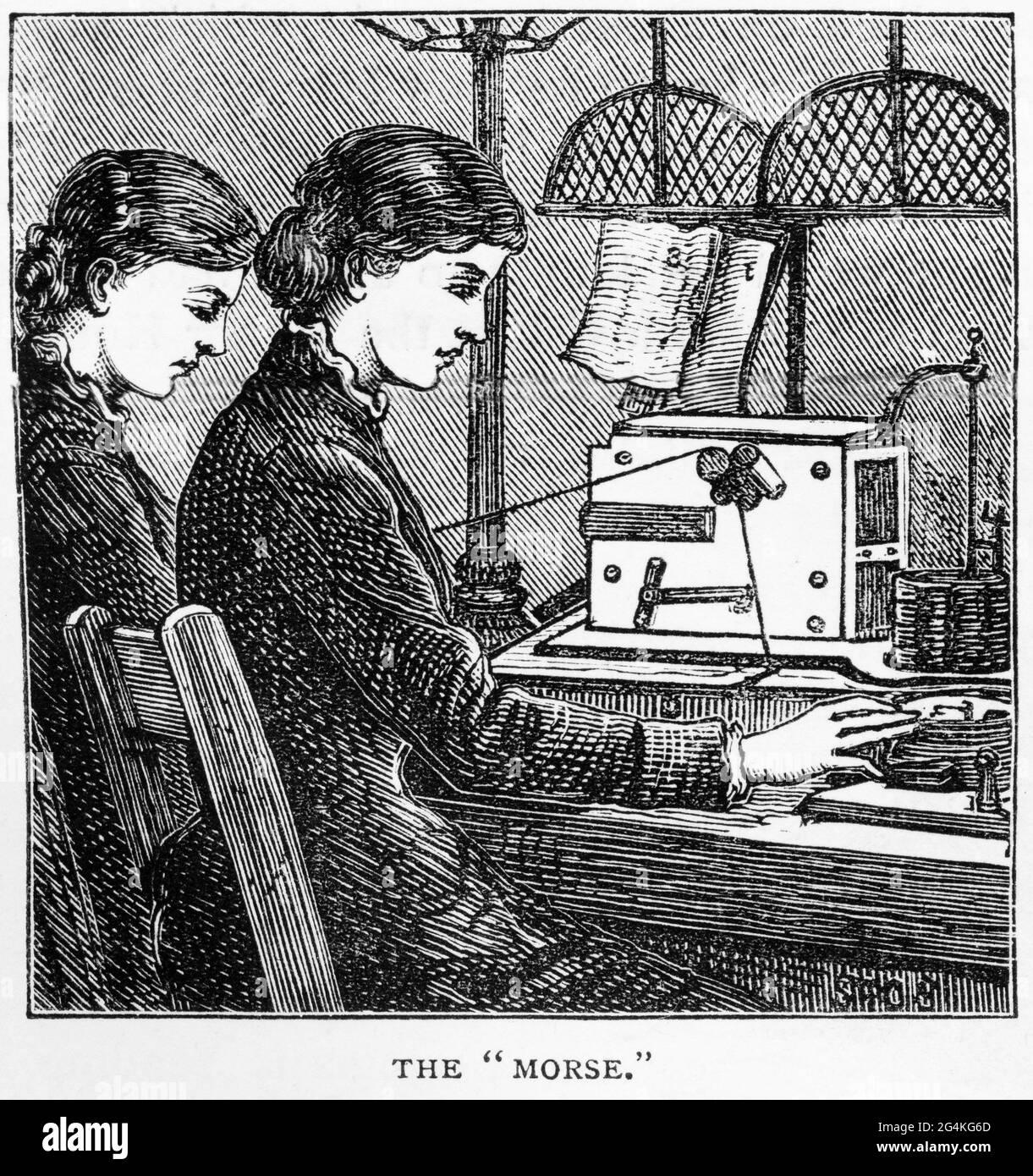 Engraving of young women operating telegraph machines and receiving morse code messages at an English post office, circa 1890 Stock Photohttps://www.alamy.com/image-license-details/?v=1https://www.alamy.com/engraving-of-young-women-operating-telegraph-machines-and-receiving-morse-code-messages-at-an-english-post-office-circa-1890-image433147637.html
Engraving of young women operating telegraph machines and receiving morse code messages at an English post office, circa 1890 Stock Photohttps://www.alamy.com/image-license-details/?v=1https://www.alamy.com/engraving-of-young-women-operating-telegraph-machines-and-receiving-morse-code-messages-at-an-english-post-office-circa-1890-image433147637.htmlRM2G4KG6D–Engraving of young women operating telegraph machines and receiving morse code messages at an English post office, circa 1890
 Cooke & Wheatstone's double needle telegraph. The letters of the alphabet and a variety of conventional signals; were indicated by single and combined movements of the galvanometer needles. The operator worked the instrument by manipulating the two handles at the bottom and an alarm bell was housed in the upper casing and was used to signal the beginning of a message. Stock Photohttps://www.alamy.com/image-license-details/?v=1https://www.alamy.com/stock-photo-cooke-wheatstones-double-needle-telegraph-the-letters-of-the-alphabet-131278298.html
Cooke & Wheatstone's double needle telegraph. The letters of the alphabet and a variety of conventional signals; were indicated by single and combined movements of the galvanometer needles. The operator worked the instrument by manipulating the two handles at the bottom and an alarm bell was housed in the upper casing and was used to signal the beginning of a message. Stock Photohttps://www.alamy.com/image-license-details/?v=1https://www.alamy.com/stock-photo-cooke-wheatstones-double-needle-telegraph-the-letters-of-the-alphabet-131278298.htmlRMHHG6PJ–Cooke & Wheatstone's double needle telegraph. The letters of the alphabet and a variety of conventional signals; were indicated by single and combined movements of the galvanometer needles. The operator worked the instrument by manipulating the two handles at the bottom and an alarm bell was housed in the upper casing and was used to signal the beginning of a message.
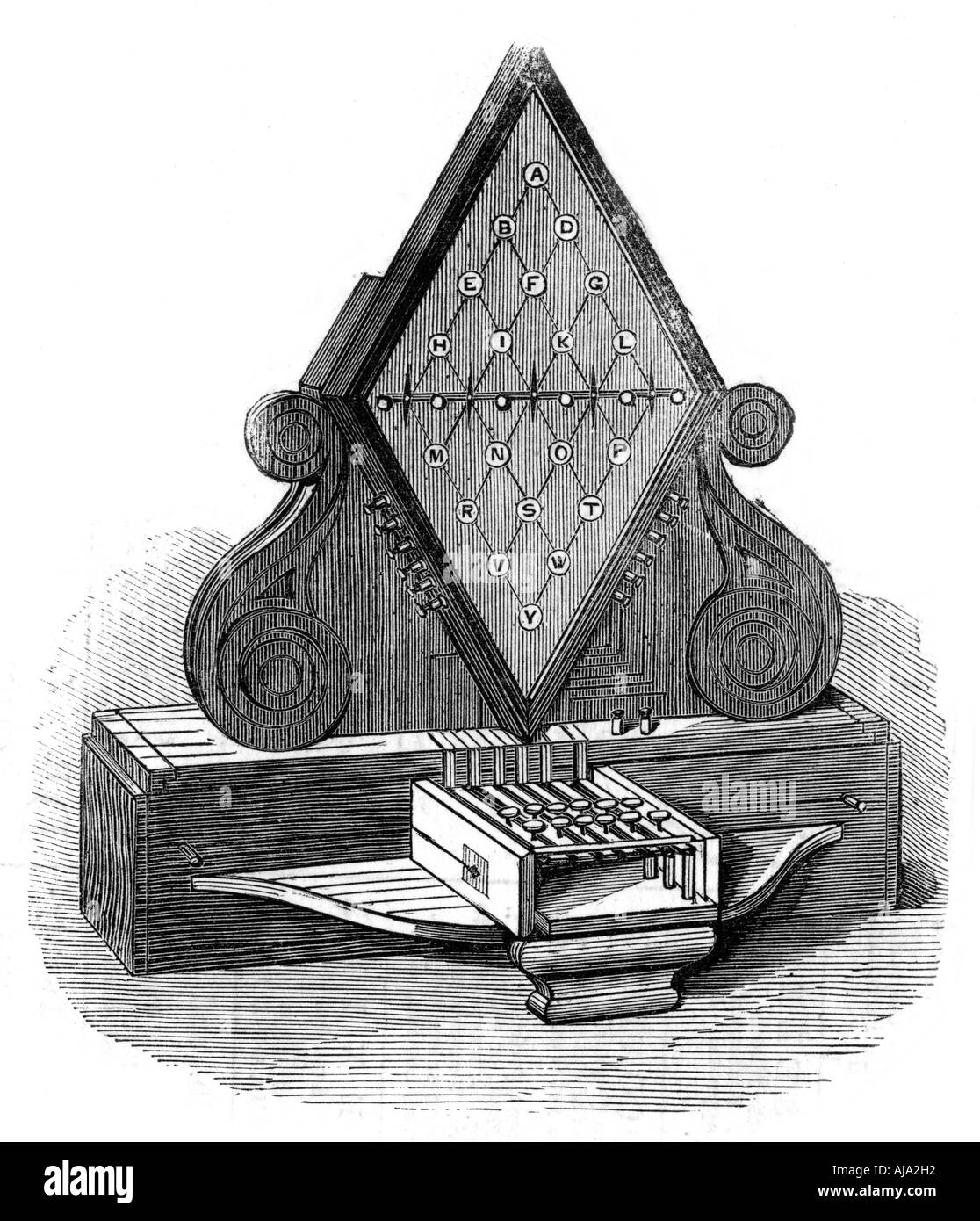 William Cooke and Charles Wheatstone's five-needle telegraph, patented 1837, (19th century). Artist: Unknown Stock Photohttps://www.alamy.com/image-license-details/?v=1https://www.alamy.com/william-cooke-and-charles-wheatstones-five-needle-telegraph-patented-image8383377.html
William Cooke and Charles Wheatstone's five-needle telegraph, patented 1837, (19th century). Artist: Unknown Stock Photohttps://www.alamy.com/image-license-details/?v=1https://www.alamy.com/william-cooke-and-charles-wheatstones-five-needle-telegraph-patented-image8383377.htmlRMAJA2H2–William Cooke and Charles Wheatstone's five-needle telegraph, patented 1837, (19th century). Artist: Unknown
 Cooke & Wheatstone's double needle telegraph. The letters of the alphabet and a variety of conventional signals; were indicated by single and combined movements of the galvanometer needles. The operator worked the instrument by manipulating the two handles at the bottom and an alarm bell was housed in the upper casing and was used to signal the beginning of a message. Stock Photohttps://www.alamy.com/image-license-details/?v=1https://www.alamy.com/stock-photo-cooke-wheatstones-double-needle-telegraph-the-letters-of-the-alphabet-131278296.html
Cooke & Wheatstone's double needle telegraph. The letters of the alphabet and a variety of conventional signals; were indicated by single and combined movements of the galvanometer needles. The operator worked the instrument by manipulating the two handles at the bottom and an alarm bell was housed in the upper casing and was used to signal the beginning of a message. Stock Photohttps://www.alamy.com/image-license-details/?v=1https://www.alamy.com/stock-photo-cooke-wheatstones-double-needle-telegraph-the-letters-of-the-alphabet-131278296.htmlRMHHG6PG–Cooke & Wheatstone's double needle telegraph. The letters of the alphabet and a variety of conventional signals; were indicated by single and combined movements of the galvanometer needles. The operator worked the instrument by manipulating the two handles at the bottom and an alarm bell was housed in the upper casing and was used to signal the beginning of a message.
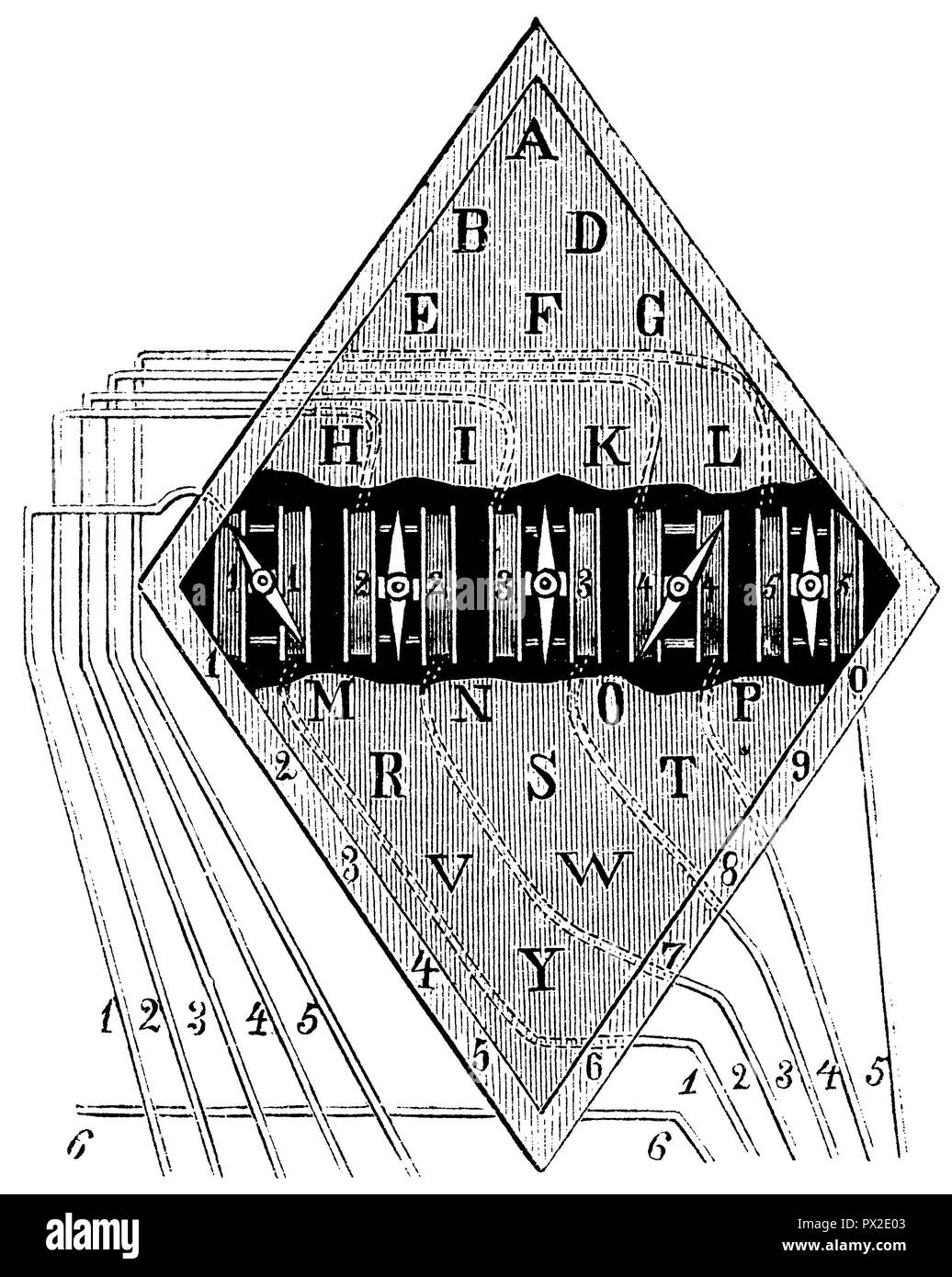 Five-needle telegraph from Cooke and Wheatstone, Stock Photohttps://www.alamy.com/image-license-details/?v=1https://www.alamy.com/five-needle-telegraph-from-cooke-and-wheatstone-image222560355.html
Five-needle telegraph from Cooke and Wheatstone, Stock Photohttps://www.alamy.com/image-license-details/?v=1https://www.alamy.com/five-needle-telegraph-from-cooke-and-wheatstone-image222560355.htmlRMPX2E03–Five-needle telegraph from Cooke and Wheatstone,
 Cooke & Wheatstone's double needle telegraph. The letters of the alphabet and a variety of conventional signals; were indicated by single and combined movements of the galvanometer needles. The operator worked the instrument by manipulating the two handles at the bottom and an alarm bell was housed in the upper casing and was used to signal the beginning of a message. Stock Photohttps://www.alamy.com/image-license-details/?v=1https://www.alamy.com/stock-photo-cooke-wheatstones-double-needle-telegraph-the-letters-of-the-alphabet-131278281.html
Cooke & Wheatstone's double needle telegraph. The letters of the alphabet and a variety of conventional signals; were indicated by single and combined movements of the galvanometer needles. The operator worked the instrument by manipulating the two handles at the bottom and an alarm bell was housed in the upper casing and was used to signal the beginning of a message. Stock Photohttps://www.alamy.com/image-license-details/?v=1https://www.alamy.com/stock-photo-cooke-wheatstones-double-needle-telegraph-the-letters-of-the-alphabet-131278281.htmlRMHHG6P1–Cooke & Wheatstone's double needle telegraph. The letters of the alphabet and a variety of conventional signals; were indicated by single and combined movements of the galvanometer needles. The operator worked the instrument by manipulating the two handles at the bottom and an alarm bell was housed in the upper casing and was used to signal the beginning of a message.
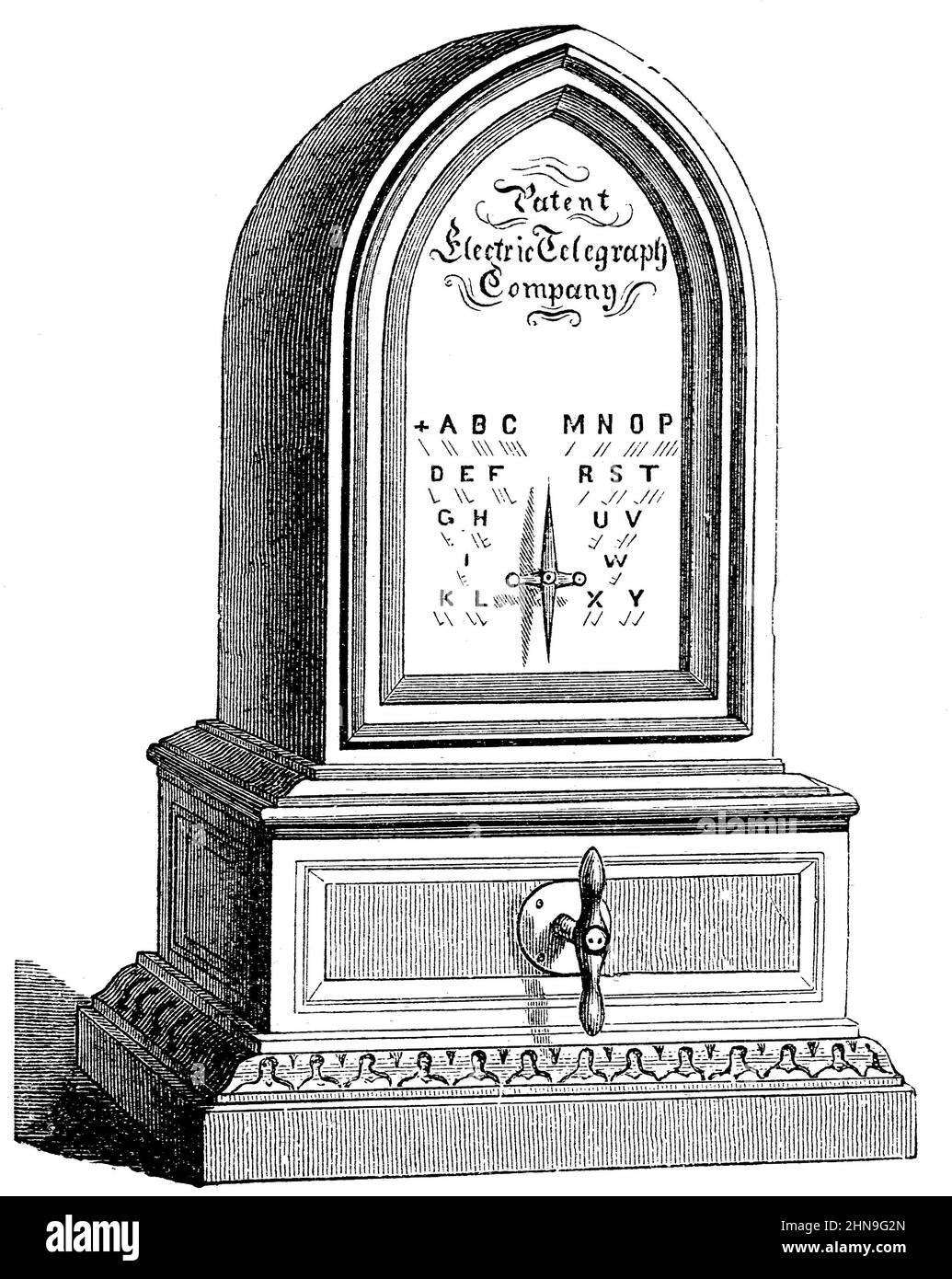 Nadeltelegraf mit einer einzigen Nadel, ein historischer Telegrafenapparat, welcher als gebrauchstaugliches Gerät 1837 von Charles Wheatstone und William Fothergill Cooke entwickelt / Single-needle telegraph, a historical telegraph apparatus developed as a serviceable device in 1837 by Charles Wheatstone and William Fothergill Cooke, Historisch, historical, digital improved reproduction of an original from the 19th century / digital restaurierte Reproduktion einer Originalvorlage aus dem 19. Jahrhundert, genaues Originaldatum nicht bekannt Stock Photohttps://www.alamy.com/image-license-details/?v=1https://www.alamy.com/nadeltelegraf-mit-einer-einzigen-nadel-ein-historischer-telegrafenapparat-welcher-als-gebrauchstaugliches-gert-1837-von-charles-wheatstone-und-william-fothergill-cooke-entwickelt-single-needle-telegraph-a-historical-telegraph-apparatus-developed-as-a-serviceable-device-in-1837-by-charles-wheatstone-and-william-fothergill-cooke-historisch-historical-digital-improved-reproduction-of-an-original-from-the-19th-century-digital-restaurierte-reproduktion-einer-originalvorlage-aus-dem-19-jahrhundert-genaues-originaldatum-nicht-bekannt-image460587533.html
Nadeltelegraf mit einer einzigen Nadel, ein historischer Telegrafenapparat, welcher als gebrauchstaugliches Gerät 1837 von Charles Wheatstone und William Fothergill Cooke entwickelt / Single-needle telegraph, a historical telegraph apparatus developed as a serviceable device in 1837 by Charles Wheatstone and William Fothergill Cooke, Historisch, historical, digital improved reproduction of an original from the 19th century / digital restaurierte Reproduktion einer Originalvorlage aus dem 19. Jahrhundert, genaues Originaldatum nicht bekannt Stock Photohttps://www.alamy.com/image-license-details/?v=1https://www.alamy.com/nadeltelegraf-mit-einer-einzigen-nadel-ein-historischer-telegrafenapparat-welcher-als-gebrauchstaugliches-gert-1837-von-charles-wheatstone-und-william-fothergill-cooke-entwickelt-single-needle-telegraph-a-historical-telegraph-apparatus-developed-as-a-serviceable-device-in-1837-by-charles-wheatstone-and-william-fothergill-cooke-historisch-historical-digital-improved-reproduction-of-an-original-from-the-19th-century-digital-restaurierte-reproduktion-einer-originalvorlage-aus-dem-19-jahrhundert-genaues-originaldatum-nicht-bekannt-image460587533.htmlRF2HN9G2N–Nadeltelegraf mit einer einzigen Nadel, ein historischer Telegrafenapparat, welcher als gebrauchstaugliches Gerät 1837 von Charles Wheatstone und William Fothergill Cooke entwickelt / Single-needle telegraph, a historical telegraph apparatus developed as a serviceable device in 1837 by Charles Wheatstone and William Fothergill Cooke, Historisch, historical, digital improved reproduction of an original from the 19th century / digital restaurierte Reproduktion einer Originalvorlage aus dem 19. Jahrhundert, genaues Originaldatum nicht bekannt
 Cooke & Wheatstone's double needle telegraph. The letters of the alphabet and a variety of conventional signals; were indicated by single and combined movements of the galvanometer needles. The operator worked the instrument by manipulating the two handles at the bottom and an alarm bell was housed in the upper casing and was used to signal the beginning of a message. Stock Photohttps://www.alamy.com/image-license-details/?v=1https://www.alamy.com/stock-photo-cooke-wheatstones-double-needle-telegraph-the-letters-of-the-alphabet-131278280.html
Cooke & Wheatstone's double needle telegraph. The letters of the alphabet and a variety of conventional signals; were indicated by single and combined movements of the galvanometer needles. The operator worked the instrument by manipulating the two handles at the bottom and an alarm bell was housed in the upper casing and was used to signal the beginning of a message. Stock Photohttps://www.alamy.com/image-license-details/?v=1https://www.alamy.com/stock-photo-cooke-wheatstones-double-needle-telegraph-the-letters-of-the-alphabet-131278280.htmlRMHHG6P0–Cooke & Wheatstone's double needle telegraph. The letters of the alphabet and a variety of conventional signals; were indicated by single and combined movements of the galvanometer needles. The operator worked the instrument by manipulating the two handles at the bottom and an alarm bell was housed in the upper casing and was used to signal the beginning of a message.
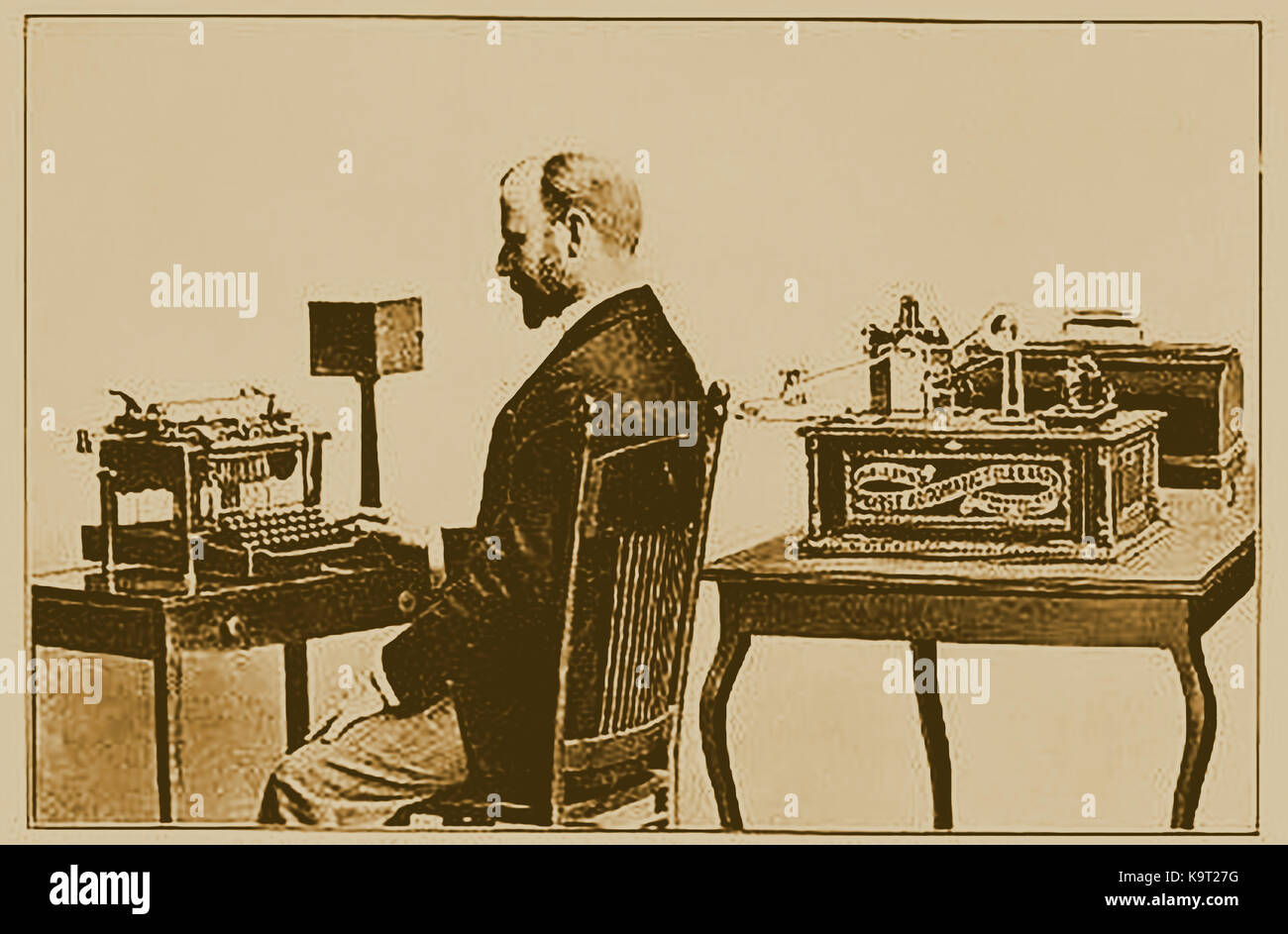 1897 - Telegraphy - A man using a self teaching kit and learning how to operate the new technological invention of the telegraph using a Remington keyboard Stock Photohttps://www.alamy.com/image-license-details/?v=1https://www.alamy.com/stock-image-1897-telegraphy-a-man-using-a-self-teaching-kit-and-learning-how-to-160953844.html
1897 - Telegraphy - A man using a self teaching kit and learning how to operate the new technological invention of the telegraph using a Remington keyboard Stock Photohttps://www.alamy.com/image-license-details/?v=1https://www.alamy.com/stock-image-1897-telegraphy-a-man-using-a-self-teaching-kit-and-learning-how-to-160953844.htmlRMK9T27G–1897 - Telegraphy - A man using a self teaching kit and learning how to operate the new technological invention of the telegraph using a Remington keyboard
 Charles Wheatstone (1802-1875) English physicist and inventor. Among his inventions were the English concertina, the stereoscope, and, with William Fothergill Cooke, an electric telegraph. Stock Photohttps://www.alamy.com/image-license-details/?v=1https://www.alamy.com/stock-photo-charles-wheatstone-1802-1875-english-physicist-and-inventor-among-57449229.html
Charles Wheatstone (1802-1875) English physicist and inventor. Among his inventions were the English concertina, the stereoscope, and, with William Fothergill Cooke, an electric telegraph. Stock Photohttps://www.alamy.com/image-license-details/?v=1https://www.alamy.com/stock-photo-charles-wheatstone-1802-1875-english-physicist-and-inventor-among-57449229.htmlRMD9D125–Charles Wheatstone (1802-1875) English physicist and inventor. Among his inventions were the English concertina, the stereoscope, and, with William Fothergill Cooke, an electric telegraph.
 Baltimore, Maryland, The USA - 24 May 1944: US historical envelope: cover with cachet 100th anniversary of the telegraph, 1844-1944, Electrical pole Stock Photohttps://www.alamy.com/image-license-details/?v=1https://www.alamy.com/baltimore-maryland-the-usa-24-may-1944-us-historical-envelope-cover-with-cachet-100th-anniversary-of-the-telegraph-1844-1944-electrical-pole-image353310931.html
Baltimore, Maryland, The USA - 24 May 1944: US historical envelope: cover with cachet 100th anniversary of the telegraph, 1844-1944, Electrical pole Stock Photohttps://www.alamy.com/image-license-details/?v=1https://www.alamy.com/baltimore-maryland-the-usa-24-may-1944-us-historical-envelope-cover-with-cachet-100th-anniversary-of-the-telegraph-1844-1944-electrical-pole-image353310931.htmlRF2BEPKKF–Baltimore, Maryland, The USA - 24 May 1944: US historical envelope: cover with cachet 100th anniversary of the telegraph, 1844-1944, Electrical pole
 Engraving depicting Charles Wheatstone's relay, which enabled the electric telegraph to be used over long distances. Charles Wheatstone (1802-1875) an English scientist and inventor. Dated 19th century Stock Photohttps://www.alamy.com/image-license-details/?v=1https://www.alamy.com/engraving-depicting-charles-wheatstones-relay-which-enabled-the-electric-telegraph-to-be-used-over-long-distances-charles-wheatstone-1802-1875-an-english-scientist-and-inventor-dated-19th-century-image186392878.html
Engraving depicting Charles Wheatstone's relay, which enabled the electric telegraph to be used over long distances. Charles Wheatstone (1802-1875) an English scientist and inventor. Dated 19th century Stock Photohttps://www.alamy.com/image-license-details/?v=1https://www.alamy.com/engraving-depicting-charles-wheatstones-relay-which-enabled-the-electric-telegraph-to-be-used-over-long-distances-charles-wheatstone-1802-1875-an-english-scientist-and-inventor-dated-19th-century-image186392878.htmlRMMR6X0E–Engraving depicting Charles Wheatstone's relay, which enabled the electric telegraph to be used over long distances. Charles Wheatstone (1802-1875) an English scientist and inventor. Dated 19th century
 EB1911 Telegraph Wheatstone Punching Apparatus Stock Photohttps://www.alamy.com/image-license-details/?v=1https://www.alamy.com/stock-image-eb1911-telegraph-wheatstone-punching-apparatus-162264997.html
EB1911 Telegraph Wheatstone Punching Apparatus Stock Photohttps://www.alamy.com/image-license-details/?v=1https://www.alamy.com/stock-image-eb1911-telegraph-wheatstone-punching-apparatus-162264997.htmlRMKBYPJD–EB1911 Telegraph Wheatstone Punching Apparatus
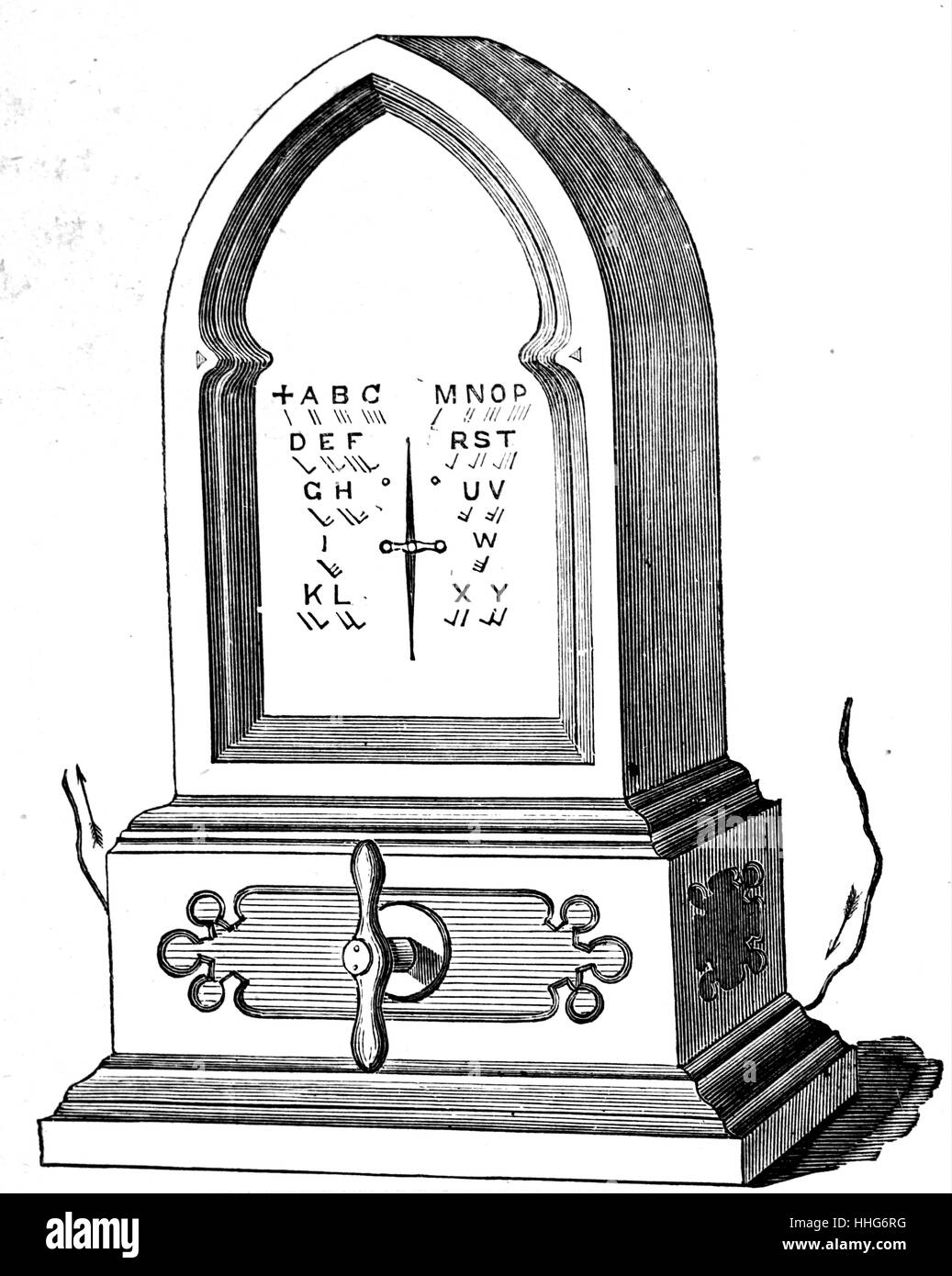 Front elevation of Cooke and Wheatstone's single needle telegraph. Stock Photohttps://www.alamy.com/image-license-details/?v=1https://www.alamy.com/stock-photo-front-elevation-of-cooke-and-wheatstones-single-needle-telegraph-131278324.html
Front elevation of Cooke and Wheatstone's single needle telegraph. Stock Photohttps://www.alamy.com/image-license-details/?v=1https://www.alamy.com/stock-photo-front-elevation-of-cooke-and-wheatstones-single-needle-telegraph-131278324.htmlRMHHG6RG–Front elevation of Cooke and Wheatstone's single needle telegraph.
 Interior room of the Electric Telegraph Office at Charing Cross, London. British telegraph equipment was based on the Cooke-Wheatstone patent, the clock-like devices along the walls, in which the receiver pointed to the letters on a dial, which spared operators the task of translating code. Stock Photohttps://www.alamy.com/image-license-details/?v=1https://www.alamy.com/stock-photo-interior-room-of-the-electric-telegraph-office-at-charing-cross-london-38133487.html
Interior room of the Electric Telegraph Office at Charing Cross, London. British telegraph equipment was based on the Cooke-Wheatstone patent, the clock-like devices along the walls, in which the receiver pointed to the letters on a dial, which spared operators the task of translating code. Stock Photohttps://www.alamy.com/image-license-details/?v=1https://www.alamy.com/stock-photo-interior-room-of-the-electric-telegraph-office-at-charing-cross-london-38133487.htmlRMC613J7–Interior room of the Electric Telegraph Office at Charing Cross, London. British telegraph equipment was based on the Cooke-Wheatstone patent, the clock-like devices along the walls, in which the receiver pointed to the letters on a dial, which spared operators the task of translating code.